
Old Tavern Signs
by Fritz Endell
This eBook is for the use of anyone anywhere at no cost and with almost no restrictions whatsoever. You may copy it, give it away or re-use it under the terms of the Project Gutenberg License included with this eBook or online at www.gutenberg.org
Title: Old Tavern Signs
An Excursion in the History of Hospitality
Author: Fritz August Gottfried Endell
Release Date: January 18, 2013 [eBook #41869]
Language: English
Character set encoding: UTF-8
***START OF THE PROJECT GUTENBERG EBOOK OLD TAVERN SIGNS***
| Note: | Images of the original pages are available through Internet Archive. See http://archive.org/details/oldtavernsignsex00enderich |

Old Tavern Signs
by Fritz Endell
Old Tavern Signs
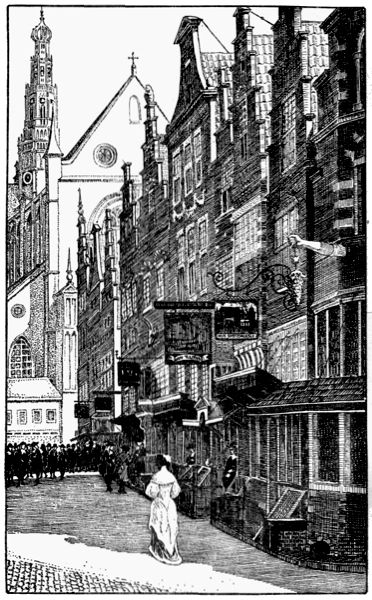
Old Dutch Signs
From a Painting by Gerrit and Job Berkheyden
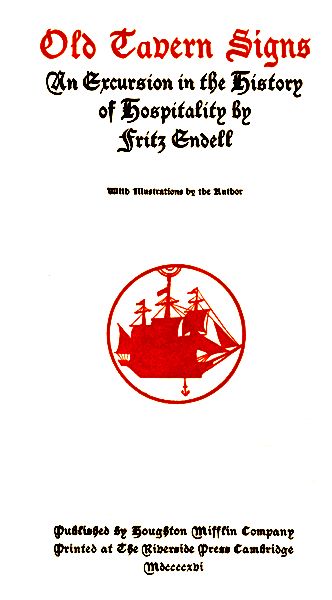
With Illustrations by the Author
Published by Houghton Mifflin Company
Printed at The Riverside Press Cambridge
Mdccccxvi
COPYRIGHT, 1916, BY HOUGHTON MIFFLIN COMPANY
ALL RIGHTS RESERVED
Published November 1916
THIS EDITION, PRINTED AT THE RIVERSIDE PRESS, CAMBRIDGE, CONSISTS OF FIVE HUNDRED AND FIFTY NUMBERED COPIES, OF WHICH FIVE HUNDRED ARE FOR SALE. THIS IS NUMBER 5
For a sign! as indeed man, with his singular imaginative faculties, can do little or nothing without signs.
The author’s love of the subject is his only apology for his bold undertaking. First it was the filigree quality and the beauty of the delicate tracery of the wrought-iron signs in the picturesque villages of southern Germany that attracted his attention; then their deep symbolic significance exerted its influence more and more over his mind, and tempted him at last to follow their history back until he could discover its multifarious relations to the thought and feeling of earlier generations.
For the shaping of the English text the author is greatly indebted to his American friends Mr. D. S. Muzzey, Mr. Emil Heinrich Richter, and Mr. Carleton Noyes.
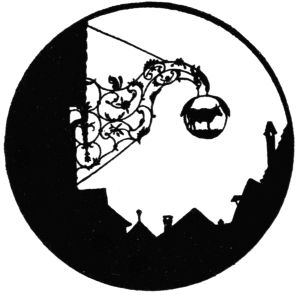
| I. | Hospitality and its Tokens | 1 |
| II. | Ancient Tavern Signs | 23 |
| III. | Ecclesiastical Hospitality and its Signs | 47 |
| IV. | Secular Hospitality: Knightly and Popular Signs | 75 |
| V. | Traveling with Shakespeare and Montaigne | 101 |
| VI. | Tavern Signs in Art—especially in Pictures by the Dutch Masters | 127 |
| VII. | Artists as Sign-Painters | 141 |
| VIII. | The Sign in Poetry | 167 |
| IX. | Political Signs | 187 |
| X. | Traveling with Goethe and Frederick the Great | 217 |
| XI. | The English Sign and its Peculiarities | 235 |
| XII. | The Enemies of the Sign and its End | 259 |
| Envoy: And the Moral? | 277 | |
| Bibliography | 291 | |
| Index | 297 |
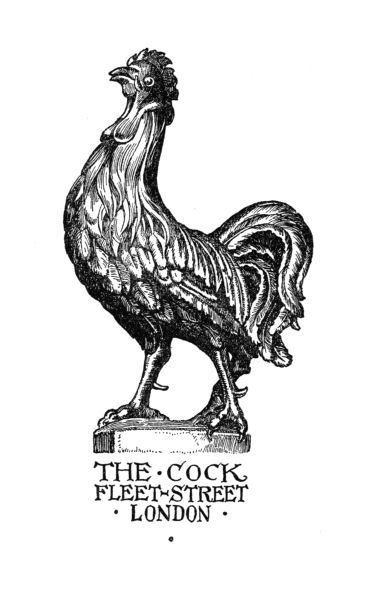
THE COCK FLEET-STREET LONDON
Without a question, the first journey that ever mortals made on this round earth was the unwilling flight of Adam and Eve from the Garden of Eden out into an empty world. Many of us who condemn this world as a vale of tears would gladly make the return journey into Paradise, picturing in bright colors the road that our first parents trod in bitterness and woe. Happy in a Paradise in which all the beauties of the first creation were spread before their eyes, where no enemies[Pg 4] lurked, and where even the wild beasts were faithful companions, Adam and Eve could not, with the least semblance of reason, plead as an excuse for traveling that constraint which springs from man’s inward unrest striving for the perfect haven of peace beyond the vicissitudes of his lot.
And as Adam and Eve went out, weak and friendless, into a strange world, so it was long before their poor descendants dared to leave their sheltering homes and fare forth into unknown and distant parts. Still, the bitter trials which the earliest travelers had to bear implanted in their hearts the seeds of a valor which has won the praise of all the spiritual leaders of men, from the Old Testament worthies, with their injunction “to care for the stranger within the gates,” to the divine words of the Nazarene: “I was a stranger, and ye took me in.... Verily I say unto you, Inasmuch as ye have done it unto one of the least of these my brethren, ye have done it unto me.”
Our first parents, naturally, could not enjoy the blessings of hospitality. And still, in later ages, they have not infrequently been depicted on signs which hosts have hung[Pg 5] out to proclaim a hospitality not gratuitous but hearty. So in one of Hogarth’s drawings, of the year 1750, “The March of the Guards towards Scotland,” which the artist himself later etched, and dedicated to Frederick the Great, we see Adam and Eve figuring on a tavern sign. No visitor to London[Pg 6] should fail to see this work of the English painter-satirist. One may see a copy of it, with other distinguished pictures, in the large hall of a foundling asylum established in 1739, especially for the merciful purpose of caring for illegitimate children in the cruel early years of their life. This hall, which is filled with valuable mementos of great men, like Händel, is open to visitors after church services on Sundays. And we would advise the tourist who is not dismayed by the thought of an hour’s sermon to attend the service. If he finds it difficult to follow the preacher in his theological flights, he has but to sit quiet and raise his eyes to the gallery, where a circlet of fresh child faces surrounds the stately heads of the precentor and the organist. At the end of the service let him not forget to glance into the dining-hall, where all the little folks are seated at the long fairy tables, with a clear green leaf of lettuce in each tiny plate, and each rosy face buried in a mug of gleaming milk. This picture will be dearer to him in memory than many a canvas of noted masters in the National Gallery.
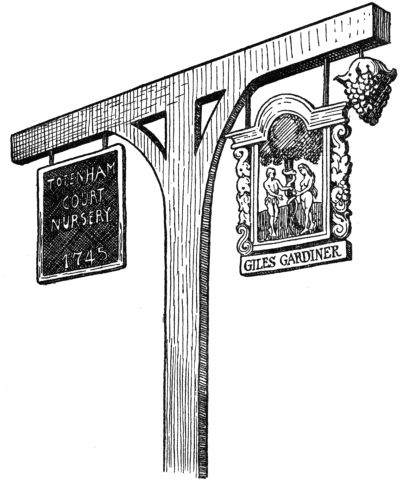
The present-day tourist who takes the bus[Pg 7] out Finchley Road to hunt up the old sign will be as sorely disappointed as if he expected to find the “Angel” shield in Islington or the quaint “Elephant and Castle” sign in South London. Almost all the old London signs have vanished out of the streets, and only a few of them have taken refuge in the dark sub-basement of the Guildhall Museum, where they lead a right pitiable existence, dreaming of the better days when they hung glistening in the happy sunshine. There were “Adam and Eve” taverns in London, in “Little Britain,” and in Kensington High Street. In other countries, France and Switzerland, for example, they were called “Paradise” signs. A last feeble echo of the old Paradise sign lingers in the inscription over a fashion shop in modern Paris, “Au Paradis des Dames,” the woman’s paradise, in which are sold, it must be said, only articles for which Eve in Paradise had no use.
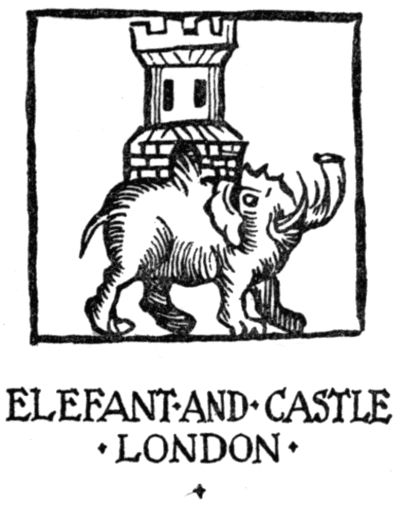
ELEFANT·AND·CASTLE·LONDON·
Gavarni, who spoke the bitter phrase, “Partout Dieu n’est et n’a été que l’enseigne d’une boutique,” made bold in one of his lithographs of “Scènes de la vie intime” (1837) to inscribe over the gates of Paradise, from which the “tenants” were flying: “Au pommier sans pareil.” Schiller tells us that the world loves to smirch shining things and bring down the lofty to the dust. This need not deter us from reading in the old Paradise signs a reminder of the journey of our first parents, and to enjoy thankfully the blessings of ordered hospitality to-day.
Until this ordered hospitality prevailed, however, many centuries had to elapse, and for the long interval every man who ventured out into the hostile wilderness resembled Carlyle’s traveler, “overtaken by Night and its tempests and rain deluges, but refusing to pause; who is wetted to the bone, and does not care further for rain. A traveler grown familiar with howling solitudes, aware that the storm winds do not pity, that Darkness is the dead earth’s shadow.” Only the strong and bold could dare to defy wild nature, especially when there was need to cross desolate places, inhospitable[Pg 9] mountains like the Alps. So the ancients celebrated Hercules as a hero, because he was the pioneer who made a road through their rough mountain world.
A still longer time had to elapse ere the traveler could rejoice in the beauties of nature which surrounded him. The civilizing work of insuring safe highways had to be done before what Macaulay names “the sense of the wilder beauties of nature” could be developed. “It was not till roads had been cut out of the rocks, till bridges had been flung over the courses of the rivulets, till inns had succeeded to dens of robbers ... that strangers could be enchanted by the blue dimples of the lakes and by the rainbow which overhung the waterfalls, and could derive a solemn pleasure even from the clouds and tempests which lowered on the mountain-tops.”
No wonder, then, that the literature of olden times, when traveling was so dangerous an occupation, is filled with admonitions to hospitality. The finest example of it, perhaps, is preserved in the Bible story of the visit of the angels to Abraham, and later to Lot. This story deserves to be read again[Pg 10] and again as the typical account of hospitality. As is the custom to speak in the most modest terms of a meal to which one invites a guest, calling it “a bite” or “a cup of tea,” so Abraham spoke to the angels, “I will fetch a morsel of bread, and comfort ye your hearts.” Then Abraham told his wife to bake a great loaf, while he himself went out to kill a fatted calf and bring butter and milk. In like fashion Lot extends his hospitality, providing the strangers with water to refresh their tired feet, and in the night even risking his life against the attacking Sodomites, to protect the guests who have come for shelter beneath his roof.
The feeling that a guest might be a divine messenger, nay, even Deity itself, continued into the New Testament times, as St. Paul’s advice to the Hebrews shows: “Be not forgetful to entertain strangers, for thereby some have entertained angels unawares.” And did not the disciples, too, at times, receive their Master as a guest in their homes, the Son of Man, the Son of God? William Allen Knight has dwelt on this thought very beautifully in his little book called “Peter in the Firelight”: “The people of Capernaum slept[Pg 11] that night with glowings of peace lighting their dreams. But in no house where loved ones freed from pain were sleeping was there gladness like in Simon’s; for the Master himself was sleeping there.”
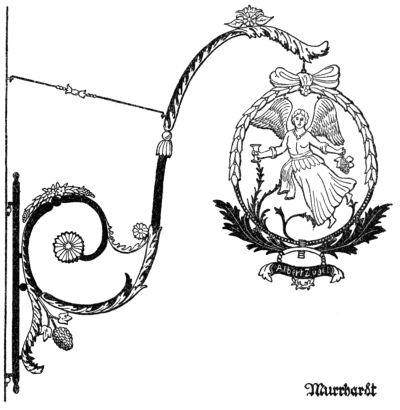
Murrhardt
A later type of legend pictures the angels, not as guests, but as benefactors, preparing a wonderful meal for starving monks who in their charity have given away all their possessions to the poor, and have no bread to[Pg 12] eat. The tourist, walking through the seemingly endless galleries of the Louvre, will pause a moment before the beautiful canvas on which Murillo has depicted this story. The French call it “la cuisine des anges.” It is a historical fact that many cloisters were reduced to poverty in the Middle Ages on account of their generous almsgiving. Not all of them could lay claim to the holy Diego of Murillo’s painting, who could pray with such perfect trust in Him who feeds the sparrows that angels came down from heaven into the cloister kitchen to prepare the meal. The widespread popularity of these Biblical stories and holy legends need cause no wonder that the angel was a favorite subject for tavern signs in the Middle Ages, and that even at this day he takes so many an old inn under the patronage of his benevolent wings. It has been asserted that the angel sign originated in the age of the Reformation, simply by leaving out the figure of the Virgin Mary from the portrayal of the scene of the Annunciation. But against this theory stands the fact that there were simple angel signs in the Middle Ages as well as Annunciation signs. We learn that the students of Paris in[Pg 13] the year 1380 assembled for their revels in the tavern “in angelo.” The records of these same Parisian students tell us how they lingered over their cups in the tavern “in duobus angelis,” in the year of grace 1449.
We may remark here in passing that the linen drapers’ guild in London had as its escutcheon the three angels of Abraham. One need only to recall the full, flowing garments of Botticelli’s angels to understand in what great respect the linen merchant would hold the angels as good customers of the drapery trade.
An angel in beggar’s form brought St. Julian the good news of the pardon of the sins of his youth. In a wild fit of anger the headstrong young Julian had killed his parents. As atonement for his dreadful crime he had done penance and built a refuge in which for many long years he freely cared for all travelers who came his way. At last the angel’s reward of hospitality was vouchsafed to him, and in memory of his good works tavern-keepers chose him as their patron saint.
The stern Consistory of Geneva had evidently forgotten all these beautiful legends[Pg 14] and their deep symbolical meaning, when in the year 1647 it forbade a tavern-keeper to hang out an angel sign, “ce qui est non accoutumé en cette ville et scandaleux.” Perhaps the grave city fathers of Geneva remembered their by-gone student days in Paris, and the handsome angel hostess in the city on the Seine, where a contemporary of Louis XIV celebrated in song:—
The most attractive angel tavern that the author has met in his travels is in the quiet little English town of Grantham, although he has to confess, in the words of the German song:—
It was a sharp autumn day. The wind that whistled about the lofty cathedral of Lincoln had searched us to the marrow, and we were well content after our ride from the station to find a kindly welcome at the “Angel.” The façade of the dignified tavern, which once belonged to the Knights’ Templars,[Pg 15] and which saw the royal guests, King John in 1213, and King Richard III in 1483, entertained within its walls, is one of the most splendid architectural monuments that we saw in England. As everywhere in this garden-land, the ivy winds its green arms around the stiffer forms of the English Gothic, which often lack the warm picturesqueness of architectural detail that makes the wonderful charm of the French and the South German Gothic.
Over the lintel of the door of the tavern the sculptured angel shone resplendent in his golden glory. A charming little balcony rested on his wings and his hands held out a crown of hospitable welcome to royal and common guests alike. All these winged messengers of hospitality seem to say in the words of the Old Testament: “The stranger that dwelleth with you shall be unto you as one born among you, and thou shalt love him as thyself: for ye were strangers in the land of Egypt.”
The bitter experience of their own distress in a strange land planted in the hearts of the Israelitish people a kindly feeling toward the stranger. For all that, much was[Pg 16] permitted in dealing with a stranger which was forbidden in the case of a brother Israelite. The stranger might be made to pay interest, and it was no infraction of the Mosaic Law to make him and his children men-servants and maidservants.
While, then, the law of the exclusive Jews accorded certain rights to the stranger which the children of Israel were warned not to impair, the Græco-Roman world, on the other hand, recognized no claim of the stranger. “Il n’y a jamais de droit pour l’étranger,” says Fustel de Coulanges in “La Cité antique.” The same word in Latin means originally both enemy and stranger. “Hostilis facies” in Virgil, means the face of a stranger. To avoid all chance of encountering the sight of a stranger while performing his sacred office, the Pontifex performed the sacrifice with veiled face. In spite of this, the stranger met with favorable consideration both at Athens and at Rome, in case he was rich and distinguished. Commercial interests welcomed his arrival and bestowed on him the “jus commercii”—(the right to engage in trade). Yet he came wholly within the protection of the laws[Pg 17] only when he chose one of the citizens as his “patron.”
It seems as if it must have been embarrassing in those days to have shown one’s “hostilis facies” in foreign lands and cities in the course of a journey undertaken for pleasure or to seek the cures at the bathing resorts. Still we know that the Romans, in their enthusiasm for this kind of travel, built villas, theaters, temples, and baths at some of the most celebrated watering-places of modern days, like Nice and Wiesbaden.
The stiff and almost hostile attitude of classical antiquity toward the stranger was relieved by the hospitable custom which made the stranger almost a member of the family as soon as he had been received at the family hearth and had partaken of the family meal. This function was a sacred one among the ancients, for they believed that the gods were present at their table: “Et mensæ credere adesse deos,” says Ovid in the “Fastes.”
At especially festal meals it was the custom to crown the head with wreaths, as in the case of the public meals, where chosen delegates of the city, clad in white, met to partake of the food which was the symbol[Pg 18] of their common life of citizenship; or in the case of the bridal meals, where the maiden, veiled in white, pledged herself forever to the bridegroom. There was no rich wedding-cake, like those common in England and America, but a simple loaf, “panis farreus,” which after the common prayer they ate in common “under the eyes of the family gods.” “So,” says Plato, “the gods themselves lead the wife to the home of her husband.”
The custom of wearing a crown at solemn feasts was founded on the ancient belief that it was well pleasing to the gods. “If thou performest thy sacrifice [and the meal was a sacrifice] without the wreath upon thy head, the gods will turn from thee,” says a fragment from Sappho. The sense of the nearness of the gods at mealtime and the beautiful old custom of pouring out a bit of wine for the invisible holy guest, were preserved down to the time of the later Romans. We find the custom in vogue with such old sinners as Horace and Juvenal. We shall recall the significance of the wreath as a symbol when we meet the ivy wreath later as a tavern sign.
But even in classical antiquity the exercise of free hospitality demanded certain tokens to preserve it from abuse at the hands of fraudulent strangers. For example, the so-called “tessera hospitalis,” a tiny object in the shape of a ram’s head or a fish, was split in halves and shared by each party to the agreement of hospitality. By presenting his half of the “tessera” the stranger could always prove his identity and his claims to a hospitable reception by the family to which he came.
Other tokens were small ivory or metal hands carved with appropriate inscriptions. The latter were also sometimes exchanged on the negotiation of treaties between nations. In the medallion cabinet at Paris there is one of these treaty-hands in bronze, commemorating a treaty between the Gallic tribe of the Velavii and a Greek colony—probably Marseilles. This hand of hospitality, like the wreath, was a frequent motive in the development of the tavern sign. In fact, it was so frequent in the German lands that the people were accustomed to call the tavern, in figurative speech, the “place where the good God stretched out his hands.” If we recall[Pg 20] the deep symbolic meaning of such signs, we shall not find this naïve expression of the people shocking, like the Puritan Consistory at Geneva, whose narrow-minded prohibition of the angel sign we have already noticed.
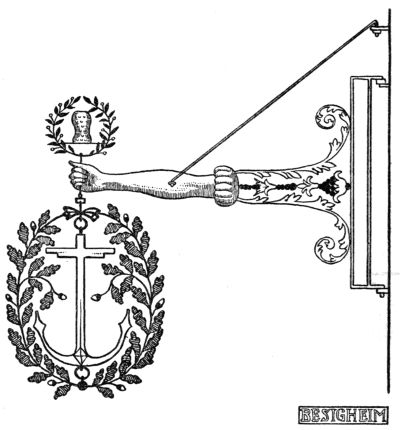
BESIGHEIM
Now, before passing to the study of the origins of entertainment for pay, with its signs (which were really the first tavern signs) let us turn back to the old Germans, to note[Pg 21] their idea of hospitality. The German fathers, too, tell in a beautiful story of the reception of a divine guest in the cottage of a mortal, and of a reward like that which Abraham had for his spirit of friendly aid. In one of the religious songs of the “Edda,” which probably originated in the North-Scottish islands, we read how the god Heimdall, in the disguise of a humble traveler, visited the hut of an aged couple, and was honorably received by them:—
In the sayings of Hars (i.e., of Odin) the Lofty, the rule of hospitality is stated:—
So even the old Germans had felt the blessings of hospitality, and received the angel’s reward. An old poet expressed it in a simple phrase:—
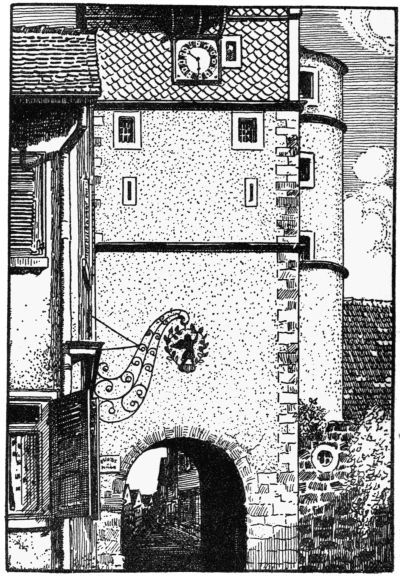
Engel Winnenden, Württemberg
We must now take leave of “holy hospitality” which is written in the hearts of men and truly needs no outward sign, and must follow Iago’s counsel: “Put money in thy purse!” For our journey is no longer from friend to friend, but from host to host and from sign to sign. Regret it as we may, a hospitality for profit’s sake had to succeed the old free hospitality of friends. The widening commerce of the Roman world-empire could hardly have existed without a well-regulated business of entertainment along those magnificent roads by which the empire was bound together. The traveler was more and more unlikely, with every extension of the area of his far journeyings, to find houses to which he was bound by the friendly ties of genuine hospitality; while he[Pg 26] who remained quietly by his own fireside (“qui sedet post fornacem”) would find the constantly increasing duties of the voluntary host growing to be so great a burden that he would be relieved to see the establishment of public inns. Indeed, he may himself, at first, have sought relief by charging his guests a nominal sum to defray their expense. At any rate, it would be very difficult to fix an exact line between these two forms of entertainment, which existed side by side for long ages of antiquity. Certain it is that at some moment, we know not just when, there appeared the Pompeian inscription over the tavern door: “Hospitium hic locatur.” (Hospitality for hire.) That was the birth-hour of the tavern sign.
We cannot hide the fact that the beginnings of business hospitality were of a very unedifying character, under the plague of Mammon. In Jewish and Gentile society alike they must have been closely akin to that kind of hospitality against whose smooth speech and Egyptian luxury the wise old Solomon warned foolish youth in his Proverbs. Witness the identical word in Hebrew to denote a courtesan and a tavern hostess; witness[Pg 27] Plato’s exclusion of the tavern-keeper from his ideal republic; witness the reluctance of the respectable Greek and Roman to enter a tavern. In the Berlin collection of antiques there is a stone relief which has been pronounced an old Roman tavern sign. On it the “Quattuor sorores,” or four sisters, are represented as frivolous women. And there are charges entered on old Roman tavern bills which could not possibly appear on a hotel bill to-day. Both the rich and the poor were imbued with the spirit of Horace’s words:—
This spirit reveals itself in a dance of death, which decorated the beautiful silver tankards found in Boscoreale, a Pompeian suburb. And so we must not be surprised to see later, during the Middle Ages, even on tavern signs the grim figure of Death; as for example, on the French tavern, “La Mort qui trompe.”
The magnificent frescoes of the rich in Pompeian art show us a palatial feasting-hall[Pg 28] with the inscription, “Facite vobis suaviter” (Enjoy your life here); and at the same time the tavern guests for a few pennies woo the philosophy of “carpe diem”—the careless abandonment to pleasure that knows no concern for the morrow. Another inscription found in Pompeii makes the tavern Hebe say: “For an as [penny] I give you good wine; for a double as, still better wine; for four ases, the famed Falerian wine of song.” To be sure, the wine was often pretty bad in these greasy inns—Horace’s “uncta popina.” One guest relieved his mind of his complaint by writing on the chamber wall: “O mine host, you sell the doctored wine, but the undiluted you drink yourself.” On the same wall, which seems to have served as a kind of “guest-book” (“libro dei forestieri”) are the names of many guests, one of whom complains in touching phrase that he is sleeping far away from his beloved wife for whom he yearns: “urbanam suam desiderabat.”
In spite of the contempt which ancient writers all manifest for these wine-shops and inns, we remark that men of the senatorial order, like Cicero, did not scorn at times to[Pg 29] stop for a few hours on their summer journey at some country inn like the “Three Taverns,” in the neighborhood of Rome, to call for a letter or to write one. This was the same “Tres Tabernæ” to which the Roman Christians went out to meet the Apostle Paul, to welcome him with brotherly greetings after the trials of his Christian Odyssey. We read in the Acts of the Apostles how great his joy was when he saw them, and how “he thanked God and took courage.” He had no need, however, of the tavern. The hospitality of Christian fraternity, which he had praised so beautifully in his message to the Roman community, now received him with open arms.
The very name “tavern,” which in its Latin original means a small wooden house built of “tabulæ,” or blocks, indicates the very modest origins of professional hospitality. And we must distinguish, in the olden times as in the Middle Ages, between hospitality proper, which takes the guest in overnight, and the mere charity which refreshes him with food and drink and sends him on his way.
The original sign of the tavern-keeper is[Pg 30] the wreath of ivy with which Bacchus and his companions are crowned, and which twines around the Bacchante’s thyrsos staff. As the ivy is evergreen, so is Bacchus ever young (“juvenis semper”), Shakespeare’s “eternal boy.” As the ivy winds its closely clinging vine around all things, so Bacchus enmeshes the senses of men. Thus the custom grew of crowning the wine-jars with ivy, a custom which Matthias Claudius, in his famous Rhine wine song, has described thus:—
Now, whether a good wine really needed the recommendation of the wreath was a question on which experts were not agreed. In general, the ancients leaned to the opinion that “good wine needs no bush”—“Vino vendibili suspensa hedera non opus est.” The French later expressed the same idea in their proverb, “À bon vin point d’enseigne”; though La Fontaine seems to have been of a different mind when he said, “L’enseigne fait la chalandise.” And Shakespeare[Pg 31] enters the controversy in his epilogue to “As You Like It,” when he makes Rosalind say, “If it be true that good wine needs no bush, ’tis true that a good play needs no epilogue.” An English humorist, George Greenfield of Henfield (whoever he may be), is fully of the opinion that there is no need of the bush: “No, certainly not,” says he; “all that is wanted is a corkscrew and a clean glass or two.”
It is perfectly natural that gloomy and distrustful natures like Schopenhauer’s should have no confidence in the sign. He uses the word “sign” always as a synonym for deceit. He calls academic chairs “tavern signs of wisdom”; and illuminations, bands, processions, cheers, and the like, “tavern signs of joy”—“whereas real joy is generally absent, having declined to attend the feast.” Wieland shows the same mistrust in his verses of Amadis:—
On the other hand, happy optimistic natures like Fischart’s, the author of the famous “Ship of Fools” (“Narrenschiff”), and perhaps of its jolly woodcuts as well, give full[Pg 32] credence to a handsome sign. “How shall you think,” says he, “that poor wine can go with so brave a sign displayed, or that so neat an inn can harbor a slovenly host or guest?”
We can see what an important business the making of wreaths was in ancient times by the place which the Amorettes, who were engaged in this work, had in the favorite Pompeian wall frescoes, which portray Cupids in varied activities. We look into the workshop where a small winged figure is working industrially twining garlands; or into the sale-shop where a tiny Psyche is asking the price of a wreath. The winged saleslady answers her in the finger language which the Italians still use: “Since it is you, pretty maiden, only two ases.”
A very favorite tavern sign in the later times also dates from high
antiquity, namely, the pentagram, triangles intersecting so as to make
this figure
![]() .
The Pythagoreans held this as a
talisman of health and protection. The Northern myths called the sign
a footprint of a swan-footed animal. They called it the “Drudenfuss,”
and thought it would protect men against evil spirits like the[Pg 33]
“Trude,” a female devil-nixie which harassed sleepers. We see the sign
in the study-scene in the first part of “Faust”; and remark how evil
spirits and the devil himself could slip into human habitations if the
pentagram before the door was not fully closed at the apexes—but had
a hard time getting out again. The elfish verses are well known:—
.
The Pythagoreans held this as a
talisman of health and protection. The Northern myths called the sign
a footprint of a swan-footed animal. They called it the “Drudenfuss,”
and thought it would protect men against evil spirits like the[Pg 33]
“Trude,” a female devil-nixie which harassed sleepers. We see the sign
in the study-scene in the first part of “Faust”; and remark how evil
spirits and the devil himself could slip into human habitations if the
pentagram before the door was not fully closed at the apexes—but had
a hard time getting out again. The elfish verses are well known:—
“Mephistopheles: I must confess it! just a little thing Prevents my getting out beyond the threshold: That is the Drudenfuss before the door.
“Faust: Ah, then the pentagram is in thy way! So tell me then, abandoned son of Hell, If that can stop thee how thou camest in; Can such a spirit be so tricked and caught!
“Mephistopheles: Look closely! It is badly drawn: one angle, The one that’s pointing outward, is not closed.
“Faust: Ah, that’s a lucky fall of fortune then; It makes thee willy-nilly captive here.”
Besides wreath and pentagram, we find among the ancients a third customary sign of hospitality, namely, a chessboard, which invited the passer-by to a game of draughts along with a draught of wine. The game was not chess, for that came to Europe from the East in the post-classical age. Hogarth’s[Pg 34] engraving “Beerstreet” shows us that this sign prevailed in old England, for the characteristic signpost in front of the tavern door is painted in black and white checkered squares.
Painted and carved animal images also served as signs in Roman times. We have a few examples left, and the names of a great many more. In Pompeii there was a little inn called the “Elephant,” in which one could rent a dining-room with three couches and all modern comforts (“cum commodis omnibus”). The sign represents an elephant, around whose body a serpent is entwined, and to whose defense a dwarf is running. It was an animal scene on an old sign that inspired Phædron with his fable of the battle of the rats and the weasels; so the author tells us at the opening of his poem: “Historia quorum et in tabernis pingitur.” Perhaps the host of the “Elephant” had an ancestor in the African wars, and in his honor chose the African animal as a sign; just as the host of the “Cock,” in the Roman Forum, hung out for a sign a Cimbric shield captured in the old wars against Germania. On the shield he had painted a stately rooster[Pg 35] with the inscription: “Imago galli in scuto Cimbrico picta.” The choice of the elephant, however, might be due simply to the preference which tavern-keepers showed for strange and wonderful beasts. For the traveler would first stop and stare at the queer animal, and then, like as not, turn in at the door, half expecting that the wily host might be harboring the very beast in real life. There was a grand elephant sign on a Strassburg tavern, which invited to a hospitable table the young students of the town, especially the law students—among them a young man named Goethe. The elephant stood erect on his hind legs, and the toast of the students was: “à l’élève en droit” (à l’éléphant droit).
Among other figures of animals on Roman signs the eagle was a great favorite. The Romans bore the eagle on their standards, after having long accorded the honor to the she-wolf, the minotaur, and the wild boar. The Corinthians likewise carried a Pegasus, and the Athenians an owl, on their banners. The sign was closely related to the banner: it was a kind of rigid flag. We shall see later, in the Dutch pictures, how, at the jolly kermess,[Pg 36] flag and shield together invited the peasant to drink and dance. In mediæval France the tavern hosts hung out flags on which the sign was painted or woven in colors. The French word “enseigne” means originally a flag: “Le signe militaire sous lequel se rangent les soldats,” as the classic definition in Diderot’s famous Encyclopédie runs. A secondary definition is: “Le petit tableau pendu à une boutique.”
The Romans seldom had signs that hung free, such as the Cimbric shield described above. Generally their signs were paintings or reliefs on a wall. There were in the shops of Pompeii depressions in the wall made especially to receive these signs. So, too, the so-called “dealbator” whitewashed a place on the wall for the election bulletins. Sometimes the painter used wood or glass as the ground for his sign.
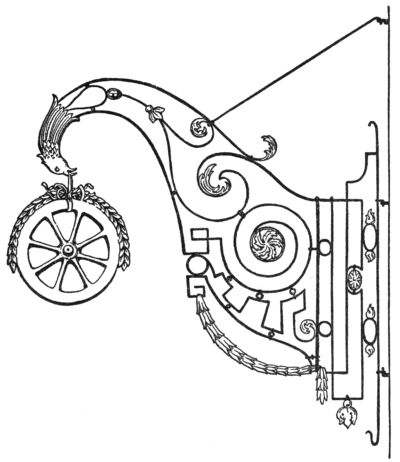
We find all the Roman animal signs—storks, bears, dragons, as well as the eagle, the cock, and the elephant—in the later Christian ages. It is not impossible that the eagle signs of later days are the direct descendants of the old Roman eagle; and they probably existed in most of the old towns[Pg 37] founded by the Romans—Mayence, Speyer, Worms, Basel, Constance. The names that have come down to us are chiefly of taverns in the African colonies. Here we find, curiously enough, the wheel (“ad rotam”), the symbol of St. Catherine, which we shall meet later in Christian lands; for example,[Pg 38] in a picturesque sign in the old town of Ravensburg in Württemberg.

Zumwilden Mann Eßlingen
In Spain we find the Moor (“ad Maurum”) who kept his popularity for centuries. In Sardinia, Hercules, the pattern of the later hero with the “big stick,” as he appears in the German sign at Esslingen. Some of the inns had names of heathen divinities, like Diana, or Mercury, the god of commerce, or Apollo, whose emblem the sun shed its inviting rays from so many a tavern[Pg 39] portal in fair and foul weather alike. A tavern in Lyons was named “Ad Mercurium et Apollinem”: “Mercurius hic lucrum permittit, Apollo salutem” (“Here Mercury dispenses prosperity, and Apollo health”). It is possible that these taverns had gods as signs, just as in the Middle Ages the streets abounded in images of the Madonna and saints, which invited the traveler to turn in for profit or pleasure. Tertullian tells us that there was not a public bath or tavern without its image of a god: “balnea et stabula sine idolo non sunt.” After the victory of Christianity the images of the gods were cheap: tavern-keepers could buy them for a few obols. We can little doubt that among this “rubbish” was many a precious work of art which the museums of to-day would be proud to own.
It would be hard to say whether an unbroken tradition connects the signs of the Middle Ages with those of like name in classical antiquity. Many a sign may have been invented anew. But that we have learned much directly from the old Romans in the field of hospitality is proved by a curious fact. The Bavarian Knödel, which every[Pg 40] true Bajuware claims as an indigenous, national institution, are prepared to-day exactly like the old Roman “globuli,” after the recipes of Columella and Varro. Such, at least, is the assurance of Herr von Liebenau in his interesting book on Swiss hospitality.
We remarked above that it was by their roads especially that the Romans extended their power over all the world. We must notice now briefly the Roman post-system, the “cursus publicus,” whose coaches probably carried travelers from tavern to tavern like the modern mail-coaches. We must, however, curb the imagination of the reader with a reminder that practically only the state officials used this service. Not every country bumpkin could mount with market-basket on his arm, to make a jolly journey over hill and dale to the sound of the echoing horn. Still the Emperor or his prefect could issue tickets to private persons; and furthermore, these persons could, under certain circumstances, get a sort of Cook’s ticket, called “diploma tractoria,” which included board and lodging as well as transportation. If the journey lay through a lonely region, where there were no private taverns to provide[Pg 41] shelter for the night, the traveler might put up at the state inn (“mansio”) which the province was obliged to maintain at public cost, with all the necessities and comforts to which respectable Roman travelers were accustomed. One can well understand how, as the empire disintegrated, the provincials were glad to throw off this hated compulsory tax for the support of the state inn. It was not till the time of Charlemagne that the institution was revived as a military-feudal service along the routes of the imperial army. Whether these Roman state inns displayed signs or not, we do not know. It is, however, very likely that they were distinguished by the sign of the Roman eagle, and so became the type of the later private eagle inns.
Here let us remark that the post-coaches of our own day, which seem to us an institution dating from the Deluge, are a comparatively late invention. The first so-called “land-coach” in Germany was established between Ulm and Heidelberg in the year 1683. Through all the Middle Ages and the Renaissance period, we depended on mounted messengers, traveling cloister brothers, university[Pg 42] students, and rare travelers to carry messages. In Württemberg, where we find to-day the most abundant reminders of the good old post-coach days, and consequently the finest old signs, bands of “noble post-boys” are found, including the distinguished names of Trotha and Hutten.
That the common workman, even in the Roman days, had to use “shank’s mare” when he went traveling goes without saying. But the well-to-do burgher or trader who had no license to ride in the state post-coach rode on his horse or his high mule. Horse and saddle remained for centuries the only method of travel after the Roman roads had fallen into that state of dilapidation from which they fully recovered only in the days of Napoleon. One needs only to look at the coaches of princes in past centuries to see for what bottomless mud-bogs these lumbering vehicles were built. Montaigne rode on horseback from his home in Bordeaux to the baths of southern France and Italy, although he seems, from the entries in his diary, to have been very much afflicted with “distempers.”
A late Roman relief found in Isernia (in[Pg 43] Samnium)—a kind of tavern sign—shows us a traveler holding his mule by the bridle as he takes leave of the hostess and pays his account. The traveler has on his cloak and hood. The hood, even up to Seume’s time (i.e., up to the end of the eighteenth century), was generally worn by travelers in Italy, and especially in Sicily: “My mule-driver showed a tender solicitude for me,” wrote Seume, “and gave me his hood. He could not understand how I dared to travel without one. This peculiar kind of dark-brown mantle with its pointed headgear is the standard dress in all Italy, and especially in Sicily. I took a great fancy to it, and if I may judge[Pg 44] from this night’s experience, I have a great inclination toward Capuchin vows, for I slept very well.”
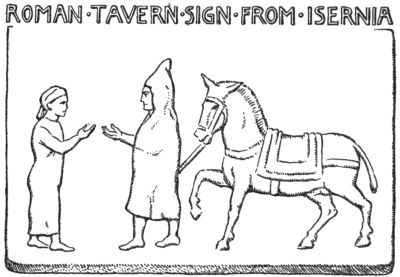
ROMAN·TAVERN·SIGN·FROM·ISERNIA
We have had to confine ourselves in the treatment of ancient signs entirely to Roman examples, for we have very little knowledge of Greek signs. In fact, the tavern sign seems to have come late into Greece, through Roman influence. We hear of a tavern “The Camel” at the Piræus, also of a sailors’ inn having the sign in relief: a boiled calf’s head and four calf’s feet.
We shall later see what an important part signs played in directing travelers in a city through the Middle Ages and even in modern times. They took the place of house numbers and street names. In ancient Rome a whole quarter was often named after an inn, like the “Bear in the Cap” (“vicus ursi pileati”). This is the longest-lived bear in history: he lives even to-day. An excellent German tavern guide, Hans Barth, writes in his delightful little book “Osteria”: “On the quay of the Tiber was the famous old inn of the Bear, where Charlemagne lodged, because the Cafarelli Palace was not yet built; where Father Dante frolicked with the [Pg 45]pussy-cats; where Master Rabelais raised his famous bumpers of wine.” In Montaigne’s time the Bear was so frightfully stylish an inn, with its rooms hung with gilded leather, that the essayist stayed there only two days and then forthwith sought a private lodging.
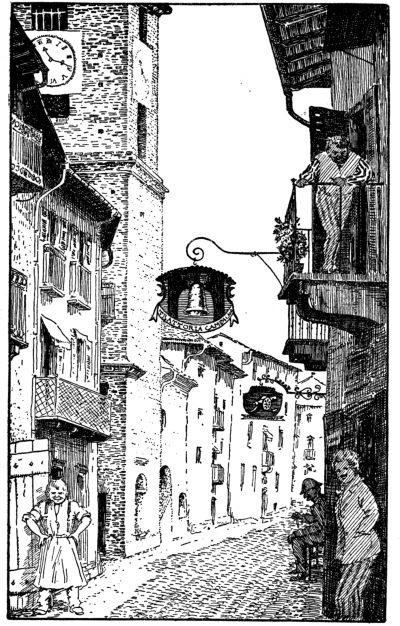
Campana and Canone d’Oro
Borgo San Dalmazzo, Italy
In modern Italy there are only a few interesting signs. The most delightful ones (the Golden Cannon, and the Bell) we found in the main street of the North Italian mountain town of Borgo San Dalmazzo. The “White Horse” (“cavallo bianco”) was a little off the main street. The form of these was probably influenced by the proximity of Switzerland—a country very rich in beautiful signs.
Seume, who had the finest opportunity for studying taverns and signs in his walking tour from Leipzig to Syracuse, often mentions the name of his inn; as, for instance, “Hell” in Imola, or the “Elephant” in Catania. But there was only one Italian town in which the signs impressed him: that was Lodi. “The people of Lodi,” he writes, “must be very imaginative if one can judge them from their signs. One of them, over a shoemaker’s shop, represents a Genius taking[Pg 46] a man’s measure—a motif which reminds one of Pompeii.”
Our excellent guide, who has an eye for everything picturesque, does not seem to have met much of interest from Verona to Capri. An exception was the “Osteria del Penello,” in Florence, on the Piazza San Martino, a tavern established about the year 1500 by Albertinelli, the friend of Raphael. On the sign over the door was the jolly curly head of the founder, who, when the envy of his colleagues poisoned the work of his brush, here established a tavern. An inscription read: “Once I painted flesh and blood, and earned only contempt; now I give flesh and blood, and all men praise my good wine.”
Barth also mentions, by the way, the characteristic wall-paintings of Italy that rest on the old Roman tradition and yet serve as tavern signs, like the “Three Madonnas” of the Porta Pincia in Rome: “A portal decorated with three pictures of the Mother of God leads into the green garden court.”
Lest the thought of a religious painting serving as a tavern sign should shock any of our readers, we hasten to turn to the study of religious hospitality and its emblems.
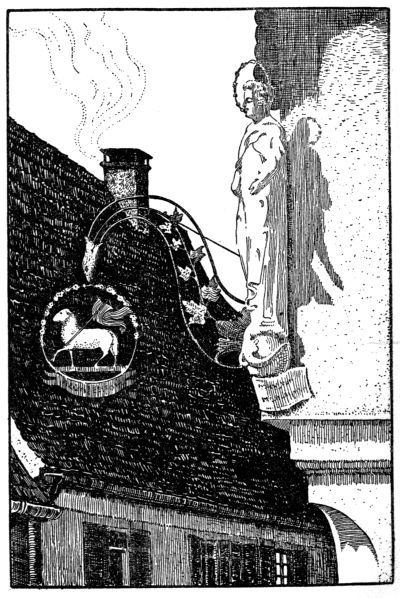
Lamm Erlenbach, Württemberg
Rome was to conquer the northern Germanic world once more, not with the sword as had been the case in the olden days of a pagan Rome, but with the cross and its exponent, the monk. The northward surging wave of Roman Cæsarism had been followed by the tidal wave, southward-roaring, of Germanic barbarians. The orderly life of one vast empire gave way to the restlessness and insecurity of the period of migration and a shattered empire. Not individuals but whole peoples go a-traveling with household goods and wife and children, whole towns and countries become their inns, the standard of the conquerors are their tavern signs. Then again flowing northward, progressing by insensible stages, comes the silent throng of monastic brotherhoods, the Benedictines in the van, who bring forth various orders from[Pg 50] their midst, the Cistercians among others, who dig and reclaim the soil with their spades and later, as builders, dedicate it to their God, unknown and now revealed, with high-soaring monuments of worship.
Undaunted by solitude, fearless of the wildness of desolate regions, they enter the forest primeval to clear it and establish quiet homesteads for themselves and their worship; their doors are open to all those who pass their way. For had not St. Benedict, mindful of repeated apostolic admonitions to the bishops, included hospitality in the rules of his order? Therefore ere long there lacked not in any convent certain rooms given over to the comfort of the wayfarer, be it a “hospitium,” a “hospitale,” or a “receptaculum.” Witness the Hospice of the Great St. Bernard in the Alps of the Vallais, named after the pious founder of that earliest of Occidental orders, part of the convent erected in the ninth century by the bishops of Lausanne, while the shelter on Mont Cenis is said to date back to a past equally remote. Beginning with the year 1000, convents likewise erect inns in the villages, outside of their immediate domains, leasing these[Pg 51] against rental, while in the towns pilgrim inns, poor men’s taverns, and “Seelhäuser” are endowed for the free housing of pilgrims and wayfarers, evolving later into town inns.
To the pilgrim, then, who wended his way to the tombs of saints, and, in the crusade times, to the holiest of graves in Jerusalem, mediæval hospitality is mainly devoted. The crusaders were agents of especial power in the development of hospitality, since on his lengthy journey the pilgrim stood in need, not only of food and shelter, but also of convoy along roads perilous everywhere. The Knights of St. John set themselves these two tasks, to care for the pilgrims and escort them in safety, which is implied by their name “fratres hospitales S. Johannis.” In the rule of their order (ca. 1118) the foremost duty of lay as well as clerical brothers was to serve the poor, “our lords.” With like intent of safeguarding pilgrims the Order of Knights Templars was instituted in 1119, especially for the care of German pilgrims. We may venture to assume from their name, “Order of the German House of our dear Lady in Jerusalem,” that a homelike[Pg 52] Madonna picture adorned their hospitable house as a pious welcome. Shakespeare has inimitably described the warlike duties of these orders, duties which went hand in hand with kindly care and hospitality, in the first part of “Henry IV”:—
These knightly orders, whose hospitable roofs originally sheltered the pious pilgrims bound for Jerusalem, also opened in welcome the gates of their proud houses at home, which still adorn more than one old German town. When Luther was summoned to Worms by the Emperor, in 1521, he stayed with the Knights of St. John. Here in this noble inn he exclaimed to his friends, after the ordeal, with upraised arms, and face shining with joy: “I am through, I am through.” Like an enduring rock he had stood his ground and had expressed his unalterable will to be a free Christian in those famous words: “Hier stehe ich, ich kann nicht anders, Gott helfe mir! Amen.”
In like manner Luther had accepted ecclesiastical[Pg 53] hospitality on his journey Romeward, as a young monk, notably on the part of the Order of St. Augustine. From the pages of that Baedeker of the fifteenth century, the “Mirabilia Romæ,” we can realize how thoroughly a pilgrimage to Rome was viewed in those days as a pious journey to hallowed places, relics and tombs of the saints. The work referred to appeared first as a block-book, with pictures and text both printed from the same wood block. The youthful monk may well have carried such an early copy of the “Mirabilia” in his cowl when he entered the holy precincts of the Eternal City, which revealed itself to his great disillusionment as an ungodly spot and the seat of Anti-Christ. Occasionally we also see the great reformer descending at a lay tavern, such as the famous inn of the High Lily in Erfurt, which subsequently saw within its walls great warriors like Maurice of Saxony and Gustavus Adolphus.
To this day there is in England a hospital founded by the Knights of St. John, in which every wayfarer can obtain bread and ale upon request. This is the “Hospital of St. Cross without the walls of Winchester,” as it is[Pg 54] called in a document in the British Museum; ceded by the Knights Hospitallers of St. John of Jerusalem to Richard Toclive, Bishop of Winchester, in 1185, the bishop raising the number of poor there entertained from 113 to 213, of whom 200 were to be fed and 13 fed and clothed. Emerson once made a pilgrimage to the hospital, claimed and received the victuals, and triumphantly quoted the incident as a proof of the majestic stabilities of English institutions. In his wake numberless Americans yearly wend their way to the Hospital of the Holy Cross, and to the beautiful Minster of Winchester embedded in verdure. There they lodge either at the “George,” or, more cozily yet, in the ancient “God begot House” of a type found, perhaps, in England only.
Another American no less renowned, Mark Twain, the “New Pilgrim,” as he styled himself, has felt on his own physical self the blessings of clerical hospitality in Palestine, the land of ecclesiastic foundations, which he celebrates as follows in his “Innocents Abroad”: “I have been educated to enmity toward all that is Catholic, and sometimes, in consequence of this, I find[Pg 55] it much easier to discover Catholic faults than Catholic merits. But there is one thing I feel no disposition to overlook, and no disposition to forget: and that is, the honest gratitude I and all pilgrims owe to the Convent Fathers in Palestine. Their doors are always open, and there is always a welcome for any worthy man who comes, whether he comes in rags or clad in purple.... A pilgrim without money, whether he be a Protestant or a Catholic, can travel the length and breadth of Palestine, and in the midst of her desert wastes find wholesome food and a clean bed every night, in these buildings.... Our party, pilgrims and all, will always be ready and always willing to touch glasses and drink health, prosperity, and long life to the Convent Fathers in Palestine.”
We may well believe that private individuals then as now bid for the patronage of pilgrims. Shakespeare tells us of a case in point, in his “All’s Well that Ends Well” (Act iii, Sc. v). Helena appears in Florence in search of her husband gone to the wars, “clad in the dress of a pilgrim,” and inquires where the palmers lodge. A kindly widow tells her “at the Franciscans here[Pg 56] near the port”; but knows how to win the fair pilgrim by her words:—
If, on the other hand, we consider how pilgrims made their long journey more toilsome yet, as related by Helena herself,—
we shall appreciate how gratefully the proffer of the good widow must have been accepted. The hospitality of the monks was not always lavish; on the contrary, it proved scant and poor, as Germany’s greatest troubadour, Walter von der Vogelweide, to his sorrow experienced. Once he turned aside more than four miles from his road in order to visit the far-famed convent of Tegernsee. The learned monks, whose library forms to-day one of the treasures of the State Library in Munich, may have been too deeply engrossed in the transcription of a classic author, or in elaborate miniature paintings; at any rate, they did not realize what noble guest sat at their board and brought him—[Pg 57]not the choice vintage which the thirsty poet expected but simply water:—
If guests were thus given cause for complaints of their treatment by the convents, the monks on their side had no less ground for occasional displeasure at the abuse of their hospitality. Carlyle cites an instance of this kind in “Past and Present”; the excellent abbot, Simon of Edmundsbury, had forbidden tournaments within his domain. In spite of this prohibition twenty-four young nobles arranged a knightly joust under his very nose, so to speak. Not content with that, they rode gayly to the convent at its conclusion and demanded supper and a night’s lodging. “Here is modesty,” says Carlyle. “Our Lord Abbot, being instructed of it, orders the Gates to be closed; the whole party shut in. The morrow was the vigil of the Apostles Peter and Paul; no out-gate on the morrow. Giving their promise not to depart without permission, those four-and-twenty young bloods dieted all that day with the Lord Abbot waiting for trial on the[Pg 58] morrow.” And now Carlyle cites his own source the “Jocelini Chronica”: But “after dinner”—mark it, posterity!—“the Lord Abbot retiring into his Talamus, they all started up, and began carolling and singing; sending into the Town for wine; drinking and afterwards howling (ululantes);—totally depriving the Abbot and Convent of their afternoon’s nap; doing all this in derision of the Lord Abbot, and spending in such fashion the whole day till evening, nor would they desist at the Lord Abbot’s order! Night coming on, they broke the bolts of the Town-Gates, and went off by violence!”
Not only had convents to suffer from such exuberant guests; oftener far they were burdened by those who forgot to depart and continue their journey. The abbot, Herboldus Gutegotus of Murrhardt, the convent whose romantic church still ranks among the finest ecclesiastical monuments in Germany, used to tell such forgetful guests the following little story: “Do you know why our Lord remained but three days in his tomb?—Because during that time he was making a friendly visit to the patriarchs and prophets in Paradise. So in order not to[Pg 59] cause them inconvenience he took timely leave and resurrected upon the third day.” Evidently the refined abbot knew how to veil politely the old Germanic directness which finds such clear expression in the “Edda”:
In wild and inhospitable countries, the convents long remained, even till recent times, the only shelters for travelers. Hence, when Henry VIII of England began to confiscate monastic property on a grand scale, a significant revolt for their reinstallment flamed up in the north of England,—the so-called “Pilgrimage of Grace” of the year 1536, which was suppressed with deplorable sternness. The convents were very popular in those parts because the monks had been the only physicians and their doors were always open to all wayfarers.
Chaucer shows us in his “Canterbury Tales” that monks could be pleasant guests as well as good hosts, for there we read in regard to the friar: “He knew well the tavernes in every town”; and “What should he studie and make himself wood?”
Having thus pictured to ourselves the clerical hospitality of the Middle Ages, we shall not wonder that, in outward signs for the designation of the houses as inns, religious subjects and their pictorial presentation were adopted.
Among the saints particularly revered by the pious pilgrims St. Christopher stands foremost, since he had himself experienced so perilous a journey. In many mediæval pictures we see him leaning on his massive staff, carrying the Christ child across a river. The “Golden Legend” tells us that he was nearly drowned, so heavy was the burden of this child. “Had I carried the whole world,” he says, when finally reaching the shore, “my burden could have been no heavier”; whereupon the child of whose identity he was not yet aware: “for a sign that you have carried on your shoulders not only the world but the Creator, thrust this staff into the ground near your hut, and behold, it will blossom and bear fruit.” Hence the partiality for huge pictures of St. Christopher, visible afar, such as we find occasionally to this day in and upon certain churches; for instance, the spacious mural paintings in the church of[Pg 61] St. Alexander at Marbach, the birthplace of Schiller, close to the tracks on which the modern traveler thunders past; or the gigantic sculpture on the south side of the cathedral in Amiens, or the large fresco in the minster at Erfurt. They give us a conception of similar presentations on Poor Men’s Inns and ecclesiastical hospices. The belief in the efficacious protection by the saint, especially from sudden death, is expressed in the French mediæval saying: “Qui verra Saint Christophe le matin, rira le soir.” The tenacity of this belief among the people is well instanced by the fact that the jewelers of so worldly a city as Nice sell to owners of automobiles little silver plaques, with the picture of the saint and the inscription, “Regarde St. Christophe et puis va-t-en rassuré.” Let us hope, in the interest of the rest of mankind, that these motorists do not feel too reassured in consequence.
American readers might be interested to hear that in their own country a guest-house of St. Christopher gives refuge to the modern fraternity of tramps, charitably called the “Brother Christophers” by the Friars of the Atonement, who founded this house[Pg 62] at Gray Moor, near the beautiful residential district of Garrison, in the State of New York.
Another saint, deservedly in great favor, is St. George, who slew the dragon, a knightly patron who smooths the traveler’s path and makes it safe by brushing aside all its threatening dangers. Two of the finest hostelries still existing are named after him: the “Ritter” in Heidelberg, and the “George,” more ancient yet by a century, in the time-hallowed town of Glastonbury. Two miracles have drawn pilgrims to the latter place since olden times, the “Holy Thornbush,” which had blossomed forth from the staff of Joseph of Arimathea and bloomed every Christmas, and the “Holy Well,” in the garden of the cloister school, now deserted, whose waters were to heal the bodily ailments of the pious pilgrims. The throng of wayfarers to the convent, whose gigantic abbot’s kitchen is eloquent of hospitality on a large scale, made the establishment of a pilgrim’s inn outside the walls imperative. First they erected the “Abbot’s Inn,” and when this proved insufficient—at the end of the fifteenth century—the elegant Gothic structure was erected,[Pg 63] which bears to this day the ensign “Pilgrim’s Inn,” but is popularly known as “The George,” from a likeness of the saint which once adorned the handsome bracket so happily wedded to the architecture of the house. The tourist undaunted by fearsome reminiscences may ask to be given the choice apartment there, the so-called “abbot’s chamber,” where Henry VIII rested on the day when he ordered the last abbot hung on the town gate. The fine four-poster, it is true, has been sold to a fancier of antiquities and replaced by a new canopied bed, but despite this the room retains its mediæval appearance.
About a hundred years later, the delightful Renaissance structure, “Zum Ritter,” was erected in Heidelberg. Originally the house of a wealthy Frenchman, it was subsequently changed into a hostelry and took its name from the knight on the peak of the gable. Doubtless no one has ever sung the praise of this noble building more worthily than Victor Hugo, who visited Heidelberg in 1838, and passed by the house of St. George every morning, as he said, “pour faire déjeuner mon esprit.” Jokingly he[Pg 64] observes that the Latin inscription (Psalm 127, i) has protected the inn better than the little iron plate of the insurance firm. As a matter of fact neither the great conflagration of 1635, during the Thirty Years’ War, nor the fires started under Mélac and Maréchal de Lorges, in 1689 and 1693, could harm this inn, while “all the other houses built without the Lord were burnt to the ground.”
In England the good knight St. George was an especial favorite; even in the middle of the last century there were in London alone no less than sixty-six hostelries of that name. Truly, the pious meaning of old associated with the sign had long been forgotten by hosts and guests alike, so that as early as the seventeenth century these mocking lines were penned:—
The pictures of the “valiant knight’s” mount were often so dubious that a connoisseur of horses like Field Marshal Moltke, writing from Kösen, Thuringia, construed it as the[Pg 65] picture of a mad dog. On the other hand, we have such charming conceptions of St. George as the sign here shown, from the hamlet of Degerloch, delightfully situated on the heights overlooking Stuttgart, a notable artistic achievement in wrought iron, interesting, moreover, for the associations of merry chase linked with the saint in the mind of the country folk.

Degerloch
Among other saints frequently chosen for tavern signs, St. Martin must be mentioned. At times he appears in like manner as does[Pg 66] St. Christopher; for instance, on the large reliefs decorating the façade of the minster in Basle: a friend of the needy, dividing his cloak with his sword, to share it with them; thus the pious saint lives on in the minds of the people. At the season of the new wine, the 21st of November, the Church commemorates his name: “A la saint Martin, faut goûter le vin,” is the French saying.
At the sign of St. Dominic too, whose meaning of religious hospitality had been utterly perverted in the course of time, stanch topers used to congregate for joyous orgies. Proudly they called themselves “Dominican”; and
is their interpretation of such strange affiliation, in a song of the seventeenth century.
St. Urban has likewise figured on many a tavern sign. Once upon a time he took refuge from his pursuers behind a grapevine, and for that reason he has become a patron saint of vintners and tavern hosts. “Alas,” exclaims the refined Erasmus of Rotterdam, “mine host is not always as ‘urbane’ as he should be to justify this patronage.”
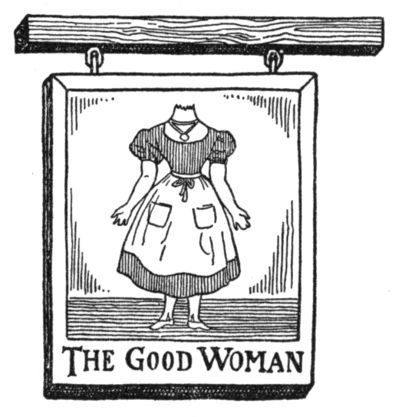
The Good Woman
There is one sign whose religious origin is not self-evident, namely, the “Femme sans tête.” Yet the figure has its origin, no doubt, in mediæval representations of saints after decapitation, sometimes shown with the head in the hands. Whoever has perused the illustrated “Lives of the Saints” with their many horrible mutilations of the martyrs depicted in woodcuts, must have realized that their moral influence on the popular imagination cannot have been of a beneficial nature. Even great artists did not hesitate to celebrate such awful scenes with the power of their genius. Among the drawings of Dürer we see the executioner with his great sword ready to behead St. Catherine. Nothing so disgusted Goethe in his Italian journey as all the painted atrocities perpetrated on the martyrs. The most peculiar[Pg 68] example of this form of art is probably that in the Tower of London. It is a set of horse armor presented, apparently without malice, by Emperor Maximilian to Henry VIII of England, embellished with the most gruesome scenes of martyrdom. In the Tower, where so much innocent blood has flowed, one feels doubly repulsed by such excrescences of so-called religious art: one is even tempted to accept the popular conception of these beheaded saints as comforting symbols of forgetfulness. In fact, the oil merchants chose the “woman without head” as their sign, as one of the foolish virgins of the parable who had neglected to provide themselves in good time with the necessary oil: a warning example to delaying, unwilling customers.
A coarser interpretation of the figure styles it as the “silent woman,” or as the “good woman,” who can no longer do mischief with her tongue. Moreover, one finds this most gallant of signs—which should be unmentionable in these days of woman’s emancipation—not only in outspoken Holland, with the words: “Goede vrouw een mannen plaag” but also in Italy; in Turin, for[Pg 69] instance, styled as “La buona moglie.” The most polite people on earth—I do not mean the Chinese, but the French—have named a street in Paris the “Rue de la Femme sans Tête” after a tavern of like appellation. Young Gavarni stayed awhile in the “Auberge de la Femme sans Tête” in Bayonne, as the Goncourts tell us, and waxed eloquent about the dainty charms of the “vierge du cabaret,” the tavern-keeper’s daughter.
Ben Jonson, who loved to discuss with Shakespeare in the Siren Club and to “anatomize the times deformity,” may have been stimulated to write his comedy “The Silent Woman” by the tavern sign of that name. In Jonson’s play, a Mr. Morose, an original old fellow, who holds all noise in detestation, weds a young lady, whose barely audible voice and scant replies have charmed him. When after the ceremony she reveals herself a loquacious scold and he gives vent to his disappointment, she replies with these endearing words: “Why, did you think you had married a statue, or a motion only? one of the French puppets, with the eyes turned with a wire? or some innocent out of the hospital that would stand with her hands[Pg 70] thus, and a plaise mouth, and look upon you?”
But to comfort the feminists we should speak of a host truly gallant, who had a great white sign made, with the inscription below, “The Good Man.” To the universal inquiry, “Where is the good man? I can’t see him,” he made answer, “Well, you see that is why I have left the blank space; if only I could find him.”
Since there is a saint for every day of the calendar, we must not be astonished to find names among those adopted for tavern signs which to us bear no relation to sanctity; such as St. Fiacre over a drivers’ bar, which seems rather the invention of some wag.
We must needs realize that all these religious signs have their origin in a time when popular imagination was mainly filled with the happenings of the Bible and the legends of the saints; when religion had not yet grown to be a Sunday occupation of a couple of hours, but was most intimately interwoven with the life of every day. Hence we find among subjects for signs not the saints only, whose human errors and sufferings have riveted a bond between them and the common[Pg 71] people, but also the Deity itself. “La Trinité” was one of the latter in mediæval France, as evidenced by this passage in the song of a pilgrim:—
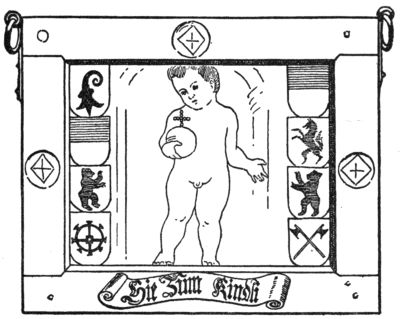
Hie Zum Kindli
Other pilgrim taverns styled themselves “A l’image du Christ.” We also meet with such inscriptions as “L’Humanité de Jesus Christ, notre sauveur divin”; the birth of Christ as a child, as in the charming old Swiss sign “Hie zum Christkindli”; the Madonna[Pg 72] and scenes of her life like the “Annunciation,” called Salutation in England. These and many other signs, such as “Purgatory,” “Hell,” and “Paradise,” which have been revived in modern Paris on fantastic cabarets, meet our eyes on tavern signs. An old enumeration of London bars of the seventeenth century begins with the words:—
And when the author tires of mentioning them all by name, he concludes with:—
Finally, we must turn to those signs, not religious at first sight, which may well have their origin in attributes of the saints. Thus, we meet in Swiss towns, which have St. Gall as their local patron, with the sign of the “Bear”; “Crown” and “Star” are the symbols of the three magi who followed the star to the lowly tavern in Bethlehem; the “Wheel” reminds us of the martyrdom of St. Catherine; the “Stag” may be a reminder[Pg 73] of the legend of St. Hubert; while the “Bell,” once used by St. Anthony to drive away the demons by its sound, was fastened on the neck of animals to preserve them from epidemic diseases. We often see the bell, in old woodcuts, fastened round the neck of the little pig which accompanies the saint. The bell assumed a very worldly meaning, when it called the tipplers to their merry gatherings, which called forth in England the patriotic rhyme:—
The Tower of St. Barbara grew into an independent tavern sign, which, misunderstood, occasionally changed into a cage. Even the platter on which rested the head of the Baptist is deformed into the “Plat d’argent” over a tavern door. Hogarth does not refrain from introducing a sign in his engraving “Noon,” of 1738, showing the Baptist’s head on a charger, with the cynical inscription “Good Eating.” Whether such coarsenesses were actually perpetrated, even under the lax régime of Charles II[Pg 74] in England, when frivolity reigned after the fall of Cromwell, it is hard to decide. Possibly they may be set down as brutal outcroppings of the satirist’s truth-deforming brain. The fact is, that even in the sixteenth century the abuse of religious subjects for the most disreputable resorts roused the indignation of serious, thinking men. Thus a certain Artus Désiré indignantly laments, in a rhymed broadside, that the tavern-keepers dare place over houses where the great hell devil himself is lodged the images of God and the saints to advertise their vine:—
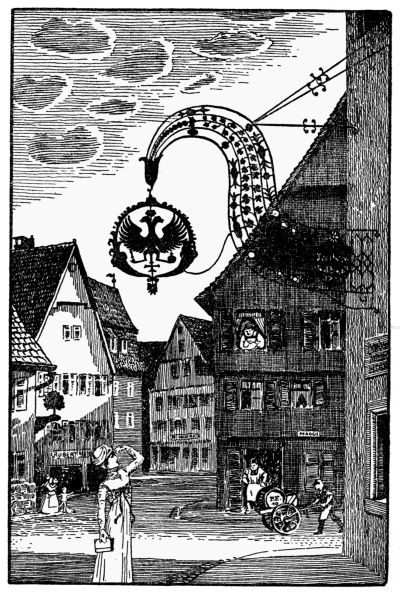
Adler Leonberg, Württemberg
The heavy castle gates in mediæval times were gladly opened to the minstrels who came to charm with their art the banquets of the noble lords and ladies—troubadours and minstrels, the ancestors of that vast and still thriving fraternity of poets whose blood runs too quickly through their veins to keep them content in the quiet monotony of a home. With the sailing clouds, with the migrating birds, and the rising sun they wander through woods and fields “to be like their mother the wandering world.” With Walt Whitman they love the open road and hate the confinement of the stuffy room:—
Never do they feel happier than when the long, long road lies before them, which now seems to dip down into the green sea of the forests and now to climb straight into the bright blue heaven. Jean Richepin, himself a “chemineau,” now well settled as an honorable member of the French Academy, has sung the open road’s praise. All poets feel deeply the words of Kleist, “Life is a journey.” And how bitter the journey often was in the days of the minstrels, how glad they were when the dark forests and unsafe roads lay behind them and the big hearth-fire of the castle hall brightened face and soul! Gratefully they praised the noble lord for his hospitable reception and his kindly welcome. Thus Walter von der Vogelweide, Germany’s greatest minstrel:—
Impoverished knights may have occasionally hung out an iron helmet over the castle door as a sign that they were willing to receive and to entertain paying guests: certainly[Pg 79] a more honorable method of gaining one’s livelihood than to plunder the passing merchant or even one’s own peasants, as was the noble fashion at the end of mediæval times. But it is more likely that such poor noblemen would first think of using their city houses for such commercial purposes and not their lonely and uninviting fortified castles. Here on one of their city houses, where they used to lodge in time of markets or city festivities, the first iron helmet perhaps appeared as a knightly sign. Certain it is that we find inns of such name in France as well as in Germany, the most famous one in Rothenburg on the Tauber, the best preserved mediæval city in existence, infinitely more charming than the much-talked-about Carcassonne, reconstructed by Viollet-le-Duc with such cold correctness. Here in the quaint hall of the “Eisenhut,” under the glittering arms of knights dead and gone, we will rest awhile and gladden our heart with the golden Tauber wine. Let the comfort-seeker go to the modern prosaic hotel outside the city wall!
The iron helmet is not the only martial tavern sign. Other names sounded equally[Pg 80] well to the soldier’s ear: in France “Le Haubert” (iron shirt), for instance, that might remind us of the old English inn, “The Tabard,” in which Chaucer gathered his joyous pilgrims for happy meals and amusing conversations; the sword, St. Peter’s attribute, was used as tavern sign in his holy city Rome in the sixteenth century (“alla spada”); the cannon was very popular as “canone d’oro” in northern Italy; and many others.
Like chicks under the wings of the hen, the little huts of the villagers cluster around the protecting mountain castle of the knightly lord. Most naturally the village innkeeper, therefore, chooses his master’s escutcheon as a tavern sign. And the landlord in the town feels equally honored when noble guests leave him, as parting presents, their coats of arms neatly painted on the panels or the windows of the dining-room as Montaigne informs us: “Les Alemans sont fort amoureux d’armoiries; car en tous les logis, il en est une miliasse que les passans jantilshomes du païs y laissent par les parois, et toutes leurs vitres en sont fournies.” Although a philosopher Montaigne himself was vain enough[Pg 81] to follow the pretty custom, and occasionally to dedicate his escutcheon to the innkeeper as a sign of his satisfaction; so in “The Angel” at Plombières, already a popular resort even in his day, and in Augsburg at “The Linde,” situated near the palace of the rich Fuggers. Like a good housekeeper, who daily writes his expenses down, he tells us that the painter, who did his work very well, received “deux escus” or two dollars, the carpenter “vint solds” or a whole quarter, for the screen on which the escutcheon was painted and which was placed before the big green stove.
The painting of heraldic designs goes back to the time of the crusaders and soon became the principal source of income of the painters. In the Netherlands, which grew to be such a wonderful hotbed of art, the sign-painters were called “Schilderer,” for that same reason, a name which clings to them to the present day. Whoever has traveled in England knows that the same custom of the nobility, to give coats of arms to the landlords, prevailed there too. “Mol’s Coffee House” in Exeter, close to the beautiful cathedral, is a good example. Here Sir[Pg 82] Walter Raleigh used to sit in the paneled room on the second floor, drink a cup of the beverage then quite rare, and chat with his friends. All along the walls the escutcheons of the noble visitors of days gone by decorate the quaint old room and every modern visitor admires them duly, especially that of the valiant but unhappy seafarer.
To come back to the heraldic tavern signs, we find everywhere in German lands, where once the imperial House of Hapsburg ruled, their coat of arms, the double eagle, and in the domains of the House of Savoy and the Dukes of Lorraine, the cross. In France the escutcheon of the Bourbons, the fleur de lys, hangs over the tavern door, and in England the white horse of the royal House of Hanover. Long before the Georges, the white horse was a popular symbol in England. The giant horse, roughly hewn in the chalk of the “White Horse Hill,” near Faringdon, still reminds us of Alfred the Great’s victory over the Danes at Ashdown in 871. In our days the noble white horse has been degraded into an advertisement for Scotch whiskey—O quæ mutatio rerum!
The heraldic meaning of the signs was[Pg 83] just as quickly forgotten as was the pious significance of the religious signs. Only a few notable animals, such as lions, unicorns, and the like interested the tavern habitués.
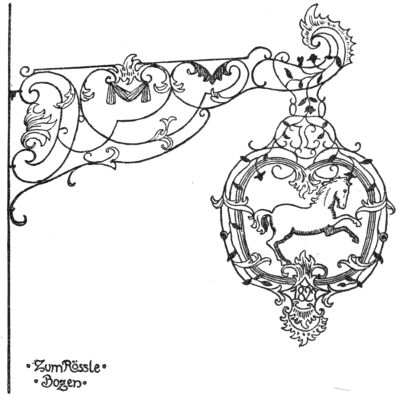
·Zum Rössle·
·Bozen·
More important than the hospitality under the protection of knights and sovereigns was the hospitality extended to the traveler behind big city walls. The city government provided not only lodgings for the poor pilgrims, tramps, and jobless people, but not[Pg 84] infrequently offered hospitality likewise to the merchant who came to display his wares in the open vaults of the city hall. In the famous “Rathskeller” every business transaction was duly celebrated by buyer and seller; the brotherly act of drinking a glass of wine together seemed to be the essential finishing-touch which clinched the business. These old cellars are still a great attraction of the town in many German places, such as Bremen, Lübeck, or Heilbronn, for instance, and all travelers are glad to refresh themselves in their quiet vaults.
A hospitality of more intricate character was given by the guilds, in their houses, to all the members of the trade or craft. Most naturally they choose as signs symbols of the special work of each guild. The fisher and boatmen loved to see a fish, an anchor, or a ship over their tavern door; but they did not claim these signs as a special privilege, every “compleat angler,” to use Izaak Walton’s expression, as well as every incomplete one, could hang a fish out over his porch or on his house corner even if he did not keep a tavern. The house where Dr. Faustus treated his comrades in such miraculous[Pg 85] way was called “Zum Anker” and belonged to a nobleman in Erfurt if we believe the oldest popular reports of the event. Goethe transferred the scene to Auerbach’s Keller in Leipzig, which was familiar to him from his happy student-days. Old sea-captains and blue-jackets cannot resist the temptations of “The Anchor” even if the signboard does not invite them so charmingly as the one of “The Three Jolly Sailors” in Castleford:—
The shoemakers most naturally decorated their guild-house with a beautiful big boot, a word closely related to the old French “botte,” a large drinking cup, and its diminutive “bouteille,” the origin of the English “bottle.” The butchers seldom show the cruel axe, far oftener the poetical lamb, their oldest sign being the Pascal lamb holding the little flag of the resurrection. A patriotic English landlord in the neighborhood of Bath changed the flag into a Union Jack, forgetting all about the religious meaning of the sign as it still appears in a French relief “L’Agneau Pascal” in Caen, Rue de[Pg 86] Bayeux. The tavern “Zum guldin Schooffe” in Strassburg, “la vieille ville allemande” as Victor Hugo called the city quite frankly, is perhaps the oldest sign of this group. It dates back to the year 1311 at least. Another butcher sign is the ox or bull, most popular, of course, in the land of John Bull, where the bull appears in the most surprising combinations as “Bull and Bell,” “Bull and Magpie,” “Bull and Stirrup,” and the like.
The tavern signs of the bakers, “The Crown,” “The Sun,” or “The Star,” lead us back to old pagan times in which the cakes offered as sacrifice to the gods were shaped in the same curious forms which we observe to-day in our various breakfast rolls. Christian legends of the holy three kings and the star that stood over the stable in Bethlehem effaced these pagan souvenirs. On the day of Epiphany especially beautiful crowns were baked; in France the bakers still follow the old tradition and offer such a crown to each of their customers as a present, not without hiding a tiny porcelain shoe in the dough. The happy finder of this shoe becomes the king of the company. Dutch masters have represented the merry[Pg 87] family scene of the Epiphany dinner, none perhaps so convincingly as Jordaens in the famous picture, “The King Drinks,” in the great gallery of the Louvre.
“The Star” has always been one of the most popular signs, its gentle glow seemed to promise the traveler on the dark road a friendly resting-place after the long, weary day. Sometimes the modern owner of such a venerable old star-inn promises even more and advertises his place, in slangy rhyme, as the landlord of “The Star” in York.
Beside “The Star” and “The Golden Sun,” where you drink “the best beer under the sun,” we find “The Moon,” especially “The Half-Moon,” as great favorites of the people. The naval victory of 1571 at Lepanto, where the united Christian fleet destroyed The Turk,—in those days not a sick man, but rather a robust and aggressive one,—is perhaps the cause of the popularity of the half-moon. The Virgin Mary, to whom the pious sailors ascribed the victory, was[Pg 88] often represented as standing on a half-moon, because she was “the woman clothed with the sun, and the moon under her feet, and upon her head a crown of twelve stars” whom the poet of the Revelation had seen in his immortal dreams. Crowned with her diadem of stars she was dear to the seamen, the “stella maris,” to whom they lifted their anguished soul in prayer: “Ave Maria, navigantium stella, quos ad portum tranquillum vocata conducis.” As “light of the world” she was praised in the old “dialogus consolatorius” where the sinner humbly begs her:—
But it is not the half-moon, lying horizontally as a silver bowl in the Christian presentation of the heavenly queen, which we find on the tavern sign, but always the standing crescent of the Turkish flag, and we are glad of it. If we study the life in these half-moon taverns at the hand of Teniers’ pictures and etchings, we find very little that is Christian and worthy of the sacred symbol of the Revelation.
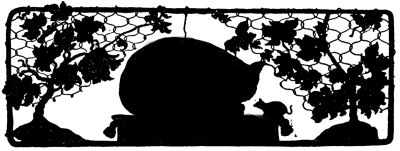
Still more popular than the stars of heaven is the animal world on the tavern sign. The ark of Noah itself and all it contained, every creeping and flying thing, was welcome over the tavern door in those days when men and beast, often living under the same roof, as in the divine inn of Bethlehem, were nearer to each other than they are now. Nothing less than a tavern zoölogy could give a complete enumeration, which we prefer to avoid. We will choose only a few which were especially dear to the people. First of all, naturally, the house companions,—the cat, “Le Chat qui dort” which found a quiet resting-place for her old days in the Musée Carnavalet in Paris; the dog, popular in sport-loving England; the ox and the donkey, even an elegant mule we find in the “Auberge de la Mule” at Avignon, praised by Abraham Gölnitz, the Baedeker of the[Pg 90] seventeenth century, as a “logement élégant et agréable.” We have already met the cock in Rome of old, on the Forum, in Holland we see him occasionally as a cavalier in high boots. The dove, the symbol of the Holy Ghost, decorates the “Gasthäuser zum Geiste” one of which stood in the old Strassburg and saw the remarkable interview between the young Goethe and the poet Herder. Finally the stork, the true sign of German “Gemütlichkeit”; the one in Basel was honored by the visit of Victor Hugo: “Je me suis logé à la Cigogne, et de la fenêtre où je vous écris, je vois dans une petite place deux jolies fontaines côte à côte, l’une du quinzième siècle, l’autre du seizième.”
To the Philistine the strange animals of foreign distant lands had a greater attraction still. In every modern “zoo” you will always find a larger public before the monkey house than before the cage of the lion or even the elephant, whose dignity and wisdom find fewer admirers than does the foolishness of the apes. Early in the Middle Ages we find this most curious of strange animals on the tavern signs. “L’Ostel des Singes,” sometimes called “The Green[Pg 91] Monkeys,” in Senlis, France, is first mentioned in the year 1359. Our “Affenwagen” is a Swiss sign, artfully carved in wood, and dates from the Renaissance times, as does the inn “Zum Rohraff” in Strassburg, often referred to in the sermons of Geiler von Kaisersberg.
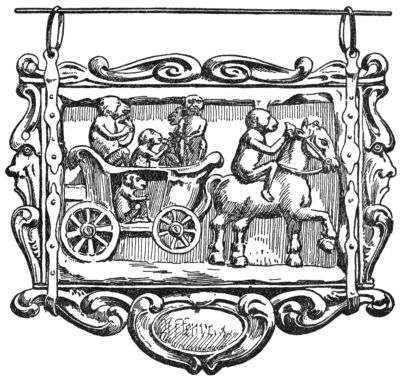
When the first dromedary made its appearance in Germany, a circular containing a primitive woodcut invited old and young to see “the curious animal called Romdarius.”[Pg 92] Fifty miles it could run in one day in the sand sea—i.e., desert—the text said, and in summer it could live three months without drinking “ohne sauffen.” This last-mentioned quality seemed to predestine the animal to a temperance sign, but fortunately the description added, “when it drinks it drinks much at one time,” and so the tavern-keepers did not hesitate to adopt it as a tavern sign. As an example we might quote the inn “Zum Kameeltier” in Strassburg. Somewhat later, in the first half of the seventeenth century, “The Crocodile” appears over the tavern door in Antwerp, and this reminds us of the stuffed animals in the pharmacy described by Shakespeare in “Romeo and Juliet”:—
The zebra seems to have been known quite early if we are allowed to take “The Striped Donkey” as such. In the inn “L’Ane rayé” at Rheims, the father of Joan of Arc is reported to have lodged when he came to see the coronation in 1429. One of the last comers of the curious and rare animals was[Pg 93] the giraffe; it appeared in Paris for the first time in 1827, and was immediately adopted as a tavern sign by a host in Étampes, near the capital. The “enseigne” represented “le dit animal conduit par un Bédouin.”
But the most curious animals of creation did not suffice. The imagination of the people created others still more strange and the landlords put these fabulous beasts on their signs too: the unicorn, the dragon, the siren. “The Siren” tavern in Lyons at the time of the Renaissance was evidently a very attractive place which the traveler found very hard to leave again, because, as a contemporary tells us, “il s’y trouve des Sirènes.” In later days, when the popular stories were forgotten, the sirens were changed to “Six Reines,” the six queens. In another chapter we shall see how Keats in his poem, The Mermaid, has celebrated one of these old Siren taverns.
How deeply rooted in the old days was this belief in “Mörwonder” or ill-shaped fishes and malformations of the human figure will appear at a glance in Schedel’s “Welt Chronik” printed by Koberger in Nuremberg in 1493, where we see them in strange woodcuts[Pg 94] before us: the man with ears hanging to the ground and other misshaped creatures.
The same source of popular imagination created “Le Géant,” the sign “Zu den Slaraffen” in Strassburg, 1435, and the sign of “The Little and the Great Sleeper” that during three centuries, from 1400 to 1705, invited the citizens of the Alsatian capital to cross its hospitable threshold. A charming picture, “The Sleeping Giant of the Woods” by Lukas Kranach, in Dresden’s famous Gallery, will help us to imagine how the big sleeper probably looked. Is it the famous “Wild Man” or “Le Grand Hercule” who sleeps here in the shadow of the forest? One thing is sure, he has been drinking deeply and is dead asleep; nothing can wake him up, not even this little army of dwarfs around him who attack him with lances and arrows, nay, even try to saw into his strong limbs.
Since the days of the “Roman du Renard,” the first version of which dates back to the eleventh century, to the days of Goethe’s “Reineke Fuchs,” shrewd master Fox was a favorite of the people. In old miniatures we encounter him as a monk, his pointed nose buried in a prayer-book. His exploits[Pg 95] most naturally form good themes for the tavern sign. Dancing before a hen to seduce the foolish creature by his graceful charms, he was represented on an old French sign in Le Mans: “Renard dansant devant une poule.” Preaching to ducks, “Wo der Fuchs den Enten predigt” is the name of a Strassburg tavern, which dates only from 1848. His shrewdness before the royal tribunal of the lion was well known; Montaigne, therefore, warns the tavern-keepers who desire the patronage of advocates against painting him on the signboard: “qui veut avoir la clientèle des procureurs ne doit point mettre renard sur son enseigne.”
Other animals appealed more to the culinary instincts of the passer-by, among them the swan, “l’oiseau de bon augure,” which we do not like to see turned into roasts. But in Chaucer’s times it was evidently considered a fine dish, since he lets the monk in his “Canterbury Tales” say: “A fat swan loved he best of any rost.” A picture by David Teniers in The Hague, called “The Kitchen,” shows how the bird was served in his natural glory, a crown of flowers on his proud head. This custom to serve fowl in full plumage is[Pg 96] proved by Montaigne’s description of a dinner in Rome: “On y servit force volaille rôtie, revêtue de sa plume naturelle comme vifve ... oiseaus vifs (enplumés) en paste.”
To this group belongs the peacock, in the old days the official roast for marriage feasts. Its picture on the signboard promised large accommodations for people who wanted to celebrate marriages in true style. “Le Paon blanc” in Paris, Rue de la Mortelleric, now a rather shady region, was once a noble inn. Shortly after his marriage, Rembrandt painted the famous picture in Dresden, where he represents himself, a glass of champagne in hand, happily holding his beloved Saskia on his knees. The richly decorated table in the background still carries the peacock of the marriage feast. Of “The Pheasant” in Worms, before the days of gas and electricity, Victor Hugo has given us this amusing picture: “J’étais installé dans l’auberge du Faisan, qui, je dois le dire, avait le meilleur aspect du monde. Je mangeais un excellent souper dans une salle meublée d’une longue table et de deux hommes occupés à deux pipes. Malheureusement la salle à manger était peu éclairée, ce qui m’attrista. En[Pg 97] y entrant on n’aperçevait qu’une chandelle dans un nuage. Les deux hommes dégageaient plus de fumée que dix héros.”
Sometimes a living bird served originally as a sign. The parrot of the pharmacy, “Au Perroquet Vert,” in Lyons, was a real bird, which had learned even some Latin phrases, as “ora pro nobis,” from the passing processions, and naturally attracted many people by its wisdom. He belonged to the living signs to which Balzac refers in “Les scènes de la vie privée”: “Les animaux en cage dont l’adresse émerveillait les passants.” Sometimes the cage itself was adopted as a tavern sign and in Lyons a street was named “Rue de la Cage” for a public-house of this name. A charming little French rhyme from the beginning of the seventeenth century introduces us to such a cage-tavern:—
Not only bird-cages and their musical or scholarly inhabitants, but any remarkable object that happened to stand before the tavern was readily interpreted by the people[Pg 98] as a sign. In the little English town of Grantham, where we had already the opportunity of admiring the noble “Angel Inn,” we saw in a tree before a modest tavern a beehive with this inscription on a board beneath it:—
To tell the truth, the lofty tower of St. Wulfram seemed to us the only remarkable “rarity” of the two, the more so as the church was beautifully decorated for Thanksgiving Day with flowers and the fruits of the field, not to mention its unique little library with the chained old books.
We may infer the great popularity of signs by the ceremonious way in which they were changed when a guild removed to other quarters. The sign was carried in solemn procession to the new inn and hung up with blasts of trumpets. The Swabian poet Mörike has tried to express the melancholy emotions of the old landlord when he sees the sign changed and finds it hard to recognize his old inn:—
An English author even tells us about the burial of a sign, which, he says, was not an unusual affair in Cumberland. We give the story in his own words: “It is a function always observed when an inn in the neighborhood of Lady Carlisle’s estate at Naworth has lost its license. The inn sign is solemnly removed, and in the dead of night is committed to the grave, in the presence of the old customers of the inn. As a rule it is ‘watered’ with tears in the shape of a bottle of whiskey, and the burial sentence runs as follows:—
But we shall not end our chapter with this story of rather doubtful taste. If we review the wealth of popular signs, which we have in no way exhausted, we may well say that everything on earth may be adopted by the people as a sign, from the cradle in which we dream our first dreams to the cross that some day will stand over our “last inn” as a pious[Pg 100] and scholarly man has called our grave. In the beautiful churchyard that enfolds in its greenery England’s oldest existing church, St. Martin in Canterbury, we read on the tombstone of Dean Alford the simple words: “Deversorium Viatoris Hierosolymam Proficiscentis,” last inn of a pilgrim to the heavenly Jerusalem.
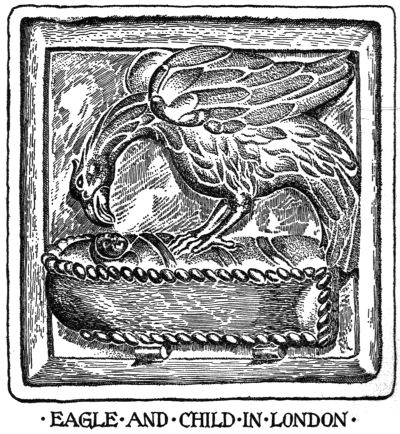
·EAGLE·AND·CHILD·IN·LONDON·
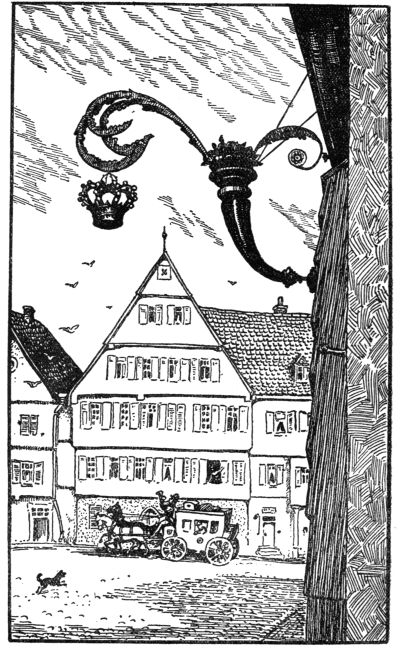
Krone Leonberg, Württemberg
Little William, already in the days when he went “with his satchel and shining morning face creeping like a snail unwillingly to school,” had ample leisure and opportunity to gaze admiringly at the many signs which adorned the narrow streets of the quiet little town on the Avon. The memory of them still lives in some of the Stratford hotels. The landlady of the “Golden Lion,” for instance, remarks on her bill: “Known as Ye Peacocke Inn in Shakespeare’s time 1613.” Even the “Red Horse,” to-day extremely modern and uninteresting-looking, goes back to these old days. In Washington Irving’s time the place probably looked more quaint and cozy, if we may believe his praise of the old inn in his “Sketch-Book”: “To a homeless man, there is a momentary feeling of something like independence and territorial consequence,[Pg 104] when, after a weary day’s travel, he kicks off his boots, thrusts his feet into slippers, and stretches himself before an inn fire.”
This picture gallery of the street signs was still more magnificent in London, where even the theaters had their signs out, as “The Globe,” “Red Bull,” “A Curtain,” “A Fortune,” “Cross Keys,” “The Phenix,” “The Rose,” “The Cockpit,” and we may be sure that they made quite an impression on the lively mind of the young actor. The word “sign” occurs frequently in his vocabulary. Inclined to see below the surface, he does not seem to trust the glittering of the sign, as the words of Iago indicate:—
The signs of his birthplace were probably rather poor-looking things, since he uses the word in his early drama, “Titus Andronicus,” contemptuously:—
The sign of the “Falcon” was not yet hung out on the old house of Scholar’s Lane and Chapel Street in those years of 1571 to[Pg 105] 1578, when little Shakespeare went to the Grammar School, in which the traveler to this day may see the chair of the pedagogue who first introduced him to the secrets of literature. But the circle of life led him back to the same narrow street, and opposite the stately building, which now is the “Falcon,” Shakespeare died. The mortuary house has disappeared and the ground has been transformed into a garden. Here we are infinitely nearer to the poet’s soul than in the tiny birth-chamber disfigured by a huge bust, where the guide drowns all our thoughts in[Pg 106] a flood of empty words. Here in this garden the genius of the poet seemed to reveal himself most charmingly. Where once the house stood in which he died we found a little child peacefully sleeping—all alone, unguarded, but the gentle rose of youth blooming on his cheeks—under the perfumed shadow of flowers; a symbol of eternal life conquering death.
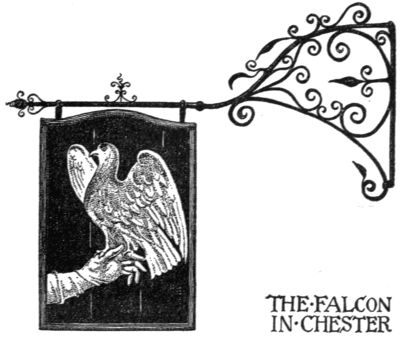
THE·FALCON IN·CHESTER
If we enter the “Falcon,” Shakespeare’s words greet us from the wall: “Good wine is a good familiar creature if it be well used, exclaim no more against it.” The gentle invitation of the blinking sign to enter and to share joy and sorrow with friendly comrades, Shakespeare himself has often followed. A French critic, Mézières, went so far as to call him “un habitué de la taverne,” politely adding that “he never lost his self-control and never contended himself with the light joys of the flying hour.”
The “Red Lion” in Henley-on-the-Thames once owned a window pane—recently by mistake packed in the trunk of a confused traveler—into which Shenstone scratched the much-quoted words:—
They are of true Shakespearean spirit and remind us of Speed’s words in the “Two Gentlemen of Verona” (ii, v):—
“I’ll to the alehouse with you presently, where, for one shot of five pence, thou shalt have five thousand welcomes.”
It would seem hardly necessary further to urge such an enthusiastic lover of the tavern, but Launce thought differently.
Launce. If thou wilt go with me to the alehouse, so; if not, thou art an Hebrew, a Jew, and not worth the name of a Christian.
Speed. Why?
Launce. Because thou hast not so much charity in thee as to go to the ale with a Christian.
We are not surprised to hear the final question, “Wilt thou go?” promptly answered, “At thy service.”
Most of the tavern names Shakespeare mentions are true products of the Renaissance times when classical studies were extremely popular. “The Centaur,” “The Phenix,” “The Pomegranate,”—an ornament we find so often in the brocades of the[Pg 108] sixteenth century,—all are signs of his own time, simply transplanted from London he knew so well to Genoa or Ephesus, places he had never put his eye on. “The Pegasus,” by the man in the street called “The Flying Horse,” decorated still in the year 1691 the house of a jeweler and banker in Lombard Street. In passing, we may remark that all the signs which to-day surprise the traveler in this busy street are more or less happy reproductions of the old signs, hung out there by the great banking firms for King Edward’s coronation.
In our wanderings through England we occasionally cross the path Shakespeare went with his company of actors. The court in the “George Inn” in Salisbury, to-day transformed into a pleasant little garden, was once the scene where the “Strolling Players” of the sixteenth and seventeenth centuries used to give their performances, and here Shakespeare himself acted when he visited Salisbury. A police ordinance allowed only in the “George” theatrical amusements, and demanded that all plays should be ended by seven o’clock in the evening. This George Hotel was first mentioned in 1401 as[Pg 109] “Georgysyn.” Oliver Cromwell slept here October 17, 1645, on his way to the army. The old beams which carry the ceiling of the parlor, and which a shrewd landlord has discovered in other rooms and freed from the hiding plaster, are the delight of American travelers, who refuse to sleep in rooms without beams. In the days of Pepys it was an elegant hostelry. In his “Diary,” in which he praises Salisbury as “a very brave place,” he puts down the following remarks: “Come to the George Inn where lay in a silk bed, and very good diet.” Less pleased he was with the bill, which he thought “so exorbitant that I was mad and resolved to truble the mistress about it and get something for the poor; and came away in that humour.” The result of his protest was not great. After paying £2 5s. 6d. for the night he gains just two shillings for the poor (one for “an old woman in the street”). Similar privileges for theatrical performances had the “Red Lion” in Boston, the little English mother of her big American daughter, and the “Mayde’s Hede” in Norwich. The closed space of these old innyards, with its staircases leading to the surrounding gallery, was thoroughly[Pg 110] fitted for the theatrical representations, and it is quite possible that this gallery of the innyard influenced the architecture of the later theaters. Few of these innyards have survived, unfortunately, but we have still a wonderful example in the charming court of the so-called “New Inn” in Gloucester. It was new in the fifteenth century. How enchanting a Shakespeare play would be in the frame of its verdure!
In the First Part of “Henry IV,” the poet himself has introduced us into such an innyard. It is very early morning and everything still dark. Carters come to look after their goods and to harness their horses, exchanging remarks in plain language: “I think this be the most villanous house in all London road for fleas”; or, “God’s body! the turkeys in my pannier are quite starved. What, ostler! A plague on thee! hast thou never an eye in thy head?”—a master scene of realistic observation in the style Lessing and Goethe admired so much, and Voltaire hated so that he proclaimed: “Shakespeare was a remarkable genius, but he had no taste, since for two hundred years he has spoiled the taste of the English nation.”
How important the spacious enclosure of the innyard was for the farmers coming to town with their loaded wagons is shown by the fact that still to-day many a hotel in Germany is simply called “Hof” (court) or “Gasthof”; as, for example: “Koelner Hof,” “Rheinischer Hof,” “Habsburger Hof,” even “Kaiserhof,” sumptuous modern structures, perhaps, which have only a narrow lighting shaft in the center of the building and nothing of the large and airy courtyards of the good old times.
Many of the tavern names Shakespeare mentions in his plays we know from other sources as signs that actually decorated the streets of London. “Leopard” and “Tiger” were infrequent, but we hear of a “Leopard Tavern” in Chancery Lane, which still existed in 1665. The popular pronunciation was “lubber,” and in this form we find the beast quoted in “Henry IV” (Part II, ii, i), where it is said of Falstaff: “He is indited to dinner to the Lubber’s-head in Lumbert street, to Master Smooth’s the silk-man.” Such curious distortions of strange words are nothing uncommon in popular language; we have only to remember how the old[Pg 112] Yankee farmers used to call the panther by the gentle name “painter.” Another of Falstaff’s favorite resorts was “The Half-Moon,” likewise mentioned in “Henry IV” (Part I, ii, iv), where he used to consume countless “pints of bastard” and of dark Spanish wine. “The Tiger” referred to in the “Comedy of Errors” (iii, i) was, too, an actual sign of the times, as we hear of a “Golden Tiger” in Pilgrim Street, Newcastle. On the other hand, the name of the “Porcupine,” which occurs in the same play, is probably invented as a characteristic sign for a place of ill-fame.
The most renowned of all the Falstaff inns is doubtless “The Garter,” his real home, so vividly described in the “Merry Wives of Windsor”: “There’s his chamber, his house, his castle, his standing-bed and truckle-bed; ’tis painted about with the story of the Prodigal, fresh and new.” These few words give us an exact picture how a sleeping-room in an inn looked in his time. The truckle-bed, it seems, was put under the standing bed and was used by the servant, if we interpret rightly the old rhyme on a “servile tutor”:—
Even the wall paintings, as Shakespeare describes them, are not invention. In the sixteenth century people loved to paint the story of the lost son on the walls of the tavern room, just as in the fifteenth century they pinned up little primitive woodcuts representing St. Christopher. Later we shall see a painter of talent like Hogarth not despise the decoration of taverns as below his genius and embellish with works of his brush the “Elephant Tavern” in Fenchurch Street, where he stayed for a time.
The name “Garter Inn,” pronounced “de Jarterre” by Doctor Caius, is historical, too. Later, in the times of Charles I, who added the star to the insignia of the order founded by Edward III in 1350, the “Star and Garter” appeared.
A true Renaissance sign we find again in the “Sagittary,” cursorily mentioned in “Othello” (i, i). The archer, the ninth sign of the Zodiac, was very familiar to the people from the old calendar woodcuts. Italian prints, as the beautifully illustrated “Fasciculus medicinæ” (Venice, 1500), represent[Pg 114] him in classical fashion as an elegant centaur, very unlike the little philistine with round belly, such as he appears in the earlier “teutsch kalender” of Ulm, 1498. The common people did not call him “Sagittarius,” but “bowman” (Schütze). There is good historical evidence of a “Bowman Tavern” in Drury Lane, London. It is natural that Shakespeare, a true son of the Renaissance, should call him with the classical name, just as the first German composer of operas changed his good German name “Schütze” to the more pretentious form of “Sagittarius.”
In these “Bowman Taverns” the guilds of the archers used to come together; as, for instance, in the “Hotel de l’Arquebuse” in Geneva, where the Swiss archers had their joyous reunions after they had finished their outdoor sport to shoot the “papegex” (the parrot). Here the king of the archers who had done the master shot “sans reproche” and “sans tricherie” (without cheating), was celebrated in poetical speeches, according to the customs of the times:—
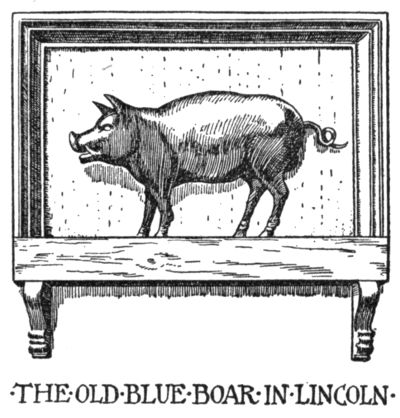
·THE·OLD·BLUE·BOAR·IN·LINCOLN·
The most famous of all Shakespearean tavern signs is perhaps the “Boar’s Head.” Washington Irving has told us in his research, “the boar’s head tavern, Eastcheap” about his investigations on this important matter. “I sought, in vain, for the ancient abode of Dame Quickly. The only relic of it is a boar’s head, carved in relief in stone, which formerly served as a sign; but at present [Irving’s ‘Sketch-Book’ dates from 1820] is built into the parting line of two houses, which stand on the site of the renowned tavern.” To-day the relief, blackened by age and curiously looking like Japanese lacquer-work, belongs to the treasures[Pg 116] of the Guildhall Museum in London. The place where the old tavern stood is marked by the statue of William IV, opposite the Monument Station of the subway. Merry souvenirs of good old England are suggested by the boar’s head, which used to be served on Christmas Day decorated with rosemary and greeted from the company with the half-Latin song:—
It will be a great disappointment to our readers when we have to confess that the unlucky fellows called literary critics have found out that the stage-direction, “Eastcheap. A room in the Boar’s Head Tavern,” is not Shakespeare’s own remark, since we do not find it in the early editions of “Henry IV.” Still more so when they hear that the relief in Guildhall bears the date 1668 and has been chiseled, therefore, fifty-two years after the poet’s death. A little consolation we find in the not improbable supposition[Pg 117] that it is a copy in stone from the original wooden sign. Did not the famous fire, which raged from Pudding Lane to Pye Corner in the year 1666, destroy nearly all the Shakespearean London, with its old-fashioned frame houses? For greater security the new buildings were erected in stone and the old house emblems and carved tavern signs reappeared, too, in more substantial form. The Guildhall Museum furnishes quite a number of examples: “The Anchor” of 1669, “The Bell” of 1668, “The Spread Eagle” of 1669, and others.
And now let us follow Heinrich Heine on his voyage to Italy and hear from him how in his days the noble palace of the Capulets, Julia’s paternal home in Verona, was debased to a common tavern. Near the Piazza dell Erbe “stands a house which the people identify with the old palace of the Capulets on account of a cap (in Italian ‘cappello’) sculptured above the inner archway. It is now a dirty bar for carters and coachmen; a red iron hat, full of holes, hangs out as a tavern sign.” To-day this disgraceful sign has disappeared and a marble slab consecrates the popular myth as historical fact. This was[Pg 118] then the house where Romeo for the first time saw his lady love:—
Romeo. What lady’s that which doth enrich the hand
Of yonder knight?Servant. I know not, sir.
Romeo. O, she doth teach the torches to burn bright!
Her beauty hangs upon the cheek of night
Like a rich jewel in an Ethiop’s ear;
Beauty too rich for use, for earth too dear!
Shakespeare’s geographical knowledge seems to have been very limited. If he could have gone, as the citizen of Stratford to-day, to the Carnegie library, how many shocking errors he had avoided! Here he could have learned that Bohemia has no seacoast, that Florence is not a port, and that the forest of Arden neither hides lions nor contains palms. But would this knowledge have increased his poetical feeling and his power of representation? Hardly. The northern land with its “sniping winds,” how well it is characterized; how simple and true to life his description of the mild climate of Sicily, crowned with temples, in the “Winter’s Tale” (iii, i):—
It was not yet the fashion to flee the winter and try to find eternal spring in the South. Every season is welcome to the poet who loves the peculiar charm of each one, as he says in “Love’s Labor’s Lost” (i, i):—
He probably never traveled far, but how intensely does he feel the curious sensations of all travelers, the weariness and yet the eagerness to see the new sights! How perfectly modern sound in the “Comedy of Errors” (i, i) the words:—
He possessed, like Schiller, who never saw Switzerland, and yet wrote “Tell,” the wonderful gift of filling the lack of distinct knowledge with the poetical power of imagination, or, as he calls it himself, “to make imaginary puissance” and “to piece out our imperfections with our thought.”
No doubt certain things, details of local civilization, cannot be imagined. One has to go and study them. We will therefore, to gain a fuller understanding of the hospitality of the sixteenth century, follow a contemporary of Shakespeare in his travels, Montaigne, a clear-sighted observer, who as grand seigneur had the good fortune to make extended voyages in France, Southern Germany, and Italy. Although himself rather a spoiled gentleman, he generally is full of praise for the comforts and elegance of the inns, especially in the south of Germany. Only once he had to complain about the “liberté et fierté Almanesque,” and this happened at Constance in the “Eagle.” The elegance of the Renaissance hostelries was indeed surprising and has hardly been surpassed in our days of luxurious traveling. Not only most of the beds were covered with silk, as in the “Crown” at Chalons, for instance,—“la pluspart des lits et couvertes sont de soie,”—but sometimes the table silver was richly and artistically decorated, as in the “Bear” at Kempten (Bavaria): “On nous y servit de grands tasses d’arjant de plus de sortes (qui n’out usage que d’ornemant, fort labourées et[Pg 121] semées d’armoiries de divers Seigneurs), qu’il ne s’en tient en guière de bones maisons.” In many places still the wooden plates and cups were used, sometimes covered with silver; tin plates, which appear at the end of the fifteenth century, seem to impress Montaigne as a novelty. He notes at least expressly that in the “Rose” at Innsbruck he was served in “assiettes d’étain.” In the same very good “logis” he admired the beautiful laces which decorated the bed-linen—the pride of the German Hausfrau to the present day. The sheets had, he said, “quatre[Pg 122] doigt de riche ouvrage de passement blanc, comme en la pluspart des autres villes d’Allemaigne.” Other things, on the contrary, which one finds to-day in the most modest lodging-house—as, a stairway carpet—seem to him very strange and a great novelty, although he used to stop only in first-class houses. The inn “Zur Linde” in Augsburg—“a l’enseigne d’un arbre nomé ‘linde’ au pais”—possessed this novel luxury, and Montaigne describes it in this detailed manner: “Le premier apprêt étrange et qui montre leur properté, ce fut de trouver à notre arrivée le degrés de la vis (spiral stairway) de notre logis tout couvert de linges, pardessus lesquels il nous falloit marcher, pour ne salir les marches de leur vis qu’on venait de laver.”
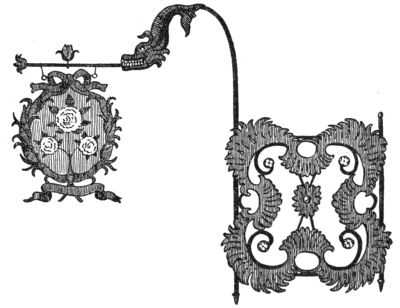
The linden tree was very popular in Germany as a tavern sign; under the shadow and in the sweet perfume of the village Linde, old and young loved to gather to dance and sing. How cozy the inn room looked at times we may see from his description of the “Crown” in Lindau. A great bird cage “à loger grand nombre d’oiseaus” was connected with the woodwork of[Pg 123] the comfortable bench that used to surround the big stove. A look at Dürer’s engraving, “The Dream,” will help our phantasy to see and feel more clearly the “Gemütlichkeit” of such a stove-corner. Leaning back in soft cushions, a philistine in dressing-gown is peacefully dozing, while a beautiful young woman standing at his side seems to reveal a part of his dream.
The most luxurious hotel Montaigne ever stopped at was one in Rome, nobly called “Au Vase d’Or.” “As in the palace of kings,” the furniture was covered with silk and golden brocades. But he did not feel at home in his royal room, constantly fearing to injure the costly things, and to get a great bill against him for damages. So he decided to move to more modest quarters, not without dictating to his secretary: “M. de Montaigne estima que cette magnificence estoit non-sulement inutile, mais encore pénible pour la conservation de ces meubles, chaque lict estant du pris de quatre ou cinq çans escus.” Most of the Italian inns of his time stood in curious contrast to this royal sumptuosity. Often the windows were mere holes in the walls, simply closed with wooden[Pg 124] shutters, which darkened the room completely if one needed to be protected against sun, wind, or rain. Such was the case of the “Crown” in Siena: “Nous lojames à la Couronne, assés bien, mais toujours sans vitres et sans chassis. Ces fenêtres grandes et toute ouvertes, sauf un grand contrevent de bois, qui vous chasse le jour, si vous en voulez chasser le soleil ou le vent; ce qu’il trouvoit bien plus insupportable et irremédiable que la faute des rideaux d’Allemaigne.” This lack of curtains in German hostelries was still, two hundred and fifty years later, for Victor Hugo a reason to complain about the “indigence des rideaux.” A real miserable time Monsieur de Montaigne had in Florence in the “hostellerie de l’ange,” where certain little creatures drive him out of bed and force him to sleep on the table: “J’etois forcé la nuit de dormir sur la table de la salle ou je faisais mettre des matelas et des draps ... pour éviter les punaises dont tous les lits sont fort infectés.” A similar experience he has in San Lorenzo, near Viterbo, the charming little town of countless fountains.
But we must take leave of our noble[Pg 125] traveling companion and visit the painters’ studios of the time to see if we cannot find in their work pictures of the taverns and signs we have heard so much about.
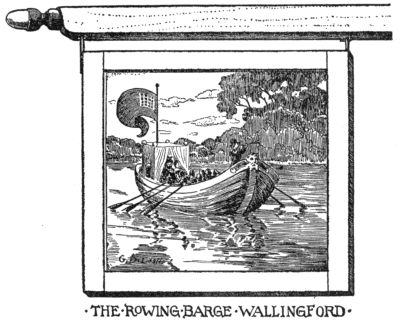
·THE·ROWING·BARGE·WALLINGFORD·
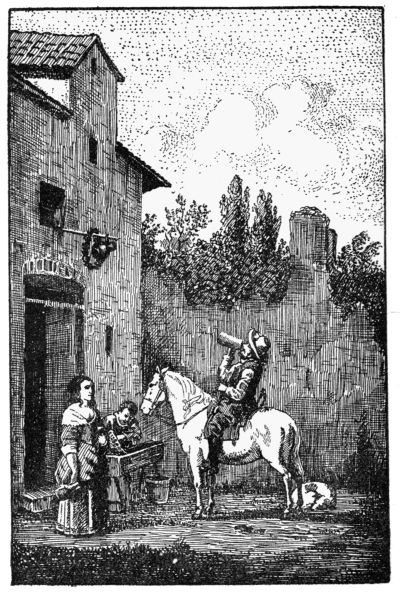
The Trumpeter before a Tavern
From a Painting by Du Jardin in Amsterdam
Carlyle once complained that the artists preferred to paint “Corregiosities,” creations of their own fancy, instead of representing the historic events of their own times. Only the Dutch painters of the seventeenth and eighteenth centuries, in so far as they keep clear of the Italian influence, may justly be called true historical painters, certainly with greater reason than the school of historical painting in the nineteenth century, which tried to reconstruct events of epochs long past with the antiquarian help of old armor, swords, costumes, and the like. We will find, therefore, in the works of the Dutch masters the truest historical documents for our modest sphere of investigation.
While Greek art reflected, as in a pure mirror, the harmony of worldly and religious life in Hellas, the mediæval art essentially[Pg 130] served religious ideas, but in giving them a visible form used the worldly elements of contemporary costume and architecture. Great artists like Giotto, whose merits the proud words on his tombstone characterize, “Ille ego sum per quem pinctura extincta revixit,” proved themselves the best historians, because they possessed, besides deep religious concentration, the gift of true observation, thus introducing in their works valuable information about the life of their own time.
Not until the dawn of the Renaissance had freed the worldly spirit from ecclesiastical shackles did men imbued with a deep-rooted love of their country, like the Venetian Vittore Carpaccio, or the Florentine Benozzo Gozzoli, give us true pictures of home life. Out of the solemn walls of churches and cloisters they lead us into the animated and picturesque life of the streets, which were not, as some authors try to make us believe, above all the scene of wild and unbridled passions, but which we might compare with arteries filled with the red and healthy blood of social life. In his frescoes from the life of St. Augustine in[Pg 131] San Gimignano, Benozzo shows us how parents present their little boy to the “magistro grammatice” in the street in front of the open schoolroom. Little Augustine, crossing his arms over his breast in an attitude of deference, looks rather inquisitively at his future master, while in the parents’ faces we read the earnest hope that the son will make “ultra modum” great progress, and never deserve such shameful public punishment as we see administered to the little good-for-nothing on the right side of the picture. But we do not observe a schoolmaster sign hung out, such as have come down to us from the German sixteenth century. The Italian painter still delights, above all, in the architectural beauty of his native city. In the same way Carpaccio shows us the piazzas and canals of his beloved Venice in the splendor of processions, solemn receptions of foreign ambassadors, and the like, decorated with flags and Oriental carpets. The humble inn of the people does not yet attract the eye of the artist, who delights in the elegance of palaces and the grandeur of public buildings.
The early artists of the Netherlands, too,[Pg 132] represent the street, not filled with the noisy, everyday life of the people, but as a quiet stage, on which the holy procession of saints solemnly move, as in Memling’s picture of St. Ursula’s arrival in Rome. In quiet, elegant rooms the noble donors kneel before the holy virgin, saints unite in a “santa conversazione,” far from the world. Here and there only a window looks out on a tiny landscape, with rivers and bridges, roads, and fortified towns on distant hills, beyond which our “Wanderlust” draws us. This little section of nature slowly grows larger, the narrow limitations of architecture fall; crowned only with the glorious light of heaven, Mary sits in the open green fields, which give good pasture to the tired donkey. Thus Jan van Scorel has painted the holy family in a charming picture of the collection Rath in Pest. Out of pious seclusion the way leads into free nature, to meadows and brooks, to clattering mills, and finally, for a rest after the long walk, to the peasant’s inn.
Even earlier, before the Dutch painters, a pupil of Dürer, Hans Sebald Beham, one of the “godless painters of Nuremberg,”[Pg 133] who were exiled from their native town on account of socialistic tendencies, has taken us along this road. In one of his larger engravings he pictures the different stages of a rustic wedding, and for the first time shows us the signboard, hanging on a long stick, from a dormer window of the tavern. We might date the painted sign from the invention of oil painting on wooden panels by the brothers Van Eyck, an art which was introduced in Italy through Antonello da Messina as late as 1473. The signs of earlier date we have to imagine as either sculptures, closely united with the architecture of the house, or as mural paintings such as we still see to-day in Stein-on-the-Rhine, for instance, on the house “Zum Ochsen.”
Master Dürer himself once hung out the little tablet with his famous monogram as a tavern sign over the fantastic ruin, in which he places the birth of Christ in his beautiful engraving of the year 1504, proud to have prepared such a cozy inn for Our Lady and her God-given Child.
But the whole wealth of signs, from the natural simple form of the speaking sign to the most elaborate examples of signs painted[Pg 134] or artfully wrought in iron, reveals itself to us later in the realistic pictures of the Dutch painters.
The earliest representation of a speaking sign, where the merchandise itself is still hung out, I have seen in a woodcut illustrating a book printed in Augsburg in 1536: “Hie hebt an das Concilium zu Constanz.”
It is a baker’s sign: large “brezels” on a wooden stick, a primitive precursor of the artful baker’s sign we observe in Jan Steen’s charming picture “The baker Arent Oostwaard” in the Rijks Museum at Amsterdam. In more modern times the real merchandise is sometimes supplanted by an imitation of the different loafs in wood and neatly painted in natural colors, such as we see in an amusing sign from Borgo San Dalmazzo, a picturesque mountain town near Cuneo in northern Italy.
A similar evolution may be noted in other trade signs: first the real boots, and later a copy in wood, painted red if possible; first the big pitcher and the shining tin tankard decorated with fresh foliage, later the imitation in a wreath of iron leaves. Everywhere in the tavern and kermess scenes painted by[Pg 135] Dutch masters, we see real pitchers and tankards hanging over the doors as speaking signs inviting the peasants to enter and partake of a refreshing drink. In northern Germany the “Krug” (pitcher) was so popular as a sign that the landlord was called after it, “Krüger,” to this day a widely spread family name.
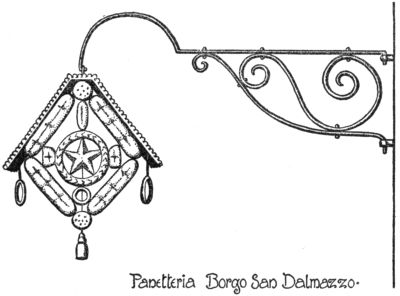
Panetteria Borgo San Dalmazzo·
Unfortunately the Dutch artists loved the interior of the tavern still better than its façade, otherwise we should find still more of the old signs in their pictures. Jan Steen, a genius in the art of living as well as in the art of painting, was a brewer’s son and occasionally he played the landlord himself, in 1654, in[Pg 136] the tavern “Zur Schlange,” and in 1656 “In der Roskam,” both in Delft. In his latter days, when he had returned to his birthplace, Leyden, where he once was enrolled as a student of the university, he obtained a license from the city fathers “de neringh van openbare herbergh.” Who could deny æsthetic influence to tavern rooms bedecked with genuine Steens? Other artists like Brouwer paid their tavern debts in pictures, and thus created an artistic atmosphere in which young artists like Steen himself felt most naturally at ease.
In a picture in Brussels, “The Assembly of the Rhetoricians,” the president of a debating society reads the prize poem to the peasantry assembled outside a tavern, the speaking sign of which, pitcher and tankard, is hanging out on a large oaken branch. More frequent than this bush is the wreath—known to us already as a sign in antiquity—surrounding the jolly pitcher as we see it in Du Jardin’s sunny picture “The Trumpeter before a Tavern,” in Amsterdam.
David Teniers gives the preference to the half moon and rarely omits to place a pitcher above the signboard. Sometimes he decorates his moon tavern with the escutcheon of Austria and the imperial eagle; for instance, in a picture in Vienna. In his great painting in the Louvre we see a mail-stage-driver’s horn, a kind of hunting-horn, although the master, who died in 1690, did not live to see the mail-coach introduced.
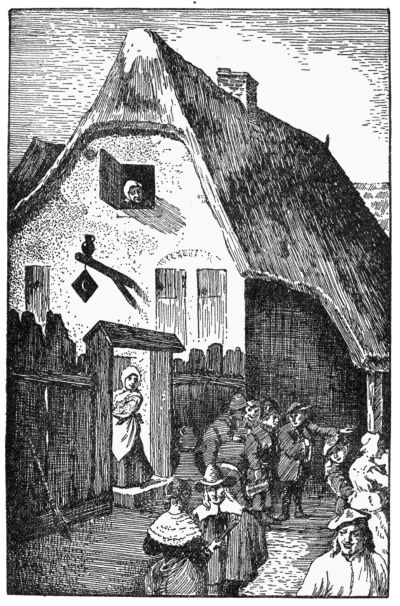
The Half-Moon
from a painting by Teniers in London
In the representations, then so popular, of corporations assembled at
festive meals, we sometimes remark in the background, through an open
window, the stately guild-houses crowned with their signs; the little
lamb with the flag, for instance, in Bartholomæus van der Helst’s
superb banquet of the city guard in the Rijks Museum at Amsterdam. But
perhaps no other artist has given us a more vivid impression of the
beauty of the street with its various glittering signs than the
brothers Berkheyden in the picture of which we reproduce a section in
our Frontispiece. The street itself has been the painter’s real
object, the play of light and shade on its various architectural
features fascinates him more than the people passing through it, who
once acted the principal rôle and are now treated as mere accessories
valuable for accenting the perspective of the[Pg 137]
[Pg 138] picture. Gerrit
Berkheyden has painted the same market-place of Harlem again in his
sunny picture of 1674 in the London National Gallery, but this time
the street, gayly decorated with signs, is more distant and lost in
shadow.
Fifty years later Hogarth gave us a picture of London streets and their fantastic signs, but not in the Dutch spirit of naïve truthfulness. There is hardly an engraving among his numerous productions representing a street scene, without a tavern sign. All forms are represented, the detached signpost characteristic of England, such as the “Adam and Eve” sign on the large engraving “The March to Finchley,” or the sign of “The Sun” hung out on a bracket in his engraving of “The Day,” dated 1738; again, a painted board, fastened against the wall, as we see it over the door of the Bell Tavern, in one of his earliest prints dated 1731 in the cycle “A Harlot’s Progress.” In the same plate we notice over another tavern door a large chessboard, familiar to us from the old Roman taverns. Usually this cubistic pattern decorates the signpost standing in front of the alehouse, as seen in our design of the sign-painter[Pg 139] from the engraving “The Day.” Hogarth’s sarcastic mind was inclined anyway to distort life’s pictures like a comic mirror, and it will be difficult to determine how much further he has caricatured the actual signs he saw in the streets of London which, themselves, were very often the creations of a cartoonist. Most of his signs seem true copies from life; others, like the barber sign in the engraving “The Night,” or the above-mentioned “Good Eating,” I am inclined to think exaggerations or fanciful inventions, although, to be sure, the carved frame around the gruesome pitcher of St. John the Baptist’s head shows a distinct historic style, somewhat plainer and of more recent date than the richly carved Renaissance frame of the Adam and Eve signboard.
While to Hogarth the sign seemed to be an excellent medium wherewith to increase the bitterness of his satire, the German romantic artists of the nineteenth century, Moritz von Schwind and Spitzweg, loved to introduce it in their pictures as a fairy element. The golden pattern of a star sign is woven into the soft lines of their compositions: “The Farewell,” by Spitzweg, and[Pg 140] the famous “Wedding Journey,” by Schwind, in the Schack Gallery at Munich. A friendly star is twinkling over both the lovers who part with tears, and those who are starting upon their journey in the dewy morning of life.
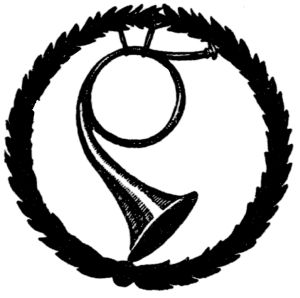
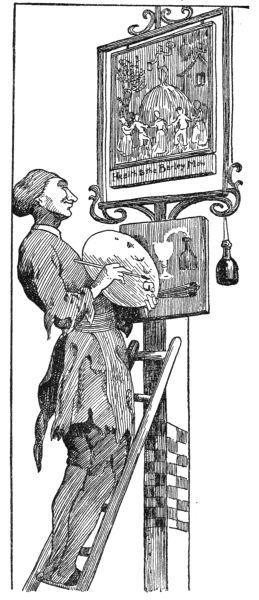
A Sign-Painter from an Engraving by Hogarth
Good old Diderot, who to-day sits so peacefully in his armchair of bronze on the Boulevard Saint-Germain and observes with philosophical calm the restless stream of Parisian life passing him by day and night, was once a severe critic. We might call him the father of critics, since he reviewed the first French Art Exhibition arranged in the Salon carré of the Louvre. From this salon the modern French Expositions in Paris derive their name, although they have grown into bewildering labyrinths of art and have long ago lost the intimacy and elegance inherent in a salon. When Diderot intended to hurt the feelings of an exhibiting artist, he used to call him a “peintre d’enseigne,” and he was cruel enough to use this term rather frequently with those painters “qui ne se servent de la brosse que pour salir la toile.” In the famous encyclopædia which,[Pg 144] together with d’Alembert, he edited in 1779, and which brought them the honorary title of “Encyclopédistes,” he gives two definitions of the French word for sign, “enseigne”: first, a flag; and second, condescendingly, “petit tableau pendu à une boutique.” As we see, the great critic did not appreciate sign-painters and their works very highly; and in this respect he only shared the general opinion of the public, which liked to poke fun at these “artistes en plein vent.”
Charlet, who usually celebrates in his lithographs the soldiers of the great Napoleon, is the author of an amusing cartoon on our poor sign-painters. “J’aime la couleur” is the title of the spirituel design which leaves us in doubt which color the sign-artist really prefers—the red on his large palette or the red of the wine in the glass he is holding.
In similar vein Hogarth represents him as a poor devil in rags and as a conceited fellow evidently very proud of his mediocre work. Like his French colleague he loves a drink in this cold, windy business of his; at least the round bottle hanging on the frame of the signboard contains to our mind,[Pg 145] not varnish, but something in the Scotch whiskey line.
To the “Musée de la rue” his immortal works were dedicated, said a malicious Frenchman; but after all, was this really so degrading at a time when excellent artists did not hesitate to exhibit their work in the open street? Monsieur Georges Cain, the director of the Carnavalet Museum, who knows all the “Coins de Paris” so well and with whom it is so entertaining to promenade “à travers Paris,” tells us that in the days before the Revolution the young artists who were not yet members of the official academies used to show their paintings on the Place Dauphine, once situated behind the Palais de Justice. If Jupiter Pluvius did not interfere, the exhibition was arranged on the day of the “petite Fête-Dieu.” Great linen sheets were pinned over the shop-windows and formed the background for paintings of such eminent artists as Oudry, Boucher, Nattier, or Chardin, works of art which to-day are considered treasures of the Louvre, as “La Raie,” exhibited by Chardin for the first time in 1728 in this museum of the street. “Quel joli[Pg 146] spectacle,” says Cain in his “Coins de Paris,” “devaient offrir la place Dauphine, les façades roses des deux maisons d’angle et le vieux Pont-Neuf—décor exquis, pittoresque et charmeur—encombrés d’amateurs, de badauds, de critiques, de belles dames, d’artistes, d’aimables modèles en claire toilette, se pressant affairés, babillards, enthousiastes, joyeux, par une douce matinée de mai, devant les toiles fraîches écloses des Petits Exposants de la Place Dauphine!”
Our respect for the “artistes en plein vent” can but increase, when we hear that three famous painters have begun their career with the composition of a sign: Holbein, Prud’hon, and Chardin. All kinds of tavern anecdotes are in circulation regarding Holbein, who was rather a gay bird in his youth. According to one of them he once got so tired of painting the decoration of a tavern room that he concluded to deceive the landlord, watching eagerly his work, by counterfeiting himself standing on a scaffold before the wall busily engaged in his work. Thus he was able to skip out and have a good time in another tavern, while the good landlord, every time he looked through the door, was pleased[Pg 147] to see him ever diligently working. One of Holbein’s earliest works was a sign for a pedagogue representing a schoolroom; this is still preserved in the Museum at Basle.
Who would have thought that Prud’hon—the artist who dwelled in romantic dreams, and whose wonderful creation of Psyche, borne away by loving wind-gods, lives on, a pleasant fancy in our minds—had begun his artistic career by painting a sign for a hatter in his native town? This, we suppose, was the first and last time that he painted such an unpoetical thing as a hat. Like Holbein he was just fourteen years old at the time when he produced this picture, which likewise has come down to us; at least it still existed when the École des Beaux-Arts in Paris arranged a Prud’hon Exhibition in 1874.
The third great artist who gained his first success by means of a sign was Chardin. A friend of his father, a surgeon, who did not disdain to play the barber as a side issue had given him the order. It was not unusual for doctors to hang out a pretty sign; if they were poetically inclined, they ventured a little rhyme on it, as shown by this Dutch example:—
For this respect the barber and hair-dressing artists showed no less talent, as this French verse will sufficiently prove:—
Well, our “chirurgien-barbier” followed the general custom of his time and ordered a sign. Naturally he expected Chardin to paint on it all his knives, his trepan, and other instruments of torture, and was not a little surprised to find something very different. The proportions of the signboard, which was very long, twelve feet long by three feet high, had suggested to the young artist an animated composition which he styled “les suites d’un duel dans la rue” and for which all the members of his family had been obliged to pose as models. Only one part of the picture, where the wounded was carried to a surgeon’s office, referred to the business of his father’s friend. Fearing, therefore, a possible objection on his part, the artist took the precaution to fasten the sign in the night to the doctor’s house, who was awakened in[Pg 149] the morning by a big crowd assembled before it, evidently admiring the chef d’œuvre. Unfortunately this early work of Chardin’s no longer exists. His paintings, so much more serious and solid than the frivolities of Boucher and Lancret, the idols of the public of his time, have only recently, in our democratic times, received fully the appreciation they deserve.
But the most famous of signs painted by a great artist is without doubt the one which Watteau, in 1720, shortly before his death, made for the art dealer Gersaint, in three days, “to limber up his stiff old fingers.” It is one of the most beautiful things Watteau ever produced and is now in the possession of the German Kaiser. French critics, however, think that it was executed by a pupil, from the original sketch of the master, which has been found and which shows more “loose qualities,” to use an artist’s term. However that may be, the picture that Frederic the Great purchased through his art agent in Paris is a beauty. A good friend of Watteau’s, a Monsieur de Julienne, the first possessor of the sign, and owner of another painted by Watteau for Gersaint’s art shop, entitled[Pg 150] “Vertumnus and Pomona,” was very proud of this new possession, as we might judge from the fact that he asked the engraver Aveline to engrave it with this inscription:—
These words refer to a picture gallery in Gersaint’s shop which Watteau carefully reproduces in the sign, but which to our modern eyes is less fascinating than the elegant customers, ladies and gentlemen, and the amusing eagerness and enthusiasm of these aristocratic connoisseurs.
Another sign by Watteau, the loss of which we have to deplore, was the property of a “marchande de modes.” No doubt it tempted many a “Parisienne” to buy rather more of the charming Watteau costumes than were strictly necessary.
A modern French artist who sometimes has been honored with the name “Watteau Montmartrois,” the illustrator Willette, has produced in our days the sign for the famous cabaret, the “Chat Noir” prototype of all[Pg 151] cabarets in France and elsewhere. Two other signs by his master-hand, “À l’image de Notre Dame” and “À Bonaparte,” may still be seen in Paris on the Quai Voltaire and on the corner of the Rue Bonaparte and the Rue de l’Abbaie.
Other great French artists have painted signs occasionally: Greuze did the “Enseigne du Huron” for a tobacco merchant—which may remind us of the wooden Indian, guarding similar American shops in the old days; Carle Vernet and his son Horace Vernet; Géricault, the great sportsman, whose career as an artist was cut short by a violent fall from a horse, is the author of the “Cheval blanc,” which once adorned a tavern in the neighborhood of Paris; Gavarni, the great lithographer, painted a sign, “Aux deux Pierrots,” and drew it later on stone; Carolus Duran’s “enseigne brossée vigoureusement sur une plaque légèrement courbée” was first exhibited in the Salon de la Société Nationale before it was placed over the door of a fencing-school; and many others.
Among the French sculptors Jean Goujon, perhaps the greatest of them, the creator of[Pg 152] the Fontaine des Innocents in Paris and its charmingly graceful figures, is mentioned as the author of a sign, “La chaste Suzanne,” which once embellished a house in the Rue aux Fêves. To-day a plaster cast has been substituted for the original, bought by an art collector. In the old streets of Paris we may still discover here and there sculptured signs of artistic charm, such as “La Fontaine de Jouvence” in the Rue de Four Saint-Germain, 67, and the fine relief of the “Soleil d’or” in the Rue Saint-Sauveur. The little Bacchus riding so gayly on a cask, who once decorated the “Cabaret du Lapin blanc,” spends to-day a rather dull existence, together with other retired colleagues of his, in the Musée Carnavalet. Our little “Rémouleur,” from the Rue des Nonains d’Hyères, who does not fail to amply moisten his grindstone, is not only a suggestive symbol, but in his dainty rococo dress a very amusing piece of sculpture.
We cannot end our chat on signs by French artists without mentioning the name of Victor Hugo, to whom we owe so much information about the wealth of signs that still existed at his time in France and the[Pg 153] countries bordering on the Rhine. He was himself a clever draughtsman and occasionally sketched “des dessins aux enseignes enchevêtrées,” reminiscences of the real signs he used to admire on his wanderings. The following quotation may show how great was his love for signs: “À Rhinfelden, les exubérantes enseignes d’auberge m’ont occupé[Pg 154] comme des cathédrales; et j’ai l’esprit fait ainsi, qu’ à de certains moments un étang de village, clair comme un miroir d’acier, entouré de chaumières et traversé par une flotille de canards me régale autant que le lac de Genève.”
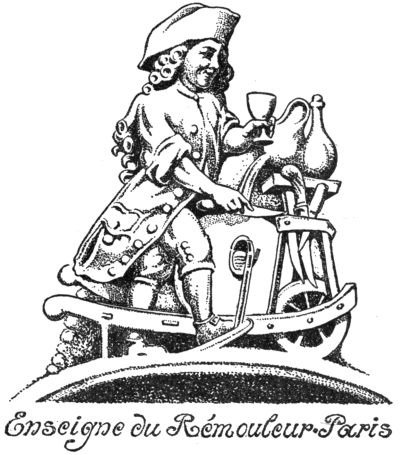
Enseigne du Rémouleur·Paris
Among the great Dutch masters Paulus Potter, Albert Cuyp, and Wouwerman are cited as occasional sign-painters. Even Potter’s famous “Jonge Stier” in The Hague is claimed as a butcher’s sign. It would perhaps seem like doing too much honor to the art of sign-painting if we numbered this remarkable work of the twenty-two-year-old artist among them. And what beautiful white horses, bathed in mellow sunlight, Cuyp may have painted for the “Rössle” taverns! Another Dutch artist, Laurens van der Vinne (1629-1702), is even called the Raphael among sign-painters. We do not know much about his work, but I am afraid he did not take this title as a compliment.
To find Rembrandt’s great name in connection with our art seems stranger still, but there is a tradition that copies of his pictures—we may think of his good Samaritan arriving with the wounded man before[Pg 155] an inn—were used as signs. As we shall see later, his own portrait was occasionally hung out by a patriotic and art-loving landlord over the tavern door.
Among English artists Hogarth, whom we already know as a keen observer of London signs, deserves the first place. He is supposed to be the author of a sign, not very gallant to the fair sex, called “A man loaded with mischief.” It represents a wife-ridden man. All kinds of delicate allusions hidden in the background of the composition seem to hint at the sad fact that this impudent woman on his back holding a glass of gin gets sometimes “drunk as a sow.” I doubt if Hogarth engraved this plate himself; it is signed “Sorrow” as the engraver and “Experience” as the designer. It would do little honor either to Hogarth the man or the artist.
All satirical art has this great deficiency, that it is hard for the public to judge whether the satire means to combat seriously the vices and errors of men or whether the smile of the satirist is not a smile of complacency. But such doubts must not detain us from visiting with good humor an exhibition[Pg 156] of signs, the spiritual promoter of which Hogarth seems to have been. At any rate, he contributed quite a few of his own works under the transparent pseudonym “Hagarty.”
Bonnell Thornton, who, after a brilliant journalistic career as editor of “The Connoisseur,” “The St. James’s Chronicle,” and other publications, received the greatest honor accorded to Englishmen, a final abode in Westminster Abbey, was the originator of this curious exhibition. Hogarth was at least on the “hanging committee.” The fact that the gates of the Signboard Exhibition were opened in the spring of 1762, at the same time as the official Exhibition of the Society for the Encouragement of Arts, provoked the anger of the “Brother Artists” and was the signal for a perfect storm among the newspapers. Furious articles stigmatized the enterprise as “the most impudent and pickpocket Abuse that I ever knew offered to the Publick.” “The best entertainment it can afford is that of standing in the street, and observing with how much shame in their Faces People come out of the House. Pity it will be, if all who are[Pg 157] employed in the carrying on this Cheat, are not seized and sent to serve the King.” In those days, “to serve the King” was evidently a severe punishment. The sign-painters in their turn hurried to protest their innocence and to refute “the most malicious suggestion that their Exhibition is designed as a Ridicule on the Exhibition of the Society for the Encouragement of Arts. They are not in the least prompted by any mean Jealousie to depreciate the Merits of their Brother Artists, ... their sole View is to convince Foreigners, as well as their own blinded Countrymen, that however inferior this Nation may be unjustly deemed in other Branches of the Polite Arts, the Palm of Sign-Painting must be universally ceded to Us, the Dutch themselves not excepted.” The committee even reprinted the articles and letters abusive of the Exhibition, “thanking the critics for so successfully advertising their efforts.”
No doubt, this exposition was a rare treat. Not only were all the painted signs “worse executed than any that are to be seen in the meanest streets, and the carved Figures,” as one of the curious who visited the show tells[Pg 158] us, “the very worst of Signpost Work, but several Tobacco Rolls, Sugar Loaves, Hats, Wigs, Stockings and Gloves, and even a Westphalian Ham hung round the room.” “The Cream of the whole Jest,” or, as the French would say, the “clou de l’exposition,” were two boards behind blue curtains with the warning inscription: “Ladies and gentlemen are requested not to finger them, as blue curtains are hung over in purpose to preserve them.” Since it was the custom in those days to hide pictures of too indelicate a nature in this fashion, the ladies, of course, did not dare to gratify their curiosity. But lascivious gentlemen who did not hesitate to lift the curtains found only the mocking words: “Ha! Ha! Ha!” and “He! He! He!”
The amusing catalogue of this extraordinary Exhibition has been published in full in the Appendix of Larwood and Hotten’s “History of Signboards.” It mentions many of our old acquaintances like “The Salutation, or French and English manners”; others are new to us, as “The Barking Dogs,” “a landscape at moonlight, the moon somewhat eclipsed by an accident.”[Pg 159] The peruke-maker’s sign, “Absalom hanging,” is again an old friend of ours. But the rhyme underneath—
seems to us not quite equal in poetical value to the following we read somewhere else:—
Some of Hagarty’s contributions have moralizing titles—as, “The Spirit of Contradiction,” representing two brewers with a barrel of beer, pulling different ways—which do not amuse us any more to-day. “The Logger-Heads,” or, “We are Three” (add: fools), is an old sign to which Shakespeare alludes in his “Twelfth Night” (ii, iii), where the Fool comes between Sir Toby Belch and Sir Andrew Aguecheek, and, taking each by the hand, says: “How now, my Hearts, did you never see the picture of We Three?” In country taverns sometimes two asses were painted on the wall, with the inscription: “We three asses.” The newcomer used to spell these words with great seriousness,[Pg 160] to the delight of the old customers. Another sign by Hagarty, “Death and the Doctor,” evidently goes back to the popular scenes of the “Dance of Death” and reminds us of other gruesome signs, the above-mentioned French signs, “La Mort qui trompe,” “La Fête de Mort” in Lyon and “La Cave des Morts” in Geneva. This physician’s sign probably resembled the rude woodcuts of the first printed editions of the “Dance of Death” from the fifteenth century: the doctor very unwilling to follow his colleague, “the sure Physician,” as Shakespeare has called Death. Some such picture was in the poet’s mind when he wrote the words in “Cymbeline,” v, v:—
This exhibition of Signboards inspired by Hogarth was the first and most amusing of its kind. More than one hundred years later an “Exposition Nationale des Enseignes parlantes artistiques” was arranged in Brussels with one hundred and forty-one different signs, and in 1902 the Prefet de la Seine organized in the City Hall of Paris a great[Pg 161] “Concours d’Enseignes.” Both represent serious and idealistic efforts to improve the artistic side of trade-signs, and by this means to ennoble the picture of the street so often disfigured by vulgar advertisements. Well-known artists, as the sculptors Dervé and Moreau-Vauthier, the painters Willette, Bellery-Desfontaines, Félix Régamey, and the popular collaborator of “Le Rire,” Albert Guilleaume, contributed to this exhibition and thus stimulated their colleagues to work for the Museum of the Street. Henri Détaille, the famous painter of battle scenes and pupil of Meissonier, was the spiritual author of the competition. In a letter to Grand-Carteret, the writer of a great, luxurious publication on the signs of Lyon, he had expressed the hope to educate and refine the artistic instinct of the masses through this medium of noble signs: “L’enseigne amusera la foule: rien n’empêche même qu’elle soit instructive tout en restant une très pure œuvre d’art.” He ends his letter with the following lines that give credit to his good heart and his sympathy for the common people: “Que les enseignes les plus belles les plus artistiques aillent surtout dans les quartiers[Pg 162] pauvres, populeux et privés, de toute manifestation d’art.” If we reflect that indeed the posters often are the only touches of brightness in the gray monotony of the poor quarters, we will heartily join Détaille in the wish that these posters might be pure and noble creations of art. Certain German posters, lithographed by such artists as Cissarz, seem to approach this ideal. The recent German War-Poster, “Gedenket Eurer Dichter und Denker,” may find an honorable mention in this connection.
In England the advice Détaille gave to the artists “à reprendre la tradition” has never been entirely forgotten, and even to the present day well-known artists have not disdained to paint signs occasionally. But before we enter the amiable society of contemporary artists we will show due honor to the great master Grinling Gibbons, who, so to speak, is an honorary member of the Sign-Makers’ Guild. To no visitor of London is the name of this sculptor unfamiliar. His master-hand carved the choir stalls in St. Paul’s Cathedral and many elaborate wood-sculptures in royal castles. One of his works is the famous golden cock in “Ye Olde Cock[Pg 163] Tavern” in Fleet Street. When the old house was torn down to make room for a branch office of the Bank of England, the noble bird was obliged to move across the street, where he now occupies the seat of honor in a large and rather dull room. I am sure he would prefer to roost in the little paneled room, up another flight, where Tennyson wrote the poem that made the creature immortal.
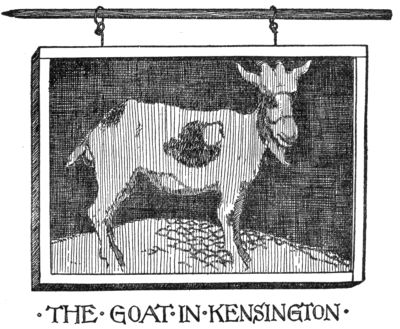
·THE·GOAT·IN·KENSINGTON·
Among the living English artists who painted signs we may mention Nicholson and Pryde, both experts in the art of the poster. Our illustration “The Goat,” which[Pg 164] hangs out on High Street, No. 3, in London, is attributed to them, but even the greatest admirer of Nicholson’s woodcuts will not find it worth while to pay a visit to this unattractive ale-house. There is more charm in “The Rowing Barge,” a signed work of G. D. Leslie, member of the Royal Academy, in Wallingford on the Thames, where we found it in the neighborhood of the old Norman Church of St. Leonhard.
It took even two Academicians, Leslie and L. E. Hodgson, to produce the “George and Dragon” sign in Wargrave, a fascinating little place buried amidst the greenery of giant trees. The damp climate has effaced and darkened the sign considerably; the owner of the inn has therefore taken it in and placed it on the garden side of the house, under the protection of a balcony. Wargrave has a few other remarkable signs, such as the one of the “Bull Inn,” which seems to be inspired by the beautiful picture of young Potter.
But not the least beautiful among signs are the works of unknown artists. All the admirable signs in forged iron, from the eighteenth century and the beginning of[Pg 165] the nineteenth, in southern Germany, belong to this group. Benno Rüttenauer, to whom we are indebted in many ways, has praised these pure works of art in an article on “Swabian Tavern Signs”: “They are a joy to the eye and caress it as the melody of a folk-song caresses the ear.” From what invisible sources springs their beauty? we ask, just as we do before the great, miraculous flowers of Gothic cathedrals rising mysteriously from the plain cornfields of northern France. Simple artisans were their inventors and creators, men who dared to let their own ideas grow in the free play of glowing, flexible iron, not yet disturbed by pattern-books and school wisdom.
More beautiful still than these are the eternal signs with which Mother Nature, the only real teacher of all true artists, invites the weary pilgrim to rest: the moon, the gentle shining stars, and the blossoming trees under whose perfumed branches we sleep so sweetly. This is the oldest inn; the Germans call it “Bei Mutter Grün,” and the French speak similarly of “loger à l’enseigne de la lune”; “coucher à l’enseigne de la belle étoile.” Nobody has sung the charms of this natural[Pg 166] inn more sweetly than the Swabian poet Uhland in his song, “Bei einem Wirte wundermild,” which we beg permission to quote in W. W. Skeat’s happy translation:—
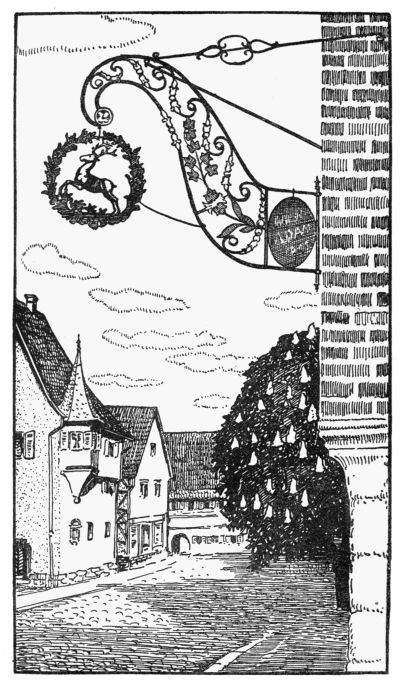
Zum Goldnen Hirsch
Leonberg, Württemberg
Like a prophetic star the sign seems to stand over the birth-house of many a poet. Or shall we not agree with Chateaubriand who saw in the eagle on the house in Bread Street, London, where Milton was born, an “augure et symbole”? And is it not a curious coincidence that the greatest French comedy-writer was born “à l’enseigne du Pavillon des Cinges dans la Rue des Étuves Saint-Honoré” in Paris? One of the most ingenious reconstructions of Robida (the architect of Vieux Paris, never to be forgotten by any visitor of the Parisian World’s Fair of 1900) was this birthplace of Molière’s that took its name from the mighty corner-beam, covered with carved monkeys. Truly, Milton had hoped less from the eagle on his father’s house than from the gentle star of Venus under which he was born. In his[Pg 170] family Bible, one of the many autograph treasures of the British Museum, he has registered his birth with his own hand: “John Milton was born the 9th of December, 1608, die Veneris, half an hour after 6 in the morning.” It availed him little to be born on the day of Venus, and the promise given to the “children of Venus” by an old German calendar of 1489, “They shall sing joyfully and free from care,” was not fulfilled in his life. His marriage was an unhappy one. Taine said of him: “Ni les circonstances ni la nature l’avaient fait pour le bonheur.” But the eagle on the house of his childhood proved to be a true symbol of his great future, for like an eagle he soared to the highest heights of poetical creation. Schiller was born in Marbach in the neighboring house to the “Golden Lion,” whose landlord his grandfather had been.
Considering that all houses in earlier times were distinguished by such symbols, even the most pious could not help being born under a sign. Calvin, the French Puritan, was even born in an inn, the “grasse hôtellerie des Quatre Nations” at Noyen in Picardy. On the other hand, merry souls[Pg 171] seem to have preferred saints as patrons of their birthplace, for Gavarni, the ingenious cartoonist, came into the world at Paris “à l’enseigne de Sainte Opportune, Rue des Vieilles Haudriettes.”
Sometimes Fate seems to mock the highflying ambitions of a great poet, by changing the house of his birth into a common public-house, as happened in the case of Chateaubriand, “the gentilhomme né” and his birthplace in the Rue des Juifs at Saint-Malo. On the other hand, Rabelais’s birthplace in Chinon, which became a tavern after his death, should have been one from the first hour of his life; for his was like the “étrange nativité” of his hero Gargantua: “Soubdain qu’il fut né, ne cria comme les aultres enfans: ‘Mies, mies’; mais à haulte voix s’escrioit: ‘À boire, à boire, à boire!’ comme invitant tout le monde à boire.” A little poem tells us the story how his study was transformed into a wine-cellar for merry revelers:—
The oldest poetical tradition of tavern signs we find, perhaps, in the songs of Villon, who sometimes has been called the Paul Verlaine of the fifteenth century, on account of his similar vicissitudes in life. A child of the people, he is not ashamed of his low origin:—
Living the life of the common people, he mingles freely with them, and in his wordly poems many a tavern adventure is told with zest. As a roaming scholar he wanders from place to place and, having rarely a penny in his purse, he acquires easily the art of dining without paying:—
And although he arrives at the tavern door riding shank’s mare, poor devil that he is,—
he is rich in fascinating stories to win the landlord’s favors and to secure ample credit.[Pg 173] Full of self-assurance, he demands always the best of everything, “boire ypocras à jour et à nuyctée” (day and night to sip Hypokras), one of Falstaff’s various favorite drinks.
Curious sign-names Villon mentions; as, the tin plate,—
or, the golden mortar (“le mortier d’or”), and even “the pestle.” The mortar was really a chemist’s sign. To-day, even, we may see, in a little French provincial town over the door of a druggist, a bear diligently braying some wholesome herb, in a mortar, an “Ours qui pile.”
The animal kingdom is represented by the mule, “la Mulle,” an inn frequented by Rabelais, too, the red donkey (“un asne rouge”),[Pg 174] and the white horse that, like all the painted horses, had the bad habit of never moving (“le cheval blanc qui ne bouge”). We have seen above that the “White Horse” was popular in Italy, too, although an old Italian proverb pretends that it is just as capricious as a beautiful woman and a source of continual annoyances:—
The most famous of all the cabarets immortalized by Villon is “le trou de la Pomme de Pin,” as he usually calls it. In the “Repues Franches,” from which we quoted the story of the Hotel du Pestel we read:—
We see that our poet-tramp hated adulteraters of wine (“les taverniers qui brouillent nostre vin”) not less sincerely than his old Roman colleague Horace. In his older days he regretted the dissipation of his youth, sadly reflecting upon what a comfortable age he could have now if ...
The tavern of the “Pomme de Pin” stood near the Madeleine Church—not the famous one we all know, but an old building in the “cité,” Rue de la Lanterne, which was pulled down in the time of the Revolution. Rabelais loved the place and praised this pineapple higher than the golden apple that young Paris once gave to Venus, thus creating endless troubles among men and gods:—
Sainte-Beuve has called this tavern, connected with so many proud names in French literature, “la véritable taverne littéraire, le vrai cabaret classique,” a title which to-day is deserved by the “Cabaret du Chat Noir,” the creation of such gifted artists as Henri Rivière, Willette, and, last but not least, Steinlen, the painter of its sign.
Next in literary celebrity stands “La Croix de Lorraine,” where Molière used to relax from his strenuous life as poet and actor[Pg 176] and get merry over the blinking glass, “assez pour vers le soir être en goguettes.” Among the guests ponderous Boileau sometimes appeared, although he seems to have taken his admonition in the “Art poétique,” “connaissez la ville,” rather seriously and to have made quite extensive studies of the Parisian public-houses. We find him in the “Diable,” who had his quarters in those days very near the Sainte Chapelle, and in “La Tête Noire,” a counterpart of “The Golden Head” in Malines where Dürer lodged on his journey through the Netherlands.
It would be amusing to count how many immortal works have been created over a tavern table. Have we not heard that in our days Mascagni wrote the incomparable overture to his “Cavalleria Rusticana” on the little marble table of a modern café? Racine is supposed to have written his “Plaideurs” on the tavern table of the “Mouton Blanc” in Paris, and this happy circumstance seems to have affected his style very agreeably and to have made the play easier for a modern reader than the solemn dramas which are so difficult to enjoy if one does not happen to be a Frenchman. How attractive a place this[Pg 177] “Mouton Blanc” was we might imagine from the little rhyme:—
What gifted fathers earned through tavern creations the prodigal sons sometimes lost again in gambling. Louis Racine spent the little fortune his father had left him in the “Epée de bois,” the same place where the comedy-writer Marivaux once gambled away his paternal heritage, regaining it soon, to be sure, by new and charming productions. It is mostly the stimulating company of comrades and fellow-artists, the freedom from petty household cares, that draws the poet to a quiet tavern corner; but sometimes, too, a charming landlady is the attractive force which may become so irresistible as to bind him forever in marriage bonds. Maybe, too, the tavern-bill was growing so hopelessly big that the poor dreamer saw no other solution. This was the reason why La Serre married the landlady of the “Trois ponts d’or,” it being understood that “contrat de mariage valait quittance alors entre cabaretière et poète,” as Michel-Fournier expresses the matter.
The tender relationship between the landlady and the poet-guest has given birth to numerous songs, from which we select the famous German Lied by Rudolf Baumbach:
and the not less charming poem of Molière’s successor, Dancourt, composed in honor of the landlady of the “Cabaret du petit père noire”:—
The classical literary tavern of England was without doubt “The Mermaid Tavern,” once situated in Bread Street not far from Milton’s birthplace. Here the famous club, founded by Ben Jonson, in 1603, assembled, among them the immortal Shakespeare. The fascination of this mermaid was still in the nineteenth century so great as to inspire Keats with his charming “Lines on the Mermaid[Pg 179] Tavern,” which we feel inclined to quote in full from Anning Bell’s illustrated edition, where it stands under a graceful reconstruction of the sign:—
Truly a capricious wind has carried away the old Mermaid sign into far and unknown regions, and to-day the scholars are disputing where really the famous house stood.
Two other taverns, less roughly handled by Father Time, may claim to be next in literary rank: “The Cheshire Cheese” and “The Cock,” both in Fleet Street. “Ye olde Cheshire Cheese,” or simply “The Cheese,” is not easy to find because it really stands on a narrow side-lane, the Wine Office Court. It has the great advantage of having preserved unchanged the character of a seventeenth-century tavern. Although venerable, it is not the original building, which was destroyed, together with many other public-houses in the great fire of 1666. Pious souls saw in the fact that the conflagration started in Pudding Lane and ended at Pie Corner an evident proof that the fire was sent from Heaven as punishment for “the sin of gluttony.” Shakespeare is said to have turned in not unfrequently at the old house of the “Cheshire Cheese” on his way to the Blackfriars’ Theatre in the Playhouse Yard, Ludgate Hill, where he was director for a time, or coming back for a twilight drink[Pg 181] after the performance, which in those times closed as early as five o’clock. In spite of the warning fire of 1666 the sin of gluttony is still readily committed in the “Cheshire Cheese,” whose specialty, a meat pudding,—containing not only roast beef, kidneys, and oysters, but sky-larks too!—might even be called a sin against the holy ghost of poetry. Once immersed in this pudding the divine singers are silent forever without the consolation of the children’s book:—
Some of these lark puddings are even shipped to Yankeeland, which sends every year countless pilgrims to the “Cheshire Cheese.” If possible, the American father of a family will take the seat of Dr. Samuel Johnson, the famous lexicographer, lean his head against the old paneling, which clearly shows the marks of the greasy wigs of the Doctor and his friend Oliver Goldsmith, and look at chick and child with an Olympian air, as if he wanted to say: “I am Sir Oracle, and when I ope my mouth let no dog bark.”
Among the guests and visitors at this[Pg 182] “house of antique ease” we find many famous names beside Johnson and the author of the “Vicar of Wakefield,” who dwelt in the neighboring house, No. 6, Wine Office Court; men like Swift, Addison, Sheridan, Pope, even Voltaire, who must have felt rather out of place in this atmosphere of beefsteak and ale. Among modern poets Thackeray and Dickens are foremost,—Dickens who has studied so intimately the taverns and inns of his country. Under the spell of these souls of poets dead and gone, writers of the present generation love to gather here in literary clubs, such as the Johnson Club, which has adopted as its device the Doctor’s classical definition of the word “club”: “An assembly of good fellows meeting under certain conditions.” Johnson, who spent almost all his life in taverns, favored not only “The Cheese” with his presence, but others, too, as “The Mitre,” in whose dark coffee-room Hawthorne once dined. This old house has entirely vanished from the ground, just as the still older inn “The Devil”—who, following his old custom of settling near a church, had established himself opposite St. Dunstan’s.[Pg 183] Thus we no longer “go to The Devil,” but if we have some serious business on hand we may step into “Child’s Bank,” which stands exactly on his former spot.
How important a rôle the waiters played in these old taverns we may realize from the fact that the portraits of two former head waiters decorate the walls of “The Cheshire Cheese.” Tennyson has celebrated another of these dignitaries in a long poem written in the Cock Tavern, beginning in this classical fashion:—
Dreaming over his glass of wine the poet sees in a sudden vision the prototype of the cock who once brought the head-waiter as a round country boy to the city, to the great bewilderment of his church-tower colleagues who witnessed his audacious flight:—
The description of this legendary cock, inspired evidently by the beautiful work of Gibbon’s master-hand, still to be seen in the modern Cock Tavern in Fleet Street, might well be called classical, and shall not be withheld from our readers:—

TRATTORIA DEL GACCO
Everybody who knows and loves the Swabian poet Mörike, the music for whose songs, composed by Hugo Wolff, have become the[Pg 185] property of the international brotherhood of music-lovers, will think of his “Old Church-Tower Cock,” strangely similar in feeling to Tennyson’s poem of “The Cock” and his brothers of the weather.
We are not surprised to find that the poets of the land of Wanderlust give special attention to taverns and signs. Besides Mörike, and Uhland, whose “Inn” we quoted above, Johann Peter Hebel, a son of the Black Forest, has always shown a special predilection for the sign and its wonders. In an untranslatable poem, “On the death of a tippler,” he celebrates his man as a diligent astronomer who never tires looking for shining “Stars,” a brave knight always ready to hunt up “Bears” and “Lions,” a pious Christian willing to do penitence at the “Cross,” a man who frequented the best society, including “The Three Kings,” his most intimate friends.
Germany may boast, too, of a classical literary tavern, the “Bratwurstglöckle” in Nuremberg, built directly against the walls of a church, the Gothic Moritz-Kapelle. Among its famous guests were the Mastersinger, Hans Sachs, and Dürer, Germany’s[Pg 186] greatest artist. Like a house out of a fairy tale it stands before us; we are only surprised that no fence of sausages surrounds it and that its door and window shutters are ordinary wood and not gingerbread!
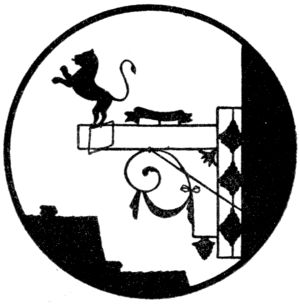
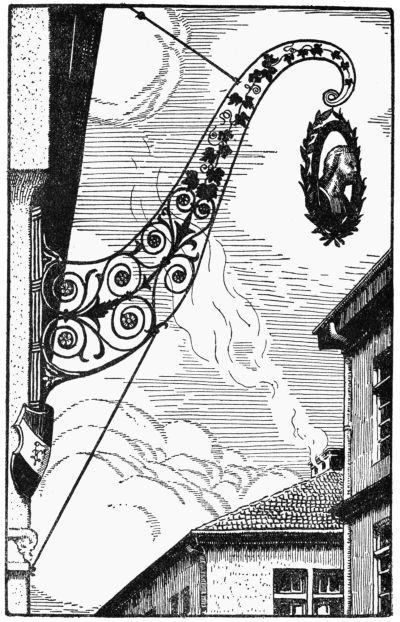
The King of Württemberg
Stuttgart
“Au-dessus de ma tête, Charles Quint, Joseph II ou Napoléon pendus à une vieillie potence en fer et faisant enseigne, grands empereurs qui ne sont plus bons qu’à achalander une auberge.”
At the first glance our peaceful sign seems to have nothing to do with politics whatsoever, except perhaps in so far as under its symbol the Philistines assemble, not only to drink and be merry, but, as a side-issue, to solve the world’s problems. The contrast of human strife and battle outside, somewhere in distant lands, with the undisturbed comfort of the tap-room has been for ages one of the chief fascinations of the tavern, and none has described this selfish attitude of the Philistine more graphically than Goethe in the conversation of the two citizens in his “Faust”:—
This opinion the other citizen, who reminds us curiously of certain modern neutrals, approves with the following words:—
This seems about all the political wisdom the tavern sign has to suggest; but if we investigate more closely the varying forms and continual changes of the sign we shall discover in its evolution nothing less than a little history of civilization in pictures. Every great event in the world’s history finds its echo in some transformation of the sign, that proves itself a sensitive indicator for the popular valuation of leading men and important occurrences. In the eagle-names of the Roman signs we seem to hear the conquering wings of the Roman eagles soaring over the world, and on the Cymbrian shield over the cocktavern on the Forum we read the pride of the victorious Roman soldier.
In our chapter on “Heraldic Signs” we recognized the relationship between the land[Pg 191]lords and the ruling powers. The swinging sign of a “crown” means the rule of kings, and thankful subjects who enjoy the peace secured by their monarch and the comfort of settling down in “The Crown” to a blessed meal. It means good times, efficient landlords and easy food-supply, if you get such an excellent and abundant dinner as Heine was offered on his wanderings through the Harz[Pg 192] by the tavern-keeper of “The Crown” in Klausthal: “My repast consisted of spring-green parsley-soup, violet-blue cabbage, a pile of roast veal which resembled Chimborazo in miniature and a sort of smoked herrings, called Bückings from their inventor William Bücking, who died in 1447, and who, on account of the invention, was so greatly honored by Charles V that the great monarch in 1556 made a journey from Middleburg to Bievlied in Zealand for the express purpose of visiting the grave of the great fishdrier. How exquisitely such dishes taste when we are familiar with their historical associations!”
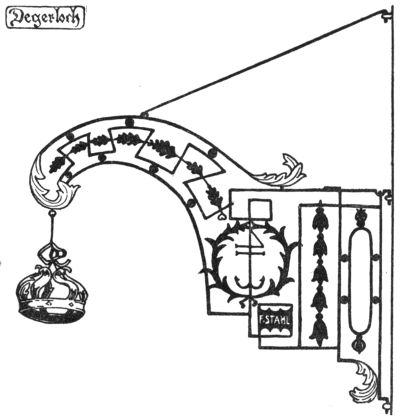
Degerloch
And do not the kings themselves appear on the sign? The “Three Kings” were originally the “Wise Men” from the East. How the Catholic Church came to represent them as kings we read in Fischart’s quaint old German of his amusing “Bienenkorb” of 1580: “Und das sie weiter auss den treien Weisen aus Morgenland trei König gemacht hat und den eynen so Bechschwarz als eynen Moren, ist aus den Weissagungen Salomonis oder Davids gefischet, die da sagen, dass die König aus Morenland Christum anzubeten[Pg 193] kommen werden.” The East, the land of the morn, was thus confused with the land of the Moors which we should rather seek to the south of Bethlehem. On “Three Kings’ Day,” of course, the taverns of this name were scenes of special merriment, the good Catholics joyfully shouting, “The King drinks.” “The three gentlemen,” as Carlyle calls them disrespectfully, are buried in the Cologne Cathedral, but their memory is honored still by many a visitor of a “Three Kings” tavern in good Rhenish wine which our forefathers called the theological wine. We find the sign of the famous travelers from distant lands especially on the great roads of commerce leading from Italy over the Alps, so in Augsburg and Basle. Originally a royalist symbol of the landlord’s loyalty to monarchy, of his eagerness to serve crowned guests if fortune should lead them his way, it was changed in the times of the Revolution to the democratic “Three Moors,” and the first landlord who is said to have deprived his three kings of their crowns was the landlord in Basle. Maybe time helped him to make this change, slowly wearing away the gilded glitter of the crowns and darkening the kings[Pg 194] to black-a-moors. To-day the famous house in Augsburg, where Charles V once lodged as guest of the rich banker Fugger for more than a year, is called “Three Moors.” The traveler still may see the big fireplace in which the generous merchant burned all the imperial promissory notes.
But whatever the explanation of this “Three Moors’” sign may be, there can be no doubt that the Revolution had a noticeable influence on signs in general. The inn “Zum Rosenkrantz” in Strassburg was called after 1790 “A la couronne civile,” to please the rationalistic worshipers of the “Supreme Being,” and countless king-signs were sold as old iron. Sébastien Mercier, in his “Tableau de Paris,” has given a merciless report of this great catastrophe which swept away so many of the signs which we have learned to respect and to love: “Chez les marchands de ferrailles du quai de la Mégisserie, sont des magazins de vieilles enseignes, propre à décorer l’entrée de tous les cabarets et tabagies des faubourgs et de la banlieu de Paris. Là tous les rois de la terre dorment ensemble: Louis XVI et Georges III se baisent fraternellement; le roi de[Pg 195] Prusse couche avec l’impératrice de Russie, l’empereur est de niveau avec les électeurs; là enfin la tiare et le turban se confonde. Un cabaretier arrive, remue avec le pied toutes ces têtes couronnées, les examine, prend au hasard la figure du roi de Pologne, l’emporte et écrit dessous: Au grand vainqueur. Un autre gargotier demande une impératrice; il veut que sa gorge soit boursouflée, et le peintre, sortant de la taverne voisine, fait présent d’une gorge rebondie à toutes les princesses d’Europe. Le même peintre coiffe d’une couronne de laurier une tête de Louis XV lui ôte sa perruque et sa bourse, et voilà, un César.—Toutes ces figures royales ont d’étranges physionomies et font éternellement la moue à la populace qui les regarde. Aucun de ces souverains ne sourit au peuple, même en peinture; ils out tous l’air hagard ou burlesque, des yeux éraillés, un nez de travers, une bouche énorme....”
We see those were bad days for kings, even for painted ones. If the landlord had Jacobin blood in his veins he would not content himself with such harmless changes as removing the painted crowns. He would call his tavern no longer “Le Roi Maure,”[Pg 196] but forthwith “Le Roi Mort,” and on the sign the picture of the dead king Louis XVI would testify to his stanch republicanism. Or he would choose as sign-hero Brutus the famous regicide. Dickens has introduced us to such a tavern, “The good Republican Brutus,” in the “Tale of Two Cities,” and his picture of the place, although in a book of fiction, shows clearly the colors of historical truth: “It had a quieter look than any other place of the same description they had passed, and though red with patriotic caps was not so red as the rest.” The guests were a rather suspicious-looking crowd. One workman with bare breast and arms reads aloud the latest terrible news to the rest who listen attentively. All are armed, some have laid their weapons aside to be resumed, if needed. In the classical chapter “The Wine-Shop,” where he describes the hopeless misery of the poor people crowded together in the narrow streets of the St. Antoine quarter, he sees even in the merchants’ signs symbols of misery or threats of future atrocities: “The trade-signs (and they were almost as many as the shops) were all grim illustrations of Want. The butcher and the[Pg 197] porkman painted up, only the leanest scraps of meat, the baker the coarsest of meager loaves. The people rudely pictured as drinking in the wine-shops croaked over their scanty measures of thin wine and beer.... Nothing was represented in a flourishing condition, save tools and weapons; but the cutler’s knives and axes were sharp and bright, the smith’s hammers were heavy, and the gunmaker’s stock was murderous.”
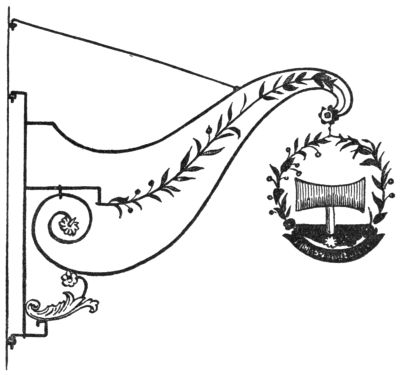
It was in a tavern in Varennes that the fate of Louis XVI was sealed. Here the fugitive[Pg 198] king was arrested and forced to go back to Paris to pay with his blood the debt of sins which his ancestors had accumulated. “Forty-eight years after the royal coach was stopped in this town,” says Victor Hugo, “I saw hanging from an old iron bracket the picture of Louis Philippe with the inscription: ‘Au grand Monarque.’” Nowhere do we observe quicker changes than in governments and tavern signs, remarks the German tramp-poet Seume; and Victor Hugo indulges in similar reflections, passing in review the signs of the last one hundred years from Louis XV to Bonaparte and Charles X: “Louis XVI s’est peut-être arrêté au Grand Monarque, et s’est vu là peint en enseigne, roi en peinture lui-même.—Pauvre ‘Grand Monarque?’” he exclaims in pathetic pity. This supposition of Hugo’s, however, is not correct, as we learn from Carlyle, who, scrutinizing with the prophetic vision of a poet the darkness of the past, possessed at the same time the exactness and sincerity of a true historian and who has given us, based on a personal visit to the locality, the following description of the nocturnal scene: “The village of Varennes lies dark and slumberous,[Pg 199] a most unlevel Village of inverse saddle-shape, as men write. It sleeps; the rushing of the River Aire singing lullaby to it. Nevertheless from the Golden Arm, Bras d’or Tavern across that sloping Marketplace, there still comes shine of social light....”
Even the American Revolution left its traces on the tavern signs of the Yankeeland. The old Baptist pastor and Professor of Theology, Galusha Anderson, who has given us, in his charming book, “When Neighbors were Neighbors,” in his simple way a kind of social history of the early United States, mentions signs that he saw in his youth “where the English red-coats were represented flying before our revolutionary forefathers.” And Washington Irving has given us, in his “Rip Van Winkle,” a classical example of the political changes the signboard had to undergo. When this curious dreamer and unhappy husband, after many years of mysterious absence, came back to his native village, nothing perhaps surprised him so much as to find on the old tavern the strange words, “The Union Hotel, by Jonathan Doolittle,” and to see even the good old sign strangely altered: “He recognised on the[Pg 200] sign, however, the ruby face of King George, under which he had smoked so many a peaceful pipe; but even this was singularly metamorphosed. The red coat was changed for one of blue and buff, a sword was held instead of a sceptre, the head was decorated with a cocked hat, and underneath was painted in large characters, General Washington.” Thus he received from the signboard the necessary instruction on the great changes that had taken place during his absence, how his country had developed from an English Colony to a free Republic.
There are still a few signs in existence that might give us an idea how such old American signs probably looked. We refer especially to the “Governor Hancock” sign in the old Boston State House and a couple of amusing signs in the little historical museum at Lexington.
In its long political career the sign was not spared the humiliation of being used as gallows. One of the first victims of the French Revolution was Foulon. He was charged with making the people eat grass; and now a raging mob forced into his dead mouth the food he had proposed for others.[Pg 201] According to tradition this old sinner was hanged to a lantern on the corner of the Place de la Grève and the Rue de la Vannerie. But this is contradicted by such an old Parisian as Victorien Sardou, who says that Foulon was hanged to a sign which, as he remembers well from his childhood days, was still to be seen, under Louis Philippe, although nobody really seemed to give attention to it in those days of Romanticism.
Another gruesome story we are told by Macaulay, how under James II, after the defeat of the unhappy Duke of Monmouth, the partisans of the pretender were suspended from a signpost before a tavern in Taunton by order of a certain Colonel Percy Kirke. “They were not suffered even to take leave of their nearest relations. The signpost of the White Hart Inn served for a gallows. It is said that the work of death went on in sight of the windows where the officers of the Tangier regiment were carousing, and that at every health a wretch was turned off. When the legs of the dying men quivered in the last agony, the colonel ordered the drums to strike up. He would give the rebels, he said, music to their dancing.[Pg 202] The tradition runs that one of the captives was not even allowed the indulgence of a speedy death. Twice he was suspended from the signpost, and twice cut down. Twice he was asked if he repented of his treason, and twice he replied that if the deed were to do again, he would do it. Then he was tied up for the last time.”
The Chief Justice and Lord Chancellor Jeffreys, who continued the work of persecution against the partisans of the Duke of Monmouth,—the man whose Bloody Assizes will not be easily forgotten in England,—once nearly paid with his life the foolish desire to climb up on a signpost in a happy hour of complete intoxication. After a wild orgy in company with the Lord Treasurer, he and his companion decided to undress until they were “almost stark naked” and to drink the king’s health from the airy height of a signpost. Jeffreys took a severe cold and alarmed not a little the king, who feared the irreparable loss of such a valuable servant.
After the uncanny stories of the signpost’s function as a gallows, we find a certain comfort in hearing that the sign occasionally offered a refuge to persecuted political offenders.[Pg 203] In the days of the Corsican, the partisans of the Bourbons, called by the beautiful name of “Chouans,” were happy to find such a refuge, “une cache fameuse,” behind the big sign of the perfumer Caron. The persecuted Chouan had only to step out through a window and to close the blinds behind him and he was perfectly safe against the detectives of Fouché, the chief of the police. If the fugitive, however, made a blunder and stepped by mistake into the barber shop of M. Teissier, he was undone; because this was the man who had the honor of shaving the Cæsarean face of Napoleon.
Before the French Revolution another great event in the world’s history had produced considerable changes on the signboard—the Reformation. We have already noticed how the new ideas and motives of the Renaissance influenced, not only the sculptured frame of the sign, but created new forms, such as the Dolphin, the Siren, the Pegasus, the Sagittary, Fortuna, Apollo, Phœnix, Minerva, Hercules, Castor and Pollux, Bacchus, all favorite themes of this classical period. The discovery of America at the same time brought the “Wild Man”[Pg 204] into great popularity, and the newly introduced tobacco, “the filthy weed,” caused the creation of countless Indian and Huron signs, “black-a-moors and other dusky foreigners.”
The Reformation itself had a more negative effect on the sign. It tried to eliminate or to change the old saint signs. Cromwell in England declaimed against Catholic-sounding tavern names. “St. Catherine and Wheel” was changed to “Cat and Wheel,” and degenerated further into “Cat and Fiddle,” a sign still popular in England and celebrated in the famous children’s rhyme :—
On some signs the fiddling cat inspires with its music a cow to jump in ecstasy over a grinning moon. Thus we see everywhere the old religious motives and symbols turned into ridicule and blasphemy. This process began at the end of the Middle Ages, as the study of miniatures and of cathedral sculptures will amply prove. We cannot be surprised, therefore, to find such anti-papal signs as “Le cochon mitré” in Compiègne. The[Pg 205] mediæval illuminators and sculptors loved to “hommifier” the swine and to attack under this disguise hypocritical and voluptuous priests. In the “Doctrinal rurale” of Pierre Michault of 1486 (in the National Library at Paris), we see a fat monk in the pedagogue’s chair, representing “concupiscence,” and evidently making such shocking remarks that his girl pupils put their fingers in their ears, while in the delicate framework of the miniature a preaching swine reveals the real character of this strange teacher.
The touching scene of the “Salutatio,” which inspired the artists of the Renaissance with such noble creations as Donatello’s marble relief in Florence, is degraded now to a ridiculous bowing and scraping between a lady and her partner or between two stylish gentlemen. The fanatical Puritans who thundered even against the harmless Christmas customs, so dear to the people, of course took offense at the use of the cross for a sign and in 1643 forced the landlord of the “Golden Cross,” in the Strand, London, to take his “superstitious and idolatrous” sign down. It is a curious irony of fate that Cromwell, who to the present day is made[Pg 206] responsible for nearly all destructions in English cathedrals and who probably was an enemy, not only of Catholic but of all signs, was himself made an object of the signboard.
In England more than anywhere else the sign stands for heroes and hero-worship. Peter the Great and his visit to London were remembered in “The Czar’s Head”; English admirals and great generals like Wellington and the Prussian King Frederic, “the great Protestant hero,” all receive “signboard-honors.” London possessed still in 1881 thirty-seven “Duke of Wellington” taverns.
No less patriotic are the Dutch sign-painters, who love to picture their own celebrities Rembrandt, Ruysdael, or Erasmus of Rotterdam and the beloved Princes of Orange. One of them, the future King William III of England, we find even as a boy on a signboard with the inimitable Dutch inscription:—
But other “merkwaardige Personen,” great men of other nations, too, receive their share of this popular homage: Frederic the Great, Schiller, Gustavus Adolphus, and even old[Pg 207] Cicero. Sometimes the popularity of a hero passes quickly. The English Admiral Vernon had hardly received signboard honors when he had to yield his place to Frederic, the “Glorious Protestant Hero,” as he was called after the battle of Rossbach. As a rule, a few changes in the costume of the portrait were considered sufficient by the landlord, who rarely indulged in the luxury of an entirely new picture for the new hero. To the English statesman, Horace Walpole, these rapid changes on the signboard suggested the following melancholy remarks: “I pondered these things in my breast and said to myself, ‘Surely all glory is but as a sign!’”
The French people were more loyal to their Bonaparte signs, long after the beloved emperor had been dethroned. For a long time the “napoléonisme cabaretier” refused to capitulate, says Carteret. In the country even serious fights were sometimes caused by the signs of the Imperialists, who ten years after Waterloo showed still the famous words, “La garde meurt et ne se rend pas,” or represented the meeting of Napoleon and Frederic with the inscription, “Le soleil luit pour tous les héros.” A tavern-keeper near Cannes,[Pg 208] where Napoleon landed on his return from Elba, to reconquer France, honored the memory of the great man who rested in his inn with the words:—
On the other hand, we find the men who delivered their country from the yoke of the Corsican equally honored in signs; the tavern in which these great men had rested were for a long time held sacred by the people. “In Innsbruck, in the ‘Golden Eagle,’” we read in Heine’s “Reisebilder,” “where Andreas Hofer had lodged, and where every corner is still filled with his portraits and mementoes, I asked the landlord, if he knew anything of the ‘Sandwirth.’ Then the old gentleman boiled over with eloquence....”
To our great astonishment, we find even the idea of an invasion on old English tavern signs. We know well this fear of invasion is nothing new with our cousins. “Down the northeast wind the sea-thieves were always coming. England should always beware of the northeast wind. It blows her no good,”—that is the lesson the English school-children[Pg 209] already learn in such books as C. R. L. Fletcher’s “History of England” (Oxford, 1911), to which Rudyard Kipling has contributed most passionate songs of patriotism. As early as 1753 the English had the black suspicion that Frederic the Great might land fifteen thousand of his Spartan Prussian soldiers on their coast, as if he just then had nothing else to do. Carlyle has refuted these suspicions as ridiculous: “King Friedrich distinguished himself by the grand human virtue of keeping well at home—of always minding his own affairs.” In these days of the Entente Cordiale and its result the World-War, the south wind, blowing from France, is entirely forgotten, but nevertheless it is just there that the most serious preparations for an invasion of England have been made repeatedly. In the year 1756 the cry resounded: “If France land on us, we are undone”; and in 1759 Admiral Conflans actually attempted to execute the idea with eighteen thousand men, but the enterprise failed completely, “not on the shores of Britain, but of Brittany.” Under Napoleon the danger increased, but after Nelson’s victory of Trafalgar, Napoleon had to abandon his maritime plans. The regained[Pg 210] feeling of security was manifested in many caricatures mocking Napoleon, among which we have to reckon the sign “Old Bonaparte.” Using the familiar motive of “The ass in the bandbox,” the sign-painter represents the French Emperor riding on a donkey and sailing in a bandbox over the Channel to fight “Perfidious Albion.”
In this connection we ask permission to tell the story of another donkey-sign. Joseph II, Emperor of the old German Empire, whom we might call the “traveling Kaiser” of the eighteenth century, loved to put up at simple inns; even when he was invited by Frederic the Great, at their first interview in Neisse, to lodge in the castle, he preferred the liberty of having his ease at “The Three Kings.” Once, in Maestricht, he stopped at a hotel called “The Gray Donkey,” and gave the landlord as proof of his complete satisfaction the privilege to call his house hereafter “Kaiser Joseph” and to paint on his sign the equestrian portrait of his noble guest. But the Dutch customers did not recognize their old tavern under such a glorious name, and the landlord was finally obliged to put under[Pg 211] the imperial picture the odd words: “The Real Gray Donkey.” Duke Charles of Württemberg, who knew this fancy of the Emperor, once pleased him enormously by hanging a big sign, “Hotel de l’Empereur,” out over the portal of his castle in Stuttgart, himself receiving the imperial visitor in the humble costume of an obedient landlord.
More serious political events are equally reflected in the history of the sign. When Richard III lost throne and life at Bosworth in 1485, the Black Bears, the heraldic animals of his royal escutcheon, disappeared from the tavern sign and were replaced by the Blue Bear of the Count of Oxford. It was even a dangerous thing in those days to play with the seemingly harmless sign. A landlord of a Crown inn, who once said jokingly that he intended to make his son the heir of the crown, was accused of high treason and had to suffer death in 1467. Another sign, still popular in England, “The Royal Oak,” came into vogue after the restoration of Charles II, because it reminded the good people of the oak in which the persecuted king had found a shelter against[Pg 212] his enemies. When Charles I’s proud head fell, a day after his execution, “The Crown” of the poet tavern-keeper Taylor, who possessed the courage of his conviction, appeared veiled in black.
The sign in mourning occurs again, but this time for a very frivolous reason. In 1736 the tavern-keepers, disgusted with the “New Act against spirituous liquors,” covered their signs with “deep mourning” as symbol of protest. That this law had not been too severe is evidenced by Hogarth’s engraving “Gin Lane,” published fifteen years later, where we read over a tavern the disgusting announcement: “Here gentlemen and others can get drunk for a penny, dead drunk for twopence.”
Macaulay has pointed out the great importance of public-houses as political meeting-grounds. Party congresses of the Liberals were held in the early day in “The Rose,” but in general the Whigs preferred places that had a punchbowl on their sign, punch being at the end of the seventeenth century not only a very popular beverage, but decidedly a “Whig drink,” while the Tories drank mostly—noblesse oblige—wine[Pg 213] or champagne. We find the punchbowl either alone or in more or less logical combinations, as “Ship and Punchbowl,” “Parrot and Punchbowl,” “Half-Moon and Punchbowl,” and the like.
An old American sign, “The Federal Punch,” is evidently a revised edition of the Whig sign of the mother country. The business of imbibing the party drink was not forgotten in these political meetings. In fact, the Tories attended to it one time so thoroughly in their Apollo Tavern in Fleet Street that they were unable to execute their own decision to go “in a body” to King William to present him an address of thanks. “They were induced to forego their intention; and not without cause: for a great crowd of squires after a revel, at which doubtless neither October nor claret had been spared, might have caused some inconvenience in the present chamber.” Finally they decided to send as their representative an elderly country gentleman who was, for a wonder, still sober.
Beside these respectable meeting-places of the two great parties there were “treason taverns,” suspicious ale-houses, where plotters[Pg 214] and hired murderers, not without the encouragement of the exiled king James II, forged their black plans against the life of William, the Prince of Orange. One of these places had the fitting name “The Dog” in Drury Lane, “a tavern which was frequented by lawless and desperate men.”
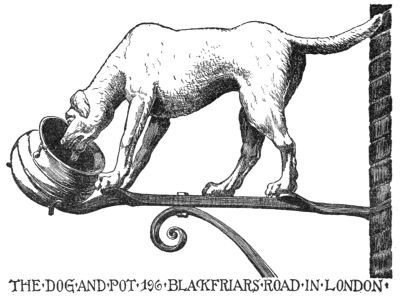
THE·DOG·AND·POT·196·BLACKFRIARS·ROAD·IN·LONDON·
We will end our enumeration of politically important taverns with the “Cadran Bleu” in Paris, where the Marseillais were greeted by the Parisians after they had completed their long journey across the whole of France, singing for the first time the famous song of the Revolution: “Marchez, abattez[Pg 215] le tyran.” “Patriot clasps dusty patriot to his bosom, there is footwashing and reflection: dinner of twelve hundred covers at the Blue Dial, Cadran Bleu.”
To the present day the right to assemble freely in the tavern, “this temple of true liberty,” is suspiciously guarded by all parties. To the present day the tavern serves all kinds of political and social clubs and sometimes even burial societies similar to those of which Washington Irving has told us such amusing stories, as “The Swan and Horseshoe” and “Cock and Crown,” once flourishing in the heart of London, in Little Britain.
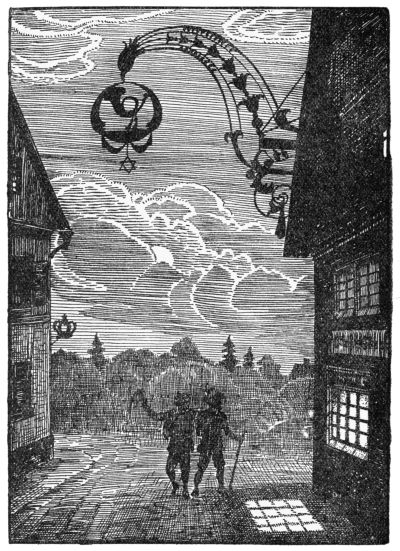
Zur Post Bietigheim,
Württemberg
“Ici toute liberté, Monsieur, comme si nous étions au cabaret.”
There is a surprising parallelism between the fathers of these two greatest men of the eighteenth century. These fathers, whom narrow-minded critics usually call pedants, transmitted to their sons the great gift of “life’s serious conduct.” Rarely has the old Councillor Goethe found so much just appreciation as Carlyle has shown for Frederic William I. The character of both the sons constitutes a happy combination of this serious paternal heritage and the joyful element of sanguine optimism. Both, although they owe perhaps most to their fathers, feel themselves drawn to the softer natures of their mothers, who hardly ever refused them any wish. And most of us prefer to share with them the love of their charming mothers, Frau Rath and Sophie Dorothea,—because it is always more agreeable to be loved than[Pg 220] to be educated,—and reserve for the fathers at best a cool esteem.
Travel for pleasure or sport was unknown to the old Spartan King of Prussia, as indeed it was to his greater son, who did not even appreciate the sport of hunting. When they traveled it was for the inspection of the administration of their country or to review their troops. Old Frederic William, in his great simplicity, preferred even to pass the night in airy barns than to sleep in stuffy rooms. “Dinner-table to be spread always in some airy place, garden-house, tent, big clean barn,—Majesty likes air, of all things;—will sleep too, in a clean barn or garden-house: better anything than being stifled, thinks his Majesty.” We never hear that he stopped at inns, and Frederic, too, we meet only rarely in taverns, once in Braunschweig in Korn’s Hotel, where he was received one night in the Freemasons’ lodge very secretly because his severe papa despised such childish fooleries utterly. Occasionally, perhaps, while in Potsdam he visits inns like “The Three Crowns,” where one could find better food, he says, than at the table of his Mecklenburg cousins in their castle Mirow.[Pg 221] In the first year of his reign, when he traveled incognito to French Alsace, he had very distressing experiences in different taverns. In a letter to Voltaire he describes in French verses the various accidents of this trip:—
Traveling all day in the worst of weathers, as if the last day of judgment had come, and in the evening to get a poor meal in a miserable tavern—and a large bill:—
The landlord of the “Post” in Kehl demands passes from Frederic and his companions, and Frederic fabricates them himself with his Prussian seal. Again in Strassburg they present the same passes to the custom officials, not without adding a gold coin:—
Here they stop at “The Raven,” where Frederic immediately began to study the French people. His judgment is not very flattering, although he communicates it to his French friend:—
In the evening he invites even French officers to dine with him and the following morning goes to a military review. Here one of his own soldiers, a Prussian deserter, “un malheureux pendard,” recognizes him; he quickly hurries back to “The Raven,” pays his bill, and leaves Strassburg, never to see it again.
Like the old king, Frederic preferred to stop in rectories when traveling through the Prussian lands, but sometimes was prevented from doing so by his very faithful but very independent coachman Pfund. If the pastor had forgotten to give this important person his due tip on the last visit, Pfund would surely cut him on future occasions, and force his old master to go on to the next town, where he was sure to find a host of better[Pg 223] manners. This sin of omission was rarely committed by pastors who received the honor of a royal visit, because they could very well afford to humor old Pfund a little, when they themselves received from the otherwise economical king the handsome “royalty” of fifty dollars for a dinner and one hundred dollars for dinner and a night’s lodging. General von der Marwitz has told us the story of how Pfund once opposed the king, who was tired and wanted to stop in the rectory of Dolgelin, by saying the sun was not yet down and they could well reach the next town, and how the old king patiently submitted to the will of his Automedon. But there is a limit even to the patience of old kings, and on one occasion, when Pfund went too far in his rudeness, Frederic rebelled, and, to teach his coachman morals, ordered him forthwith to cart manure and fagots with a team of donkeys. After a year the king happened to meet him, busily engaged in his new and modest occupation, and kindly inquired: “How d’ye do?” The coachman’s classic answer August Kopisch has celebrated in a song which we venture to translate:—
Goethe’s father, although himself the son of a landlord, disliked inns and public-houses very keenly, as we read in Goethe’s autobiography, “Dichtung und Wahrheit”: “This feeling had rooted itself firmly in him on his travels through Italy, France, and Germany. Although he seldom spoke in images, and only called them to his aid when he was very cheerful, yet he used often to repeat that he always fancied he saw a great cobweb spun across the gate of an inn, so ingeniously that the insects could indeed fly in but that even the privileged wasps could not fly out again unplucked. It seemed to him something horrible, that one should be obliged to pay immoderately for renouncing[Pg 225] one’s habits and all that was dear to one in life and living after the manner of publicans and waiters. He praised the hospitality of the olden time, and reluctantly as he otherwise endured even anything unusual in the house, he yet practiced hospitality....” This excessive aversion to all inns the great son inherited from his father, although he admitted it was a weakness. We are therefore not surprised to see the student Goethe, when he for the first time traveled full of longing to Dresden in the yellow coach, lodge in the modest quarters of a philosophical cobbler, whose home seemed to him as romantic and picturesque as an old Dutch painting. Perhaps it was the memory of this interior that inspired Goethe later, when he was called “Doktor Wolf” by his proud mother, to arrange in “The Star” at Weimar, in honor of the Duchess Anna Amalie, a “festivity in clair-obscure” with the distinct purpose of creating a Rembrandt scene.
But before we wander in the far world with the student and doctor, let us take a stroll through the Frankfurt of his childhood and admire the many signs that still[Pg 226] decorated, not inns alone, but also, houses of private citizens. The “Goldene Wage,” situated on the Domplatz and built in 1625, as well as the “Grosse Engel,” opposite the Römer, are still standing, and are filled to-day with the treasures of art-loving antiquarians. Recollections of his childhood passed through Goethe’s mind when he described in “Hermann und Dorothea” the pharmacy “Zum Engel,” near the “Golden Lion” on the market-place, and the old bachelor chemist who was too stingy to regild his angel-sign:—
The father of some boy friends of Goethe’s, a Herr von Senckenberg, “lived at the corner of Hare Street, which took its name from a sign on the house that represented one hare at least if not three hares.” Von Senckenberg’s three sons were consequently called[Pg 227] the “three hares,” which nickname they could not shake off for a long while.
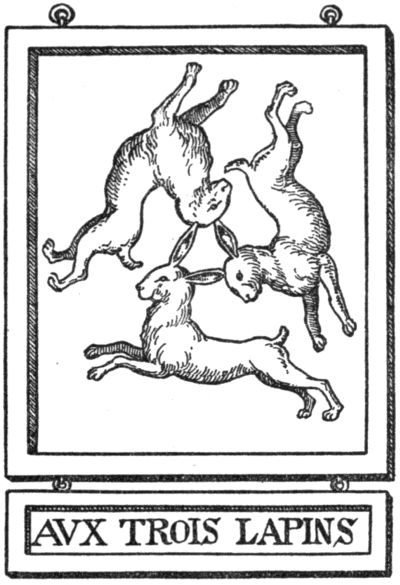
AVX TROIS LAPINS
It was in the “Golden Lion” at Frankfurt that Voltaire was arrested and interned on his word of honor until his luggage containing the stolen “Œuvre de Poésies” of Frederic the Great should arrive. In these poems the king had ridiculed several crowned heads, and it was of the utmost importance for him to get them back before the revengeful Frenchman could make use of them against him. But for some reason or other the trunks did not arrive, and Voltaire, losing patience and “without warning anybody, privately revoked said word of honor” and tried to escape, an attempt that failed and ended in a tragic-comic fashion. Father[Pg 228] Goethe, who loved to tell this story to his children as a warning example never to seek the favors of princes, does not agree here with Carlyle in the name of the tavern, but says it was “The Rose” in which “this extraordinary poet and writer was held as a prisoner for a considerable time.” When the fugitive was brought back, the landlord of the tavern refused to take him in again, and the “Bock” became for the rest of the time his involuntary lodging-place.
In spite of this bad example and his father’s distinct warnings, Goethe in 1778 accepted the invitation of the Duke of Weimar to the “Römische Kaiser” in Frankfurt, where he was “joyfully and graciously” received, and where definite arrangements were made for his removal to Weimar.
After the death of Goethe’s father, Mutter Aja sold the old homestead on the Hirschgraben and took a flat in the “Goldenen Brunnen” on the Rossmarket, where the golden fountain of her good humor continued to flow for all her friends, but where she no longer had such facilities for entertaining guests as in the roomy house of old. When, therefore, her daughter-in-law[Pg 229] and her grandson, the “liebe Augst,” came to visit her, she ordered rooms for them in “The Swan.” Her apartment in the “Golden Fountain” we know from her own lively description in a letter to her son, who visited her here several times before her death in 1808.
Let us now accompany the student Goethe to Strassburg and pay a visit to the inn “Zum Geist,” where his friendship with Herder, so important for his future development, was formed. “I visited Herder morning and evening, I even remained whole days with him ... and daily learned to appreciate his beautiful and great qualities, his extensive knowledge, and his profound views.” In Leipzig, the next university where Goethe studied, he lived in a house, between the old and the new market, which was called after its sign “Die Feuerkugel.” One of the first calls he made was to the literary dictator Gottsched, who “lived very respectably in the first story of the ‘Golden Bear,’ where the elder Breitkopf, on account of the great advantage which Gottsched’s writings had brought to the trade, had assured him a lodging for life.” This Bernhard Christoph Breitkopf[Pg 230] was the inventor of music printing and the founder of the famous publishing firm of to-day. His house, the “Golden Bear,” number 11 Universitätsstrasse, is to-day the home of the Royal Saxon Institute for universal history and the history of civilization, founded by the distinguished historian Lamprecht. In Goethe’s day Breitkopf’s son built a great new house opposite the “Golden Bear” which was called “Zum Silbernen Bären.”
A very popular sign in those days, in Germany, and especially in the neighborhood of Frankfurt, was the pentacle. Goethe calls it simply the beer-sign in his autobiography, where he tells us a charming story based on an ingenious and humorous interpretation of the two triangles which compose the sign. While still living as a young lawyer in Mutter Aja’s house, he entertained two distinguished visitors, the famous Lavater and the educational reformer Basedow. To amuse them he arranged carriage drives in the pleasant country around his native town. We see the young fire-brand sitting between these two dignified men:—
On one of these excursions Basedow had offended the pious and sweet-tempered Lavater by his cynical remarks about the Trinity and so spoiled the pleasant atmosphere of good comradeship. Goethe punished him in the following humorous manner. “The weather was warm and the tobacco smoke had perhaps contributed to the dryness of Basedow’s palate; he was dying for a glass of beer. Seeing a tavern at a distance on the road he eagerly ordered the coachman to stop there.” But Goethe urged him to go on without seeming to mind the furious protest of the thirsty Basedow, whom he simply calmed with the words: “Father, be quiet, you ought to thank me! Luckily you didn’t see the beer-sign! It was two triangles put together across each other. Now, you commonly get mad about one triangle, and if you had set your eye on two we should have had to put you in a strait-jacket.”
On his first journey to Switzerland, in company with the Stollbergs, he stayed at the hotel “Zum Schwert,” which is still standing. “The view of the lake of Zürich which we enjoyed from the Gate of the Sword is still before me.” On the Rigi they lodged[Pg 232] in the “Ochsen,” and here from the window of his room, he sketched one Sunday morning the chapel of the “Madonna in the Snow.” In the evening they sat before the tavern door, under the sign, and enjoyed the music of the gurgling fountain and a substantial meal consisting of baked fish, eggs, and “sufficient” wine. On his second trip to Switzerland in 1779-80 we meet him, together with his noble friend the Duke of Weimar, in “The Eagle” at Constance, where Montaigne had lodged more than two hundred years before.
We could mention many other hospitable thresholds which the great genius crossed: “The Red Cock” in Nuremberg, now an elegant building that reminds us little of the ancient low house with its large gate; or the “Hotel Victoria” in Venice, whose owner recalls to the modern traveler Goethe’s visit in a proud memorial tablet. “I lodged well in the ‘Königin von England,’ not far from the market-place, the greatest advantage of the inn.” But if he could find private quarters he preferred them to public-houses; so in Rome, where he was very glad to be received in the home of the painter Tischbein.
There is sufficient evidence that Goethe took an artistic interest in signs, since he invented one himself for his puppet play “Hanswurst’s Hochzeit,” where we read the bewitching rhyme:—
In “Truth and Poetry” he has given us the scheme of the play, which was never really executed. Like a born stage manager, he proposed a kind of turning stage: “The tavern with its glittering insignia was placed so that all its four sides could be presented to view by being turned upon a peg.” This patent idea of a turning inn showing its golden sign and its door open to travelers from the four quarters of the globe, might please the modern landlord too, even if he did not care exactly for the super-sign of a “Golden Louse,” “magnified by the solar-microscope!”
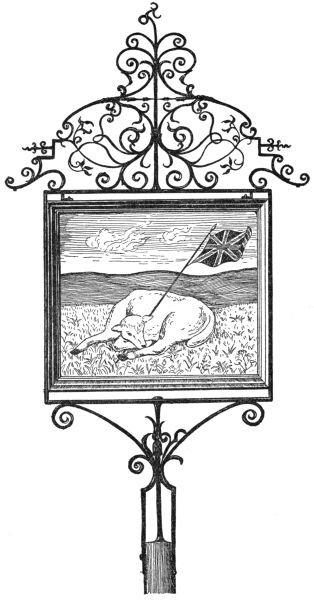
Lamb and Flag
East Bath, England
We cannot resist the temptation to quote as an introduction the ipsissima verba of England’s classical historian Macaulay on the evolution of public hospitality in his country. Most naturally the evolution of the sign runs parallel to the evolution of the tavern, and in a time of flourishing inns we may expect to find highly developed tavern signs. “From a very early period,” says Macaulay, in a chapter on the social condition of England in 1685, “the inns of England had been renowned. Our first great poet had described the excellent accommodation which they afforded to the pilgrims of the fourteenth century. Nine and twenty persons, with their horses, found room in the wide chambers and stables of the Tabard in Southwark. The food was of the best, and the wines such as drew the company on to drink largely. Two[Pg 238] hundred years later, under the reign of Elizabeth, William Harrison gave a lively description of the plenty and comfort of the great hostelries. The continent of Europe, he said, could show nothing like them. There were some in which two or three hundred people could without difficulty be lodged and fed. The bedding, the tapestry above all, the abundance of clean and fine linen was a matter of wonder. Valuable plate was often set on the tables. Nay, there were signs which had cost thirty or forty pounds. In the seventeenth century England abounded with excellent inns of every rank. The travelers sometimes, in a small village, lighted on a public-house such as Walton has described, where the brick floor was swept clean, where the walls were stuck round with ballads, where the sheets smelled of lavender, and where a blazing fire, a cup of good ale, and a dish of trout fresh from the neighboring brook, were to be procured at small charge. At the larger houses of entertainment were to be found beds hung with silk, choice cookery, and claret equal to the best which was drunk in London.”
A sign that costs one hundred and fifty to two hundred dollars
would be, even in our days of high-paid labor, a thing worth looking
at. In the times of the Renaissance it certainly was a work of
excellent craftsmanship, sculptured in wood and richly gilded. On an
extensive tour through England which brought us to the charming
western fishing-village of Clovelly, with its “New Inn” and the more
romantic “Red Lion” down by the little harbor, and to Chester, in the
north, founded by the Romans, we were disappointed to find so few old
signs of artistic value. We found very few carved in wood like “The
Blue Boar” in Lincoln or “The Swan” in Wells, from whose windows the
beautiful western façade of the cathedral, unusually rich in
sculptures, is seen through the green veil of huge old trees. This
swan sign shows certain characteristics of the period of the First
Empire, and surely does not date back beyond 1800. Also the famous
“Four Swans” in the little town of Waltham Cross, north of London,
perhaps the only existing example of an old English custom to
construct the sign like a triumphant arch across the street, are not
so old as the tavern, which a bold inscription dates in[Pg 239]
[Pg 240] the year
1260. How could a sign delicately carved in wood resist the inclemency
of the weather, when the stone sculptures of the cathedrals,—as in
Exeter, for instance, or in Salisbury,—although leaning against the
protecting walls of these gigantic structures, suffered so much? To
please the lovers of antiquity some owners of old houses put the most
arbitrary dates of their foundation on the neatly-painted fronts. In
the street in Chester that leads down to “The Bear and Billet,” one of
England’s oldest frame houses, we saw the date 1006 painted on a
façade, evidently built in Renaissance times. Other burghers and
house-owners who have more respect for exact historic truth, see, of
course, in such misleading inscriptions an unfair competition.
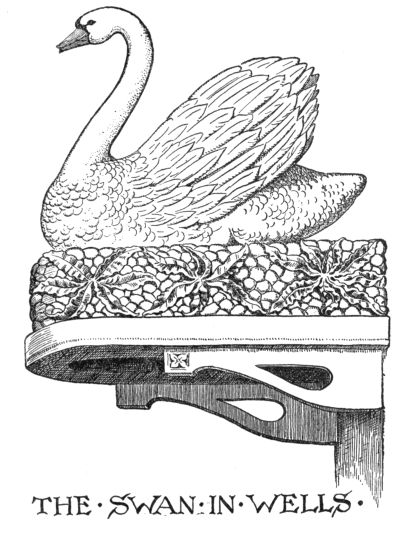
THE·SWAN·IN·WELLS·
Signs wrought in iron seem to have been rare in England, the art of forging being less developed there than in the south of Germany.[Pg 241] Curiously enough the South-Kensington Museum in London, an enormous storehouse of old works of arts and crafts, contains not a single English sign, but a very beautifully forged iron sign from Germany, dated 1635,—a baker’s sign, as the great crown and the heraldic lions reveal to us. A friendly assistant at the Museum showed us another German sign dating from the end of the seventeenth century, charmingly carved and gilded, representing the workshop of a shoemaker. These two were the only signs that the Museum possessed.

Ye Olde Four Swans·in Waltham Cross·England·1260·
The old London signs have all found a very dismal refuge in the dimly lighted cellar of the Guild Hall. Some of them are stone sculptures of considerable size like the giant sign “Bull and Mouth.” Here too we find certain technical curiosities, as, “The Dolphin” of 1730 painted on copper, and more unusual still, “The Cock and Bottle,” a neat and dainty design composed of blue-and-white Dutch tiles. The foggy and damp climate has often injured not only the carved woodwork of the signboard, but still more the painting on it. The beam on which it hangs might be very old; the painting itself[Pg 242] is always of recent date even if the artist, following an old tradition, sometimes produces quaint effects. As an example of how quickly the work of the sign-painter darkens beyond recognition, we may cite “The Falstaff” in Canterbury. It was not a year since the landlady had hung out this picture of the blustering knight in a bold fencing-pose that we saw it last, and it was already very difficult to distinguish the details of the composition; while another painting—the immediate predecessor of the sign in the street—which the friendly Dame showed us on the staircase was as black and bare as a slate. Sometimes the frames of the pictures are carved and allow us to guess the date of their origin; but, as a rule, the perfectly plain signboard hangs out on a strong beam. A typical example is “The Falcon” in Stratford-on-Avon.
The higher the artistic value of the painting on the signboards was, the more we have to regret that so much art was wasted on such a perishable production. In the eighteenth century the coach-painters, whose craftsmanship on old equipages, sledges, and sedan-chairs we still admire in many a museum, used to produce most elegant signs and received[Pg 243] for their work astonishingly high prices. Shaken by winds, whipped by rainstorms, their beauty was soon gone. Nowhere have we found them either in collections or in the light of the street. Only in literary tradition does there still live a part of the charm of all these burned and weather-killed things of beauty.
But one device we discovered in England to restore the old forms, namely, the so-called club signs. Just as the printer’s marks often reproduce en miniature the sign of the publisher, so the club signs give a reduced picture of the old tavern signs, especially of those that were cut as silhouettes in metal plates. The very first printers of the fifteenth century loved to introduce into their books these little designs symbolizing their names. Peter Drach in Speyer used two little shields, one containing a winged dragon and the other, as a friendly compensation, a Christmas tree and two stars. Johannes Sensenschmied, a proud “civis Nurembergensis,” had two crossed scythes (Sensen) in his escutcheon. These same designs appear later on the front page of a volume, neatly engraved on copper, often reproducing the sign of the bookshop to which one[Pg 244] had to go if one wanted to buy this particular book. A Parisian publisher adopted “La Samaritaine,” which to-day has become the name of a great department store. Mr. Léonard Plaignard, of Lyon, called his shop “Au grand Hercule,” and put the Greek hero on the front page of his books with the inscription: “Virtus non territa monstris.” Just as these little engravings may give us an idea of the old publishers’ signs, so we may gain from the club signs some suggestions as to how the old signboards looked.
On Whitsunday the club members used to fasten these small brass imitations of their beloved tavern sign to poles and carry them in solemn procession through the astonished town. At the end of the club walking, it is whispered, many were unable to hold the poles as straight as they wished. The museum of the quiet little town of Taunton possesses a remarkable series of such club signs. It has become quite a fad in England to collect these little polished brass figures, since the public has got tired of the warming-pan craze.
Morris dancers sometimes joined in the club processions, among them the green or wild man, Robin Hood, famous in song and story; they amused the crowd with such charming airs as as—
Our design of two gentlemen saluting each other politely is such a club sign, reproducing in miniature the sign of the “Salutation Inn” in Mangotsfield, and representing the last link in the chain of salutation signs, which began with the old religious scene of Mary saluted by the angel.
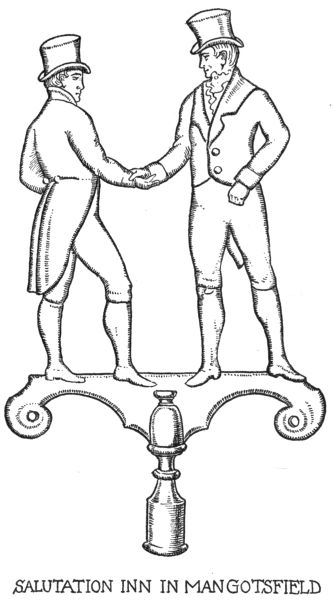
SALUTATION INN IN MANGOTSFIELD
Price Collier, in his book “England and the English,” has dedicated a
whole chapter to English sport, on which the nation spends every year
$223,888,725, more than the cost of her entire military machine, navy
and army together. On fox hunting alone she spends $43,790,000. This
love of sport is an old English trait, shared by both sexes. One of
the first books printed in England was a book on sport, “The Bokys of
Haukyng and Huntyng,” supposed to be written by a lady, Juliana
Berners, the prioress of the nunnery of Sopwell, and published for[Pg 245]
[Pg 246]
the first time in the new black art in 1486. A schoolmaster of the
abbey school of St. Albans had arranged the edition, and it is
therefore sometimes quoted as “The Book of St. Albans.” No wonder,
then, that such a popular subject was readily chosen by the sign
painters, and that they love to picture the hunted animals, the white
hart and the fox, and not less often the faithful companions of the
hunter, dog and horse, hawk and falcon.
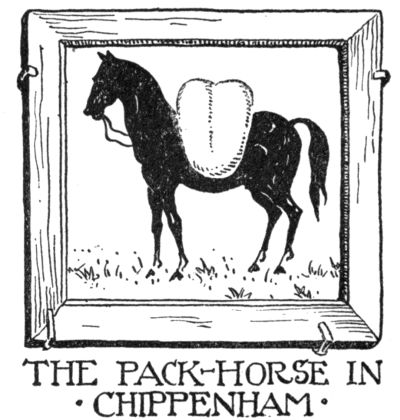
THE PACK-HORSE IN ·CHIPPENHAM·
A great rôle is played by the horse, not only as the heraldic animal in the coat of arms of the Saxons and of the House of Hanover, but the real beast, from the good old pack-horse to the lithe-limbed racer. In the early Middle Ages, when the roads were so bad that it was impossible for heavy wagons to travel on them, the pack-horse was the only medium for the transportation[Pg 247] of goods, post-packages, and mail. Those were hard days for impatient lovers, who would have preferred to send their billets-doux in Shakespearean fashion, “making the wind my post-horse.” Sometimes the horse’s burden, the wool-pack—the wool business being the chief trade in England in the twelfth century—appears on the signboard. In fact, in the time of Ben Jonson “The Woolpack” was one of the leading hostelries of London.
Another sign is the race-horse, celebrated by Shakespeare in such lines as:—
from “Titus Andronicus” (ii, ii), or those other lines in “Pericles” (ii, i):—
In the reign of Henry VIII, a tavern called “The Running Horses” existed in Leatherhead, a place not exactly fitted for noble hunters, since a contemporary poet complains about the beer being served there “in rather disgusting conditions.” Not infrequently we find more or less happy portraits[Pg 248] of famous race-horses, such as “The Flying Dutchman” and “Bee’s Wing”; sometimes even a hound was honored in this way, guarding the entrance of a tavern as his famous Roman colleague, pictured in mosaic, did in the days of antiquity. “The Blue Cap” in Sandiway (Cheshire) was such a sign.
In Chaucer’s time it was a popular fashion to decorate the horses with little bells, as we may infer from the Abbot’s Tale:—
Curiously enough, these bells, sometimes of silver and gold, are designated in old manuscripts by the Italian word campane, as if this custom had been adopted by the English gentry from Italy. The “gentyll horse” of the Duke of Northumberland, the old documents would tell us, was decorated with “campane of silver and gylt.” Most naturally such valuable bells were very welcome as prizes in the sporting world; in Chester, for instance, the great prize of the annual race on St. George’s Day consisted of a beautiful golden bell richly adorned with the royal[Pg 249] escutcheon. But independent of this custom the bell has always been very popular in England. The great German musician Händel has even called it the national musical instrument, because nowhere else, perhaps, do the people delight so much in the chimes of their churches. We find it, therefore, everywhere on the tavern sign, sometimes in absurd combinations like “Bell and Candlestick” or “Bell and Lion”; very prettily in connection with a wild man, “Bell Savage,” which is changed under gallant French influence into “Belle Sauvage,” or even “La Belle Sauvage.” “Cock and Bell” points again to a popular sport, the cock-fight. Like the little slant-eyed Japanese, the small boys of Old England loved to watch this exciting game; on Lent-Tuesday special cock-fights were arranged for them, and the happy little owner of the victorious animal was presented with a tiny silver bell to wear on his cap. No wonder that “The Fighting Cocks” themselves appear on the signboard. We find them on taverns in Italy, too, where the popularity of this sport goes back to the Roman days. The Bluebeard King Henry VIII issued an order prohibiting all cock-fights[Pg 250] among his subjects, all the while establishing for himself a cockpit in White Hall as a royal prerogative. In the days of Queen Victoria the rather cruel sport was definitely abolished.
Another not less cruel sport still lives in the tavern sign “Dog and Duck.” The birds were put into a small pond and chased by dogs. Watching the frightened creatures dive to escape their pursuers constituted the chief joy of the performance. We may still hear the wild cries of the spectators urging on the dogs, when we read the old rhyme:—
An old stone sign of such a “Dog and Duck” tavern, dated 1617, can still be seen in London outside of the Bethlehem Hospital in St. George’s Field. The popular name of this lunatic asylum is Bedlam—favorite word of Carlyle to designate confusion and chaos.
Here in South London special arenas were built for the spectacle of bear-baiting, and it is no chance that as early as in the time of[Pg 251] Richard III the most popular tavern of this quarter was called “The Bear.” It stood near London Bridge, and was frequented especially by aristocratic revelers. In these scenes of rough amusements for the people the muse of Shakespeare introduced the gentle dramatic arts. Here his “Henry V” was introduced for the first time, perhaps, with its solemn chorus: “Can this cockpit hold the vasty fields of France?”
Still more than these artificial and butchery sports of the citizen, the real joys of the hunter found their echo in the productions of the sign-painters. There is hardly an English town without a “White Hart Inn.” Since the days of Alexander the Great, who once caught a beautiful white hart and decorated his slender neck with a golden ring, since Charlemagne and Henry the Lion, the white hart has been a special favorite of the hunter, whose joys no poet perhaps has sung so charmingly as Shakespeare in these lines of “Titus Andronicus” (ii, ii and iii):—
Another group of signs celebrates Master Reynard. We see him harassed by dogs and riders on the sign “Fox and Hounds” in Barley (Hertfordshire). We miss only the sportive ladies who dip their kerchiefs of lace in the poor devil’s blood to show that they, too, were in at the finish. This sign, by the way, was used long centuries ago, since we hear of a “Fox and Hounds Inn” in Putney that claims to be over three hundred years old.
The German Nimrod took no less pleasure than his English cousin in seeing a hunter’s sign on the tavern door, as is amply proved by the many golden harts, flying in great bounds, or our George sign from Degerloch, daintily wrought in iron. The German poets, too, sang many a song celebrating the adventures of the chase.
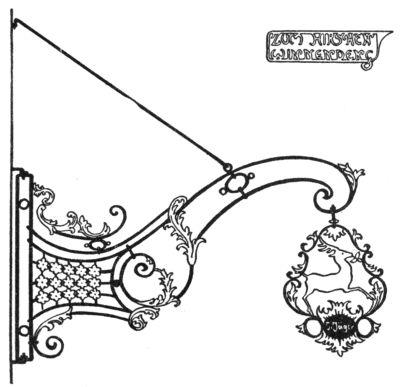
ZUM HIRSHEN WINNENDEN
Not so often do we find on the Continent the so-called “punning sign,” which might well be called an English specialty, since England’s greatest poet used to indulge a great deal in punning,—“mistaking the word” as he calls it. In a dialogue full of quibbles in the “Two Gentlemen of Verona” he admits himself that it is a weakness to yield to it:—
“Speed. How now, Signior Launce? What news with your mastership?
“Launce. With my master’s ship? Why, it is at sea.
“Speed. Well, your old vice still: mistake the word. What news then in your paper?
“Launce. The blackest news that ever thou heard’st.
“Speed. Why, man, how black?
“Launce. Why, as black as ink.”
And thus he goes on against his better judgment and “the old vice” triumphs, not only here, but in nearly all his plays. Following the illustrious example of the great poet the English landlord puts all kinds of puns and puzzles on his signs, and the private citizen of simple birth and aristocratic ambitions created for himself the most ridiculous escutcheons by childish plays upon his own name. Thus, Mr. Haton would put a hat and a tun in his coat of arms and Mr. Luton a lute and a tun without giving a thought to etymology. Likewise the landlord’s name would account for such curious signs as “Hand and Cock,” which was simply the punning sign of a certain John Hancock in Whitefriars.
Diligent authors like Frederic Naab—who, together with Thormanby, made a special study of sign puzzles—are indefatigable in searching out the deep meaning of all these tavern sign absurdities. “The Pig and[Pg 255] Whistle” alone has been explained in twelve different ways. We mentioned above how “The Cat and Fiddle” was a mutilation of the old religious sign of “Catherine and Wheel.” In similar fashion the noble-sounding “Bacchanals” were degraded to a common “Bag of Nails.”
Topers and tipplers, whose forte was certainly not orthography, loved to confuse “bear” and “beer,” words that might very well sound alike when pronounced by beery voices. A certain Thomas Dawson in Leeds, who evidently sold a rather heavy beer, warned his customers on his sign: “Beware of ye Beare.” Lovers of cards invented the amusing distortion of “Pique and Carreau” into “The Pig and Carrot.” The popular political sign of “The Four Alls,” representing a King (“I rule all”), a Priest (“I pray for all”), a Soldier (“I fight for all”), and John Bull as farmer (“I pay for all”), was changed into “Four Awls,” a sign which presented infinitely less difficulties to a painter of few resources. Sometimes the Devil is added as fifth figure saying, “I take all.”
Cromwell’s soldiers once took offense at the sign of a tavern where they were obliged[Pg 256] to put up for the night. They took it down and in its place wrote over the door the words, “God encompasses us.” The next day, when they were gone, the landlord had the brilliant idea to change the pious words to the punning sign, “Goat and compasses.” Maybe, too, the compasses were a commercial trade-mark, as we see them still to-day on boxes and casks.
Very popular was the joking sign, “The Labor in Vain,” representing a woman occupied in the hopeless task of washing a colored boy:—
This particular sign was imported from France, where the calembour sign flourished. Some even say that the punning sign became popular in England only “after Edward ye 3 had conquered France.” The French have two interpretations of the “Labor in Vain”: one corresponds with the English version; the other, “Au temps perdu,” represents a schoolmaster teaching an ass. As counterpart we find “Le temps gagné,” a peasant carrying his donkey. The French calembours[Pg 257] were decidedly less reverential than the English punning signs. Neither religion nor good morals are sacred to the Gallic wag, who is allowed to say anything if he understands how to turn it gracefully. “Le Signe de la croix” is depicted by a swan (cygne) and a cross, and even the tragic scene of Jesus taken prisoner in the Garden of Gethsemane—le juste pris—is turned into the shameless words, “Au juste prix,” to advertise the cheapness of drinks and victuals. More innocent is the distortion of the “Lion d’or” into the undeniable truth, “Au lit on dort,” or the inscription on a white-horse sign: “Ici on loge à pied et à cheval.” The temptation to use such calembours no trader could resist. A corset-maker praised his goods thus: “Je soutiens les faibles, je comprime les forts, je ramène les égarés.” We shall see in the following chapter how such pointed jokes and blasphemies roused the righteous indignation of the honorable and pious citizens and increased the enemies of the sign, who finally gave it the coup de grâce.
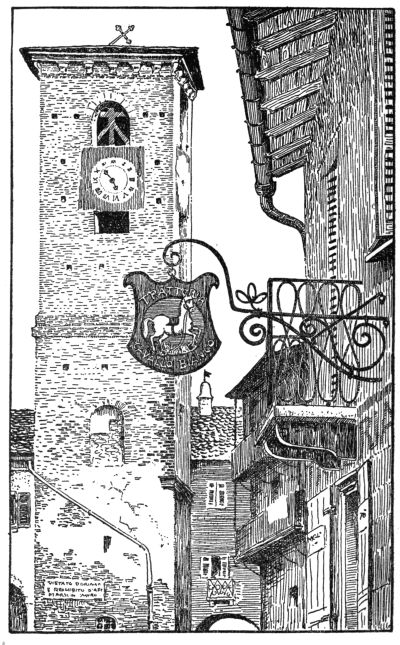
Cavallo Bianco
Borgo San Dalmazzo, Italy
“Ne songez pas même à réformer les enseignes d’une ville!”
In mediæval times the signs were not only charming or pious decorations of the snug narrow streets, but they were also very useful and practical guides for the wayfarer through the labyrinth of crooked lanes. Even the uneducated understood their pictorial language like illustrations in a book which give even to a child a certain clue to its meaning. For this very reason the learned Sebastian Brant decorated his edition of Virgil of 1522 with elaborate pictures,—expolitissimis figuris atque imaginibus nuper per Sebastianum Brant superadditis,—firmly hoping that now even the unlearned would easily understand the beauties of his beloved author: “Nec minus indoctus perlegere illa potest.” While the learned men in general continued to despise pictures in their editions of the classics, the first popular books tried through their wood-cuts to speak to the fancy of the common people and thus win[Pg 262] their applause. Just as these pictures in the old books, so the signs in the streets spoke to the indoctus. Therefore, if somebody wished to send a letter to his banker in Fleet Street, London, he needed only to tell his messenger that it was at the “Three Squirrels,” and he was sure that even the greatest numskull could find it. Unfortunately the owners of this old banking-house have withdrawn the sign, so it took me quite a while before I found it safely hung up on a modern iron arm in the office of Messrs. Barclay & Co., No. 19, Fleet Street. The characteristic interpretation of the sign, given to me by the banker himself, was: “May you never want a nut to crack.”
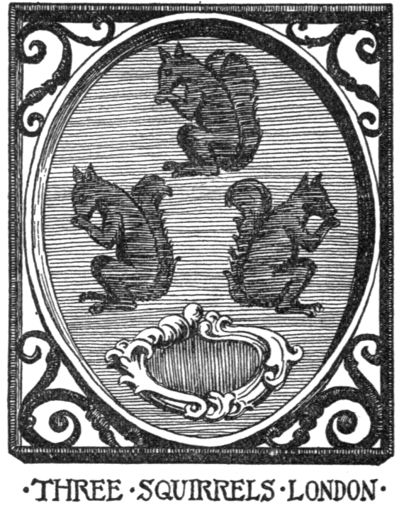
·THREE·SQUIRRELS·LONDON·
In the old times the streets were not yet numbered, as Macaulay tells us, not even at the end of the seventeenth century.[Pg 263] “There would indeed have been little advantage in numbering them; for of the coachmen, chairmen, porters, and errand-boys of London, a very small proportion could read.... The shops were therefore distinguished by painted signs, which gave a gay and grotesque aspect to the streets. The walk from Charing Cross to Whitechapel lay through an endless succession of Saracens’ Heads, Royal Oaks, Blue Bears, and Golden Lambs, which disappeared when they were no longer required for the direction of the common people.” As a useful guide to find one’s way the sign was expressly recognized by the state authorities; so in a privilege granted by Charles I to the inhabitants of London to hang out signs “for the better finding out such citizens’ dwellings, shops, arts, or occupations.” For the landlords, it was even made obligatory so as to facilitate the police in determining if the laws concerning the liquor trade were properly observed. An Act of Parliament in the reign of Henry VI forced the brewers to hang out signs and an ordinance of Louis XIV for Paris distinctly demands: “Pour donner à connoître les lieux où se vendent les vins en détail et si les régle[Pg 264]ments y sont observez, nul ne pourra tenir taverne en cette dite ville et faubourgs sans mettre enseigne et bouchon.” Similar regulations we find in Switzerland; as, for instance, in Maienfeld where the city fathers punished every one who kept tavern without an “open sign.” Through such restrictions they hoped to stop the competition of the simple burgher, “the temporary landlord,” who tried to sell the surplus product of his own vineyard, and thus to secure the patronage of all thirsty souls for the legal “Schildwirt,” the landlord with a sign, even[Pg 265] if he lived only from the “bouchon” or cork and could not accommodate guests overnight.
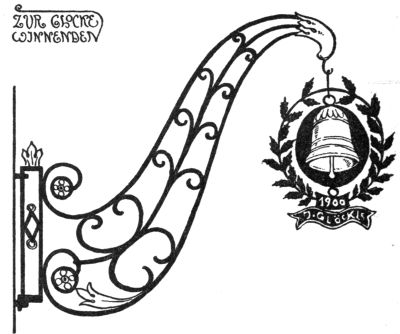
ZUR GLOCKE WINNENDEN
If they had not a sign out, how could the watchman, after the night-bell—sometimes called “Lumpenglocke” in Germany—had sounded, investigate properly if the tavern-keepers really stopped to furnish the guests with new wine? And was it not the duty of the city fathers to look after the morals of their subjects and to teach them the wisdom of the German saying:—
So the sign was in many ways a useful institution topographically, politically, and morally. Its merits are not yet exhausted: it was a good weather prophet, too. When the old iron things began to moan and to squeak, storm and rain surely were not far, as an English rhyme whimsically says:—
How was it possible, then, that such an institution as our amiable sign, approved and furthered by the State, such a popular, often[Pg 266] artistically charming creation, could have enemies? The first reason, as we have seen in our chapter on “Religious Signs,” was that pious signs were used by impious innkeepers or that religious themes were represented in a manner insulting to all religious feeling. No wonder, if a French landlord called his tavern “Au sermon,” and illustrated the word “sermon” by a deer (cerf) and a mountain (mont), that the really pious citizen protested and exclaimed indignantly: “Ne devrait-on pas condamner à une grosse amende un misérable cabaretier qui met à son enseigne un cerf et un mont pour faire une ridicule équivoque à sermon? Ce qui autorise des ivrognes à dire qu’ils vont tous les jours au sermon ou qu’ils en viennent.”
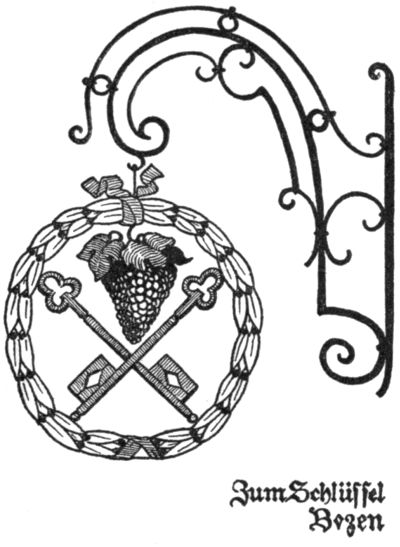
ZUM SCHLÜSSEL BOZEN.
Surely the really pious signs subsisted beside their frivolous brothers, as the English doctor-sign of 1623, beautifully carved and gilded and now a treasure of a collector, proves by its inscription: “Altissimus creavit de terra medicynam et vir prudens non abhorrebit illam.” Curiously enough, the schoolmaster souls took offense at the sign’s absurd combinations, its lack of “sound literature and good sense,” its impossible ortho[Pg 267]graphy and ridiculous mottoes, which, by the way, were added only later to the pictures. All this was extremely shocking to these people and many of them thought it a noble life-task to reform the signs. One of these reformers developed his programme in one of the oldest English periodicals, “The Spectator,” in an April number of the year 1710, fully aware of attempting an herculean labor. Combinations, such as “Fox and Goose,” he deigns to admit; but what sense, asks he, in logical indignation, “is in such absurdities as ‘Fox and the Seven Stars,’ or worse still, in the ‘Three Nuns and a Hare’?” Molière, in “Les Fâcheux,” has ridiculed these sign reformers, a species not unknown in Paris either, in the person of Monsieur Caritidès,[Pg 268] who humbly solicited Louis XIV to invest him with the position of a General Sign Controller. His petition reads, in Molière’s inimitable French, as follows:—
Sire:
Votre très-humble, très-obéissant, très-fidèle et très savant sujet et serviteur Caritidès, Français de nation, Grec de profession, ayant considéré les grands et notables abus qui se commettent aux inscriptions des enseignes des maisons boutiques, cabarets, jeux de boule et autres lieux de votre bonne ville de Paris, en ce que certains ignorants, compositeurs des dites inscriptions, renversent, par une barbare, pernicieuse et détestable orthographe, toute sorte de sens et de raison, sans aucun regard d’etymologie, analogie, énergie ni allégorie quelconque au grand scandale de la république des lettres et de la nation Française, qui se décrie et déshonore, par les dits abus et fautes grossières, envers les étrangers, et notamment envers les Allemands, curieux lecteurs et inspecteurs des dites inscriptions ... supplie humblement Votre Majesté de créer, pour le bien de son État et la gloire de son empire une charge de contrô[Pg 269]leur, intendant-correcteur, réviseur et restaurateur général des dites inscriptions et d’icelle honorer le suppliant....
In all impartiality we have to admit that really the sign lost by and by its usefulness as a street-guide, since the trades and crafts occupying a house changed often, while the old signs, especially those which formed a part of its architecture, remained unchanged, thus producing the most ridiculous contradictions against which the above-mentioned reformer of “The Spectator” protested not without reason, saying: “A cook should not live at ‘The Boot’ nor a shoemaker at ‘The Roasted Pig.’”
But the most ruthless enemy of the sign became the police itself, who once protected it. As early as the year 1419 we find an English police regulation, threatening with a fine of forty pence—in those days quite a sum—“that no one in future should have a stake bearing either his sign or leaves, extending or lying over the King’s highway, of greater length than seven feet at most.” As every innkeeper tried to outdo the other by the size and the magnificence of his sign,[Pg 270] one arrived finally at absurdly great constructions which really hampered the traffic: as in England, where we find wrought-iron signs which, like arches of triumph, reached from one side of the street to the other. A precious old book, “A Vademecum for Malt-Worms” (British Museum), in a quaint woodcut, “The Dog in Shoreditch,” gives us a picture of such a sign monument. To the artist’s eyes they were charming things, combining happily great lanterns with the sign into a harmony which we so often find lacking in modern days, where beautiful old signs through the addition of ugly modern lamps lose all their artistic charm of yore.
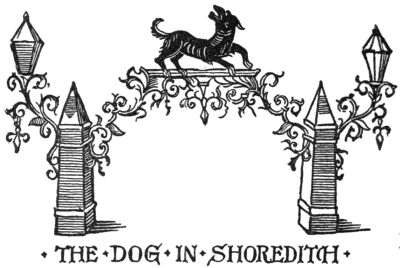
·THE·DOG·IN·SHOREDITCH·
Mercier’s “Tableau de Paris” tells us of ridiculously great signs: spurs as large as a wheel, gloves big enough to house a three-year-old babe, and the like. In old Germany, too, the sight of the giant signs, as Victor Hugo describes them from Frankfurt-on-the-Main, must have been fantastic enough. “Under the titanic weight of these sign monuments caryatides are bowed down in all positions of rage, pain, and fatigue.” Some of them carry an impudent bronze negro in a gilded tin mantle; others an enormous Roman emperor—a monolith of twenty feet in height—“dans toute la pompe du costume de Louis XIV avec sa grande perruque, son ample manteau, son fauteuil, son estrade, sa crédence où est sa couronne, son dais a pentes découpées et à vastes draperies.”
Especially objectionable to the police in London were those signs that reached far out over the street and, shaken by the wind, constituted a real danger to the passer-by. So the fall of such a huge inn sign in Fleet Street, London, in 1718, caused the death of two ladies, a court jeweler, and a cobbler. Similar dangers threatening an innocent public were vividly set forth in a Parisian police[Pg 272] ordinance in 1761, in an amusing bureaucratic French: “Les enseignes saillantes faisaient paraître les rues plus étroites et dans les rues commerçantes elles nuisaient considérablement aux vues des premiers étages, et même a la clarté des laternes, en occasionnant des ombres préjudiciables à la sureté publique; elles formaient un péril perpetuellement imminent sur la tête des passants, tant par l’inattention des propriétaires et des locataires sur la vétusté des enseignes ou des potences, qui en ont souvent abattu plusieurs et causé les accidents les plus funestes.”

THE QUEEN·IN EXETER·
If the police had contented itself in eliminating the offensive or really dangerous signs, nobody[Pg 273] could have blamed it. Unfortunately it was much more aggressive, especially in France, the paradise of the “ronds de cuir,” and attempted to cut down every individual or artistic invention on the part of the signmakers. We are, therefore, not surprised to find so little in modern France that could remind us of the old abundance. The officials of the Revolution proved themselves just as narrow-minded as those of royal times. Both, animated by the bureaucratic instinct to confine everything to narrow rules, tried to suppress all individual poetical invention that once was the charm of the sign. A royal edict of 1763 prescribes a very uninteresting design as a binding model for all signs, giving at the same time the exact measurements of the same and warning the public not to dare to make any changes on the “dessein cy-dessus marqué.” It was a poor consolation for the owners of beautiful old signs that the same edict granted them the great privilege of giving their art-treasures in account as old iron—“quinze deniers la livre”—when paying the bill for the new sign patented by the State. Still more radically acted the men of the Revolution, who sincerely hated the[Pg 274] signs, with their crowns and heraldry, as abominable “marques du despotisme.” They made short work, and simply ordered: “Toutes les enseignes qui portent des signes de royalisme, féodalité et de superstition seront renouvelées et remplacées par des signes républicains: les enseignes ne seront plus saillantes mais simplement peintes sur les murs des maisons.”
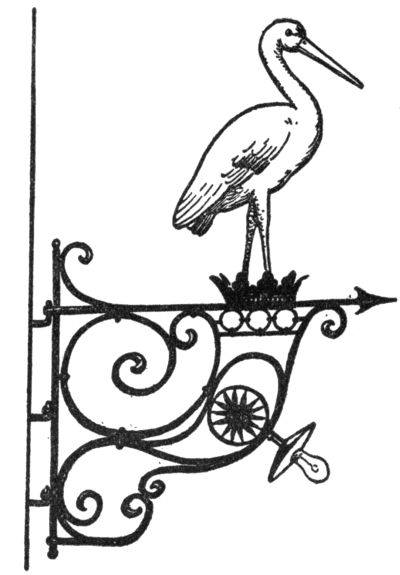
Another danger for the sign resulted from the attempt to number the houses of which we hear, perhaps for the first time in France, as early as 1512. This first attempt failed, but in the enlightened eighteenth century the new and certainly more reasonable method of distinguishing a house from its neighbor decidedly gained ground. In 1805 it was made obligatory by the Parisian police. A[Pg 275] similar development we observe in England. Nobody will deny the practical progress and no business man would like to return to the old times when an English bookseller, for instance, had to give the address of his shop in the following way: “Over against the Royal Exchange at the Sugar Loaf next Temple Bar.” In Germany, where the centralization in large capitals made slower progress and a multitude of small social and political centers kept their own, the rational institution of numbering the houses, so necessary in great cities like Paris or London, was not accepted so quickly. In 1802 Dresden, for instance, had not even on the street corners signs indicating their names; “an institution that facilitates topography and topography facilitates business,” remarks a judicious contemporary. Here in Germany the cold number did not conquer so easily over the poetical warmth of the dear old sign. In the quiet, imperial towns of the south the artistic sign of the Rococo period and the Empire style, unpersecuted and unmolested, keep their place in the sun up to the present day in spite of some ill-advised landlords who thought it necessary to hide the humble oxen or lamb[Pg 276] in the garret and call their house by some new pretentious French name like “Hotel de l’Europe” or the like.
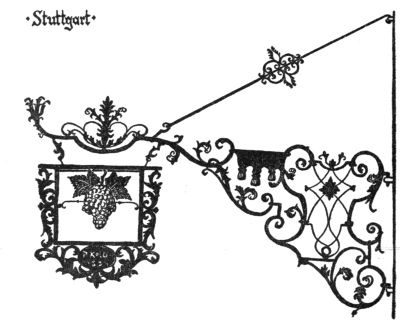
·Stuttgart·
In our own enlightened times of general school education, nobody needs any more the sign as a guide through even the most modest town. Everywhere the number has taken its place for this purpose and we regret to admit for the history of the sign too the truth of Darwin’s words: “Progress in history means the decline of phantasy and the advance of thought.”
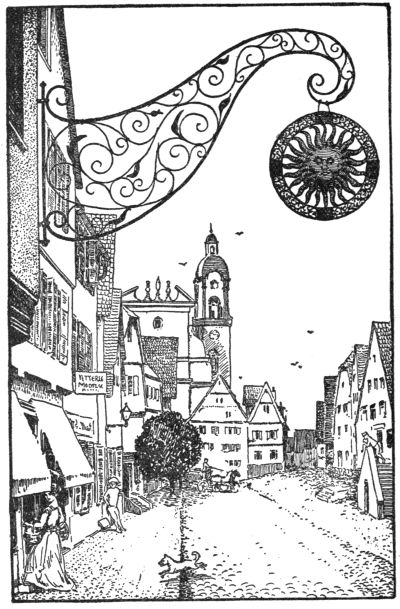
Sonne Neckarsulm,
Württemberg
“I am here in a strange land and have perhaps the seat of honor at table in this inn; but the man down there on the end has just as good a right here and there as I, since we are both here only guests.”
It is not very much the fashion in these modern days to ask for the moral meaning of things, but we are old-fashioned enough to hold with those who believe that things have not only a soul, but that they give us a lesson too in revealing their soul to us, “la leçon des choses,” as the French, whom we are inclined to call condescendingly the immoral French, call it. Old Frederic the Great in his famous interview with the poet Gellert in Leipzig, after hearing from him one of his fables “The Painter of Athens,” did not fail to ask the all-important question: “And the Moral?”
Many a reader who has followed us but hesitatingly into regions that seemed to him at the beginning of doubtful moral value,[Pg 280] will be perhaps surprised to see us conclude our investigations with this same question. But I am sure we will do it with good profit, since in doing so we shall have the chance to hear many a sermon of Doctor Martinus Luther, whose moral force we children of the twentieth century would love to dig out of his writings if its gold did not seem to us so hopelessly buried under the sand of antiquated dogmatical quarrels.
The tavern sign has its moral lesson for all concerned, guests and landlords alike. From its modest and unknown creators the modern artist too may receive many a valuable inspiration. When the poet Seume, in December, 1801, started from Grimma in Saxony on his long pilgrimage to Syracuse, his way seems to have led him soon to a knightly George, who fights the dragon in all Christian lands, over many a tavern door for centuries and whom Shakespeare celebrated in the verses:—
Looking at the great green beast our romantic pilgrim prayed: “May heaven grant me honest, friendly landlords and polite[Pg 281] guardians at the city gates from Leipzig to Syracuse!” In those old days when the gate was dangerously near the tower and its dungeon, it was indeed of the highest importance to find polite officials at the city gates; just as we might sometimes pray to-day for polite customs officials, the successors of the old grumpy watchmen who guarded the city entrance and wrote the newcomer’s name in their big books. Still more important, too, is it for the modern traveler to find friendly landlords. They seem as in the old days a gift from heaven, for which we must[Pg 282] pray and which we cannot buy. Truly many travelers seem to think a full purse buys everything, but they forget the old truth which Charles Wagner, in his book “La vie simple,” has expressed rightly in the following sentence: “Le travail d’un homme n’est pas une marchandise au même titre qu’un sac de blé ou un quintal de charbon. Il entre dans ce travail des éléments qu’on ne peut évaluer en monnaie.” And just these fine elements in the work of a landlord and his servants which we cannot weigh or pay for make the simplest inn so homelike and cozy. A good landlord does not need to fear even Death, who seems to seize only the dishonest one, if we believe the author of a “Dance of Death” from the fifteenth century in the Stuttgarter Hofbibliothek. In a few forceful lines the old artist traces the figure of the bad landlord sitting behind his counter and trying to win the good favors of the uncanny musician Death, by offering him a great stein of beer and humbly confessing: “Against God and against law I sought to win earthly goods, taking money unjustly from knights and peasants as a robber does. Oh, if I only should not die[Pg 283] now, I could hope to improve and to win grace.”
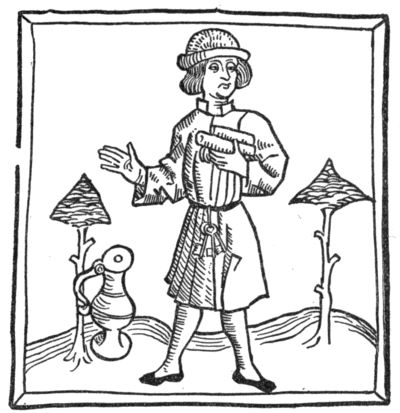
Many a landlord would gladly follow the example of Abraham if only his guests would try to learn a little from the angels. But how often come to him such wild fellows who claim every good thing he has in cellar and kitchen, and when it comes to pay take French leave.
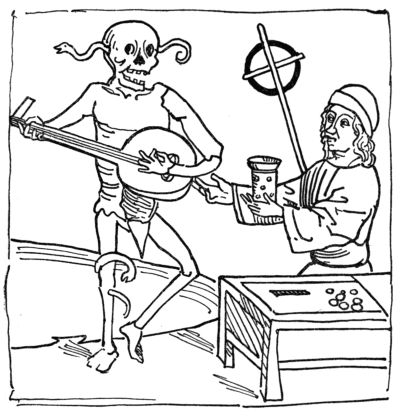
It is well known that, as the old Bible[Pg 284] saying goes, the sun is shining over good and bad, over just and unjust, but Luther thought he does not do it gladly. Perhaps the Doctor, who knew so many roads from his own experience, even thought of the golden tavern sun when he said: “The sun would prefer that all the bad fellows should get not a single little gleam from him and it is a great grief and cross to him that he must shine over them, wherefore he sighs and moans.”
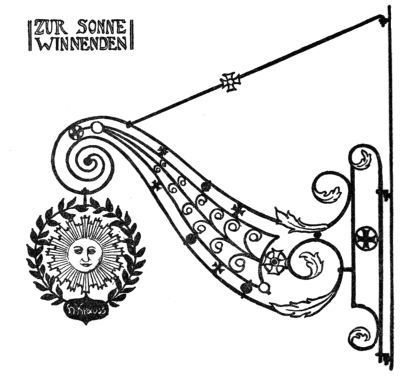
ZUR SONNE WINNENDEN
Nobody has admonished us so heartily as Doctor Martinus to hold ourselves as pious guests in this inn of Life, to live honestly and decently in it as it becomes a guest. “If you wish to be a guest, be peaceful and behave yourself as a Christian; otherwise they will soon show you the way to the tower.” It is characteristic for Luther to remind the unruly guest of the tower, i.e., the prison. In other connections too he readily refers to Master John the Hangman who is to his mind a very useful, nay, even charitable man.
Since we did not hesitate to threaten the landlord with the ghastly musician of the “Dance of Death,” it will seem only fair to remind the guests of the tower, which in the old days was used as prison for the peace-breakers. Luther, like all good Germans, was not a prohibitionist; he recognized “a drink in honor,” “einen Trunk in Ehren,” but he was a fierce enemy of all “drunkards and loafers” who lie in taverns Sunday and week-day and pour the beer down their throats as cows gulp water, saying: “What do I care about God, what do I care about death? You miserable hog, you shall get what you are striving for, you shall die too[Pg 286] and be swallowed up by the mouth of Hell.” To every decent landlord such guests are a curse. To chase them from his threshold the owner of the “George and Dragon” in Great Budworth (Cheshire) invented the fine[Pg 287] rhyme which should stand over every tavern door:—
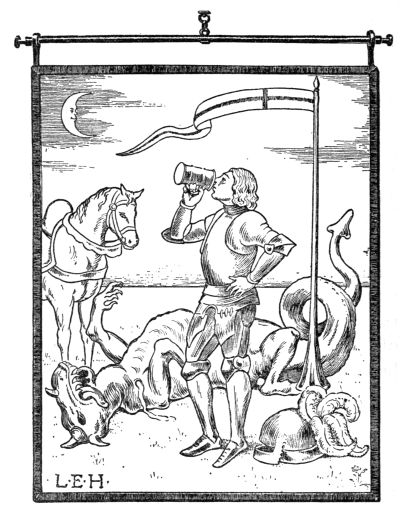
A decent behavior surely, but no melancholy teetotalism, such is Luther’s standpoint. “Those have not been of the devil who drank a little more as their thirst required and became joyful.”—“It is not the fault of the eating and drinking, that some people degrade themselves to swine.” Just as dancing in itself is no sin: “Why not admit an honorable dance at a marriage feast? Go and dance! The little children dance too without sin; do the same and be like a child whose soul is not injured by dancing.”
The whole world appears to Luther like an inn in a strange town, in which the pilgrim lies. In his nightly dreams he does not think of becoming a citizen or a major of this town, his thoughts wander away through the gate to the far city where his home is.
To the pretentious traveler his description of “Christ’s Inn,” which reminds us of our Swiss sign, “Hie zum Christkindli,” might[Pg 288] serve as a little lesson in modesty. Thus he speaks about it in a Christmas sermon: “Look, how the two parents in a strange land in a strange city search in vain for good and hospitable friends. Even in the inns was no room, since the city at that time was so crowded. In a cow-stable they had to go and make the best of it as poor poor people! There was no couch, no linnen, no cushions, no feather-beds; on a bundle of straw they made their bed as close neighbours of the good cattle. There in a hard winter-night the noble blessed fruit was born, the dear child Jesus.” And in another Christmas sermon he says: “If you look at it with cow’s or swine’s eyes it was a miserable birth ... but if you open your spiritual eyes you will see countless thousands of angels, filling the heaven with their song and honouring not only the child but the manger too in which it lies.”
Everything depends finally upon the way we look at it, if with cows’ eyes or with spiritual eyes. Only these will enable us to see in the poorest inn the angel of hospitality covering us at night with gentle wings. Till finally Mother Earth shall cover us softly[Pg 289] in our last quiet “Deversorium” in which we have at least the hangman’s comfort: “You shall be called to no more payments, fear no more tavern bills which are often the sadness of parting as the procuring of mirth.”
But we must not end without delivering a little sermon to the signs, too, that still glitter in the warm sunshine. To them, cocks, deer, bears, oxen, and horses, a church-tower cock, celebrated by the humorous clergyman poet Möricke of Schwabenland, gives this solemn warning:—
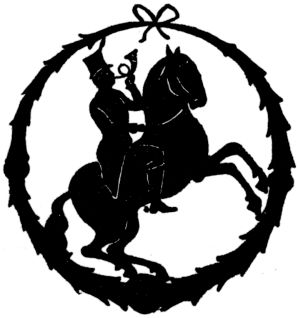
***END OF THE PROJECT GUTENBERG EBOOK OLD TAVERN SIGNS***
******* This file should be named 41869-h.txt or 41869-h.zip *******
This and all associated files of various formats will be found in:
http://www.gutenberg.org/4/1/8/6/41869
Updated editions will replace the previous one--the old editions will be renamed.
Creating the works from public domain print editions means that no one owns a United States copyright in these works, so the Foundation (and you!) can copy and distribute it in the United States without permission and without paying copyright royalties. Special rules, set forth in the General Terms of Use part of this license, apply to copying and distributing Project Gutenberg-tm electronic works to protect the PROJECT GUTENBERG-tm concept and trademark. Project Gutenberg is a registered trademark, and may not be used if you charge for the eBooks, unless you receive specific permission. If you do not charge anything for copies of this eBook, complying with the rules is very easy. You may use this eBook for nearly any purpose such as creation of derivative works, reports, performances and research. They may be modified and printed and given away--you may do practically ANYTHING with public domain eBooks. Redistribution is subject to the trademark license, especially commercial redistribution.
To protect the Project Gutenberg-tm mission of promoting the free distribution of electronic works, by using or distributing this work (or any other work associated in any way with the phrase "Project Gutenberg"), you agree to comply with all the terms of the Full Project Gutenberg-tm License available with this file or online at www.gutenberg.org/license.
1.A. By reading or using any part of this Project Gutenberg-tm electronic work, you indicate that you have read, understand, agree to and accept all the terms of this license and intellectual property (trademark/copyright) agreement. If you do not agree to abide by all the terms of this agreement, you must cease using and return or destroy all copies of Project Gutenberg-tm electronic works in your possession. If you paid a fee for obtaining a copy of or access to a Project Gutenberg-tm electronic work and you do not agree to be bound by the terms of this agreement, you may obtain a refund from the person or entity to whom you paid the fee as set forth in paragraph 1.E.8.
1.B. "Project Gutenberg" is a registered trademark. It may only be used on or associated in any way with an electronic work by people who agree to be bound by the terms of this agreement. There are a few things that you can do with most Project Gutenberg-tm electronic works even without complying with the full terms of this agreement. See paragraph 1.C below. There are a lot of things you can do with Project Gutenberg-tm electronic works if you follow the terms of this agreement and help preserve free future access to Project Gutenberg-tm electronic works. See paragraph 1.E below.
1.C. The Project Gutenberg Literary Archive Foundation ("the Foundation" or PGLAF), owns a compilation copyright in the collection of Project Gutenberg-tm electronic works. Nearly all the individual works in the collection are in the public domain in the United States. If an individual work is in the public domain in the United States and you are located in the United States, we do not claim a right to prevent you from copying, distributing, performing, displaying or creating derivative works based on the work as long as all references to Project Gutenberg are removed. Of course, we hope that you will support the Project Gutenberg-tm mission of promoting free access to electronic works by freely sharing Project Gutenberg-tm works in compliance with the terms of this agreement for keeping the Project Gutenberg-tm name associated with the work. You can easily comply with the terms of this agreement by keeping this work in the same format with its attached full Project Gutenberg-tm License when you share it without charge with others.
1.D. The copyright laws of the place where you are located also govern what you can do with this work. Copyright laws in most countries are in a constant state of change. If you are outside the United States, check the laws of your country in addition to the terms of this agreement before downloading, copying, displaying, performing, distributing or creating derivative works based on this work or any other Project Gutenberg-tm work. The Foundation makes no representations concerning the copyright status of any work in any country outside the United States.
1.E. Unless you have removed all references to Project Gutenberg:
1.E.1. The following sentence, with active links to, or other immediate access to, the full Project Gutenberg-tm License must appear prominently whenever any copy of a Project Gutenberg-tm work (any work on which the phrase "Project Gutenberg" appears, or with which the phrase "Project Gutenberg" is associated) is accessed, displayed, performed, viewed, copied or distributed:
This eBook is for the use of anyone anywhere at no cost and with almost no restrictions whatsoever. You may copy it, give it away or re-use it under the terms of the Project Gutenberg License included with this eBook or online at www.gutenberg.org
1.E.2. If an individual Project Gutenberg-tm electronic work is derived from the public domain (does not contain a notice indicating that it is posted with permission of the copyright holder), the work can be copied and distributed to anyone in the United States without paying any fees or charges. If you are redistributing or providing access to a work with the phrase "Project Gutenberg" associated with or appearing on the work, you must comply either with the requirements of paragraphs 1.E.1 through 1.E.7 or obtain permission for the use of the work and the Project Gutenberg-tm trademark as set forth in paragraphs 1.E.8 or 1.E.9.
1.E.3. If an individual Project Gutenberg-tm electronic work is posted with the permission of the copyright holder, your use and distribution must comply with both paragraphs 1.E.1 through 1.E.7 and any additional terms imposed by the copyright holder. Additional terms will be linked to the Project Gutenberg-tm License for all works posted with the permission of the copyright holder found at the beginning of this work.
1.E.4. Do not unlink or detach or remove the full Project Gutenberg-tm License terms from this work, or any files containing a part of this work or any other work associated with Project Gutenberg-tm.
1.E.5. Do not copy, display, perform, distribute or redistribute this electronic work, or any part of this electronic work, without prominently displaying the sentence set forth in paragraph 1.E.1 with active links or immediate access to the full terms of the Project Gutenberg-tm License.
1.E.6. You may convert to and distribute this work in any binary, compressed, marked up, nonproprietary or proprietary form, including any word processing or hypertext form. However, if you provide access to or distribute copies of a Project Gutenberg-tm work in a format other than "Plain Vanilla ASCII" or other format used in the official version posted on the official Project Gutenberg-tm web site (www.gutenberg.org), you must, at no additional cost, fee or expense to the user, provide a copy, a means of exporting a copy, or a means of obtaining a copy upon request, of the work in its original "Plain Vanilla ASCII" or other form. Any alternate format must include the full Project Gutenberg-tm License as specified in paragraph 1.E.1.
1.E.7. Do not charge a fee for access to, viewing, displaying, performing, copying or distributing any Project Gutenberg-tm works unless you comply with paragraph 1.E.8 or 1.E.9.
1.E.8. You may charge a reasonable fee for copies of or providing access to or distributing Project Gutenberg-tm electronic works provided that
1.E.9. If you wish to charge a fee or distribute a Project Gutenberg-tm electronic work or group of works on different terms than are set forth in this agreement, you must obtain permission in writing from both the Project Gutenberg Literary Archive Foundation and Michael Hart, the owner of the Project Gutenberg-tm trademark. Contact the Foundation as set forth in Section 3 below.
1.F.
1.F.1. Project Gutenberg volunteers and employees expend considerable effort to identify, do copyright research on, transcribe and proofread public domain works in creating the Project Gutenberg-tm collection. Despite these efforts, Project Gutenberg-tm electronic works, and the medium on which they may be stored, may contain "Defects," such as, but not limited to, incomplete, inaccurate or corrupt data, transcription errors, a copyright or other intellectual property infringement, a defective or damaged disk or other medium, a computer virus, or computer codes that damage or cannot be read by your equipment.
1.F.2. LIMITED WARRANTY, DISCLAIMER OF DAMAGES - Except for the "Right of Replacement or Refund" described in paragraph 1.F.3, the Project Gutenberg Literary Archive Foundation, the owner of the Project Gutenberg-tm trademark, and any other party distributing a Project Gutenberg-tm electronic work under this agreement, disclaim all liability to you for damages, costs and expenses, including legal fees. YOU AGREE THAT YOU HAVE NO REMEDIES FOR NEGLIGENCE, STRICT LIABILITY, BREACH OF WARRANTY OR BREACH OF CONTRACT EXCEPT THOSE PROVIDED IN PARAGRAPH 1.F.3. YOU AGREE THAT THE FOUNDATION, THE TRADEMARK OWNER, AND ANY DISTRIBUTOR UNDER THIS AGREEMENT WILL NOT BE LIABLE TO YOU FOR ACTUAL, DIRECT, INDIRECT, CONSEQUENTIAL, PUNITIVE OR INCIDENTAL DAMAGES EVEN IF YOU GIVE NOTICE OF THE POSSIBILITY OF SUCH DAMAGE.
1.F.3. LIMITED RIGHT OF REPLACEMENT OR REFUND - If you discover a defect in this electronic work within 90 days of receiving it, you can receive a refund of the money (if any) you paid for it by sending a written explanation to the person you received the work from. If you received the work on a physical medium, you must return the medium with your written explanation. The person or entity that provided you with the defective work may elect to provide a replacement copy in lieu of a refund. If you received the work electronically, the person or entity providing it to you may choose to give you a second opportunity to receive the work electronically in lieu of a refund. If the second copy is also defective, you may demand a refund in writing without further opportunities to fix the problem.
1.F.4. Except for the limited right of replacement or refund set forth in paragraph 1.F.3, this work is provided to you 'AS-IS', WITH NO OTHER WARRANTIES OF ANY KIND, EXPRESS OR IMPLIED, INCLUDING BUT NOT LIMITED TO WARRANTIES OF MERCHANTABILITY OR FITNESS FOR ANY PURPOSE.
1.F.5. Some states do not allow disclaimers of certain implied warranties or the exclusion or limitation of certain types of damages. If any disclaimer or limitation set forth in this agreement violates the law of the state applicable to this agreement, the agreement shall be interpreted to make the maximum disclaimer or limitation permitted by the applicable state law. The invalidity or unenforceability of any provision of this agreement shall not void the remaining provisions.
1.F.6. INDEMNITY - You agree to indemnify and hold the Foundation, the trademark owner, any agent or employee of the Foundation, anyone providing copies of Project Gutenberg-tm electronic works in accordance with this agreement, and any volunteers associated with the production, promotion and distribution of Project Gutenberg-tm electronic works, harmless from all liability, costs and expenses, including legal fees, that arise directly or indirectly from any of the following which you do or cause to occur: (a) distribution of this or any Project Gutenberg-tm work, (b) alteration, modification, or additions or deletions to any Project Gutenberg-tm work, and (c) any Defect you cause.
Project Gutenberg-tm is synonymous with the free distribution of electronic works in formats readable by the widest variety of computers including obsolete, old, middle-aged and new computers. It exists because of the efforts of hundreds of volunteers and donations from people in all walks of life.
Volunteers and financial support to provide volunteers with the assistance they need are critical to reaching Project Gutenberg-tm's goals and ensuring that the Project Gutenberg-tm collection will remain freely available for generations to come. In 2001, the Project Gutenberg Literary Archive Foundation was created to provide a secure and permanent future for Project Gutenberg-tm and future generations. To learn more about the Project Gutenberg Literary Archive Foundation and how your efforts and donations can help, see Sections 3 and 4 and the Foundation information page at www.gutenberg.org
The Project Gutenberg Literary Archive Foundation is a non profit 501(c)(3) educational corporation organized under the laws of the state of Mississippi and granted tax exempt status by the Internal Revenue Service. The Foundation's EIN or federal tax identification number is 64-6221541. Contributions to the Project Gutenberg Literary Archive Foundation are tax deductible to the full extent permitted by U.S. federal laws and your state's laws.
The Foundation's principal office is located at 4557 Melan Dr. S. Fairbanks, AK, 99712., but its volunteers and employees are scattered throughout numerous locations. Its business office is located at 809 North 1500 West, Salt Lake City, UT 84116, (801) 596-1887. Email contact links and up to date contact information can be found at the Foundation's web site and official page at www.gutenberg.org/contact
For additional contact information:
Dr. Gregory B. Newby
Chief Executive and Director
[email protected]
Project Gutenberg-tm depends upon and cannot survive without wide spread public support and donations to carry out its mission of increasing the number of public domain and licensed works that can be freely distributed in machine readable form accessible by the widest array of equipment including outdated equipment. Many small donations ($1 to $5,000) are particularly important to maintaining tax exempt status with the IRS.
The Foundation is committed to complying with the laws regulating charities and charitable donations in all 50 states of the United States. Compliance requirements are not uniform and it takes a considerable effort, much paperwork and many fees to meet and keep up with these requirements. We do not solicit donations in locations where we have not received written confirmation of compliance. To SEND DONATIONS or determine the status of compliance for any particular state visit www.gutenberg.org/donate
While we cannot and do not solicit contributions from states where we have not met the solicitation requirements, we know of no prohibition against accepting unsolicited donations from donors in such states who approach us with offers to donate.
International donations are gratefully accepted, but we cannot make any statements concerning tax treatment of donations received from outside the United States. U.S. laws alone swamp our small staff.
Please check the Project Gutenberg Web pages for current donation methods and addresses. Donations are accepted in a number of other ways including checks, online payments and credit card donations. To donate, please visit: www.gutenberg.org/donate
Professor Michael S. Hart was the originator of the Project Gutenberg-tm concept of a library of electronic works that could be freely shared with anyone. For forty years, he produced and distributed Project Gutenberg-tm eBooks with only a loose network of volunteer support.
Project Gutenberg-tm eBooks are often created from several printed editions, all of which are confirmed as Public Domain in the U.S. unless a copyright notice is included. Thus, we do not necessarily keep eBooks in compliance with any particular paper edition.
Most people start at our Web site which has the main PG search facility: www.gutenberg.org
This Web site includes information about Project Gutenberg-tm, including how to make donations to the Project Gutenberg Literary Archive Foundation, how to help produce our new eBooks, and how to subscribe to our email newsletter to hear about new eBooks.